Ah, enfin! We’ve finally hit the final stretch of fashion month, the finish line well within sight. Yes, we’re in Paris, fashion’s loftiest citadel, for what will no doubt bring some of the defining moments of the SS24 season. From Peter Do’s hotly anticipated Paris debut to the ready-to-wear runway return of Maison Margiela and Mugler, and, of course, whatever blockbuster spectacles the city’s bevvy of grandes maisons – your LVs, Miu Mius, Saint Laurents, Chanels and Diors – have in store, it’s set to be a biggun’. Lucky for you, we’ll be stationed out here in the chiffon trenches, bringing you all the most urgent dispatches direct from the runway over the next eight days. Allons-y!
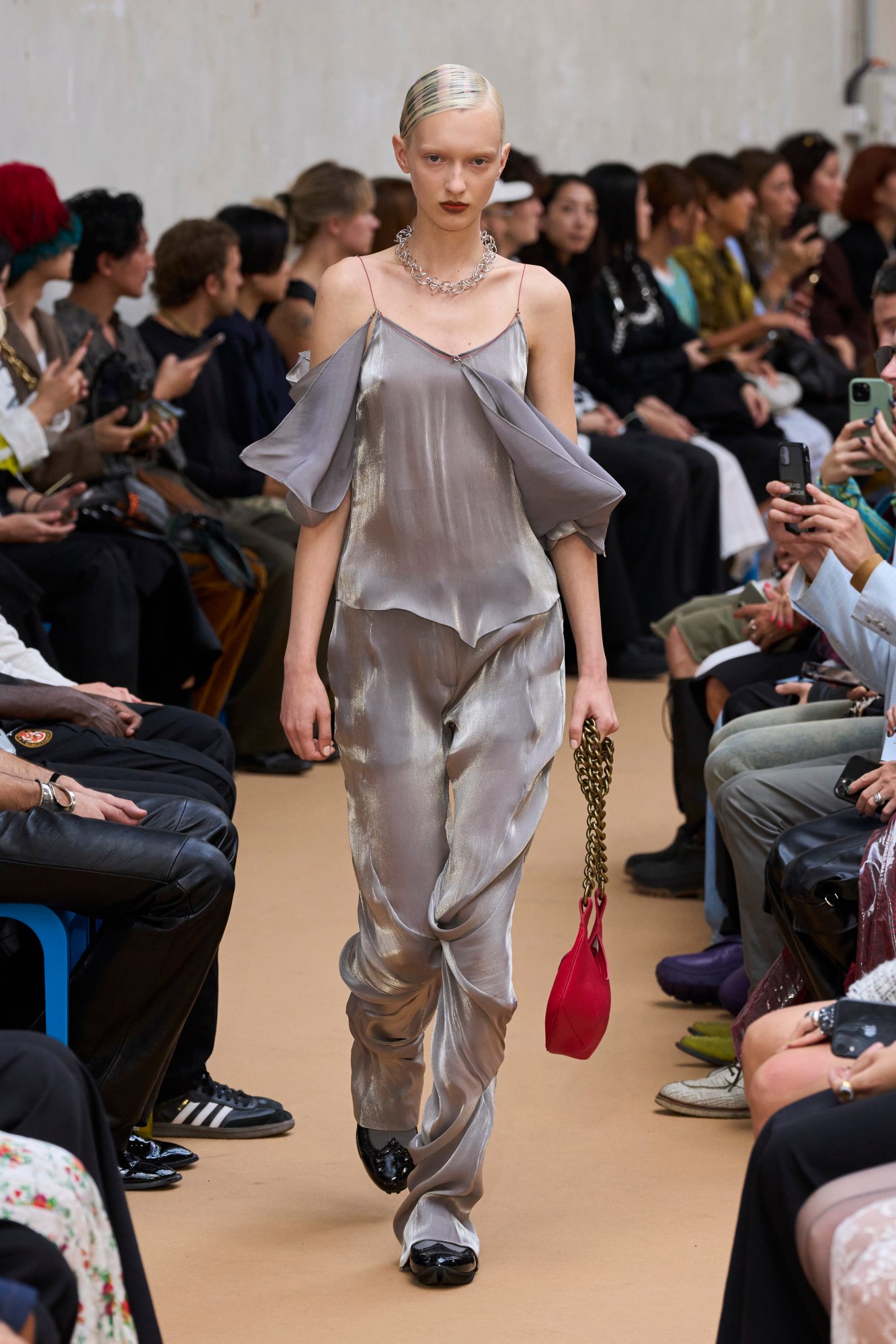
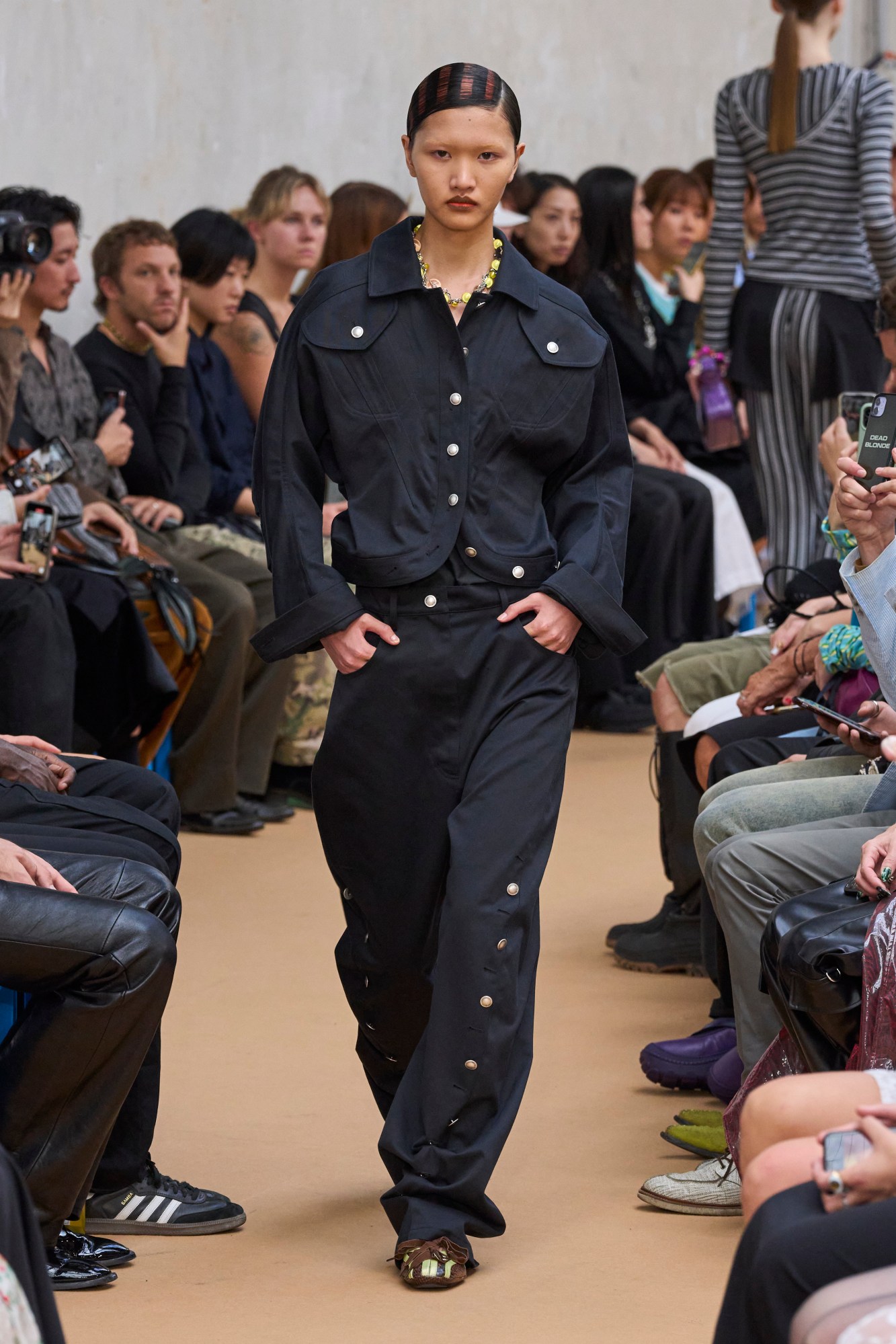
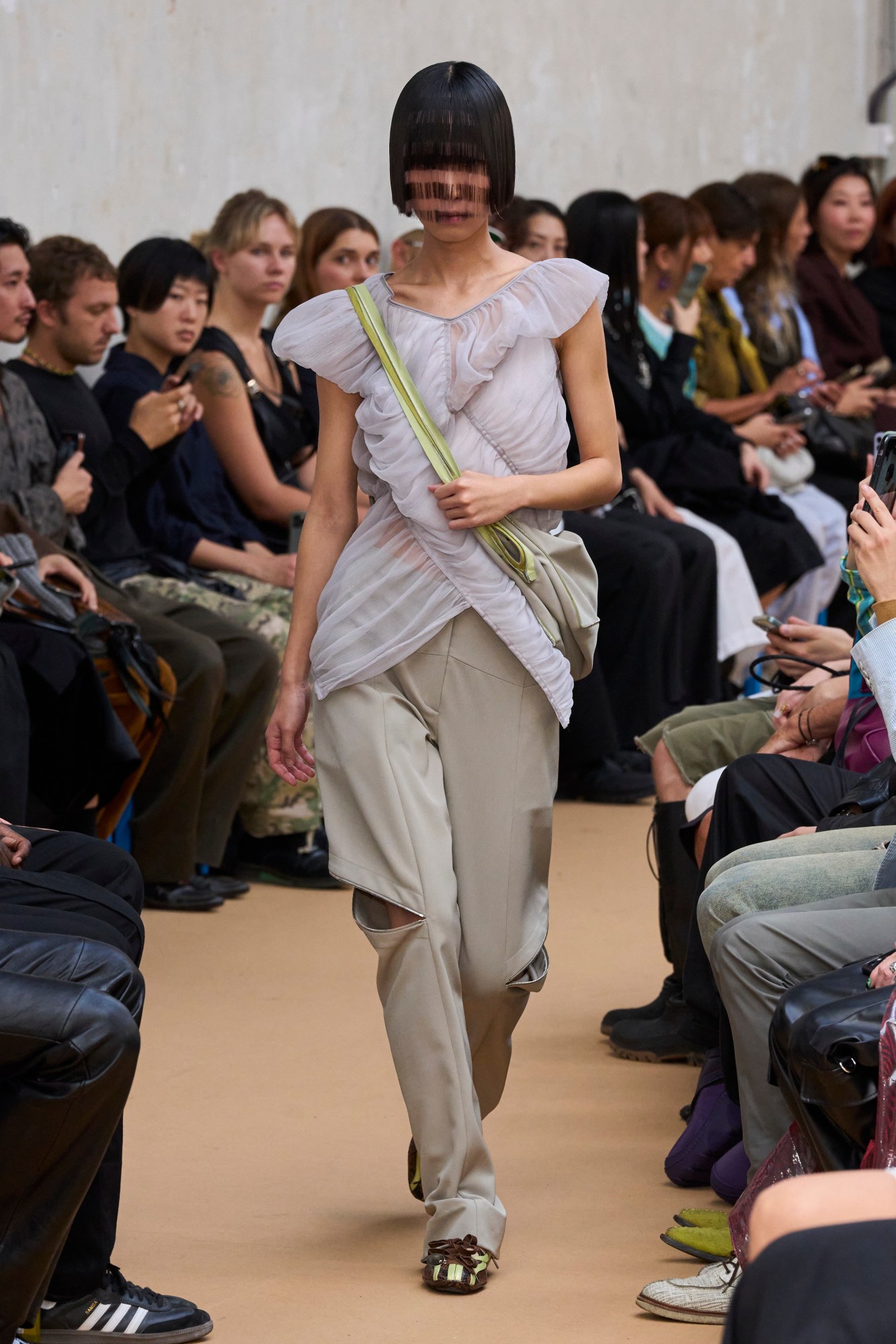
Kiko Kostadinov
There are a handful of style codes that have come to define Kiko Kostadinov’s womenswear, designed by Laura and Deanna Fanning – textured accent fabrics, slightly off-kilter shapes and silhouettes, the use of two-toned, complementary colours – which overall have created a cult, whimsical aesthetic. As if this wasn’t indicated by the stylish crowd at their SS24 show at the Palais de Tokyo this season, it was seen in their dress – the green tulle trimmed tops and drop waist dresses, ruched rainbow knits and even the twist-tied beanie hats of collections past. To build upon such a carefully, considered aesthetic the designers indulged the curiosity that feeds their creative process by exploring “the forms and functionality
of antique lingerie” the show notes read. “The hidden layers of undershirts, knickerbockers and petticoats of yore that created a support system for women below their heavy gowns and mantles.”
We see this interest come alive in the first few looks – delicate silk off-the-shoulder tops and slip dresses, inside-out trousers and thermal style knits. Later on, we see the garter time tops they’ve become known for, in shades of grey and peach, though for SS24 they’re worn over matching cotton bloomers. A lovely ruched, bubble top and mini skirt, as well as a pointed cape-like, panelled cardigan and skirt play with the transparent layers typically seen in lingerie, and undergarments at large, revealing slices of skin here and there.
However, the collection isn’t as much about revealing the body, in all its shapes and forms, as it is experimenting with it through the use of various fabrication techniques – “that gently scoop, shroud and deflect off the body to create uncanny proportions, romantic expressions and clothes with an unapologetic verve,” they continued. When the designers do go for slightly more traditional silhouettes, often in the outerwear, an oversized zippered bomber or broad-shouldered, seamed jacket with rounded trim, for example, they don’t miss either. Not to mention the new “bowling/driving/ballet” shoe – in shades of bubble gum pink, light green and grey black, it’s no wonder you’ll need the full look. ND
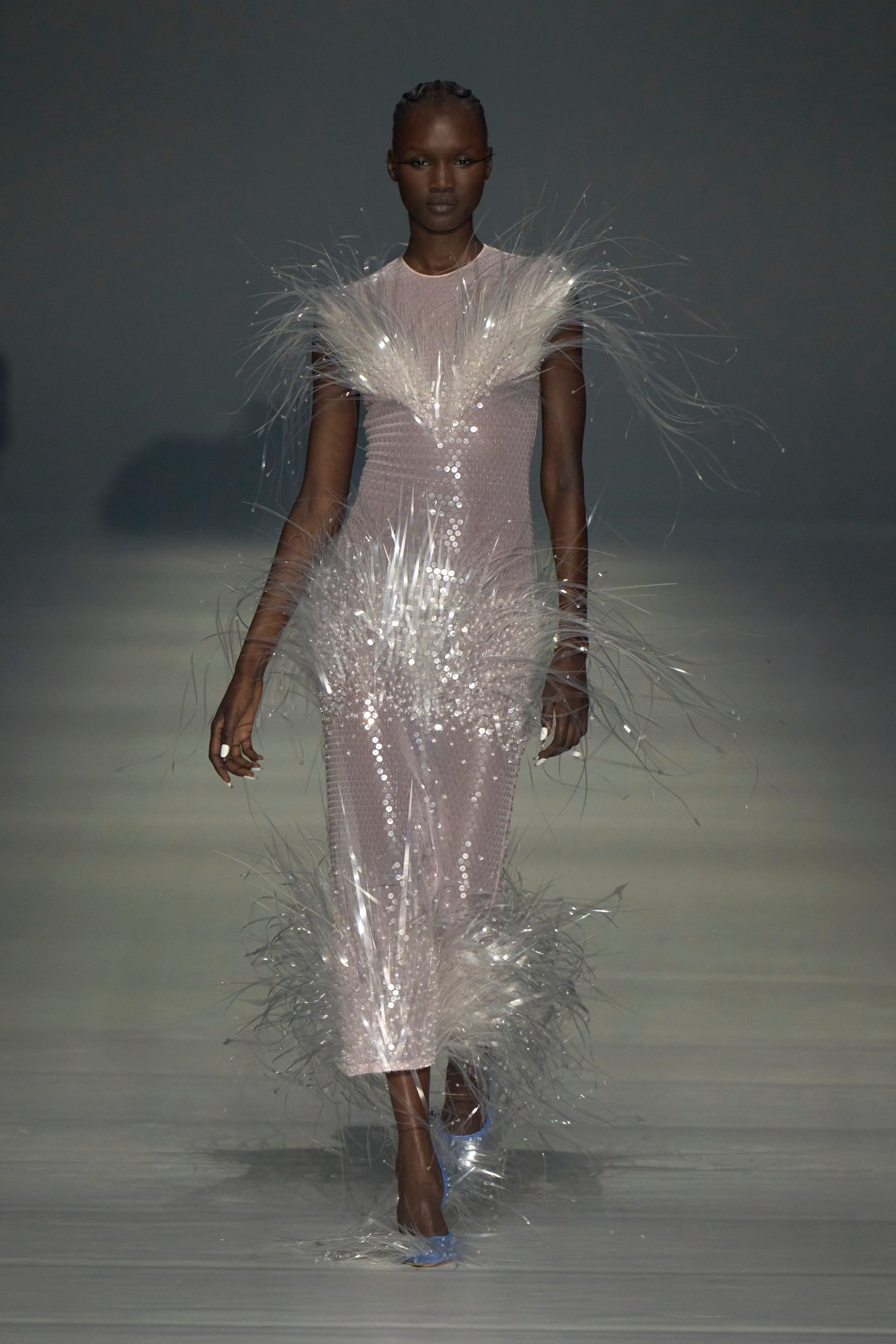
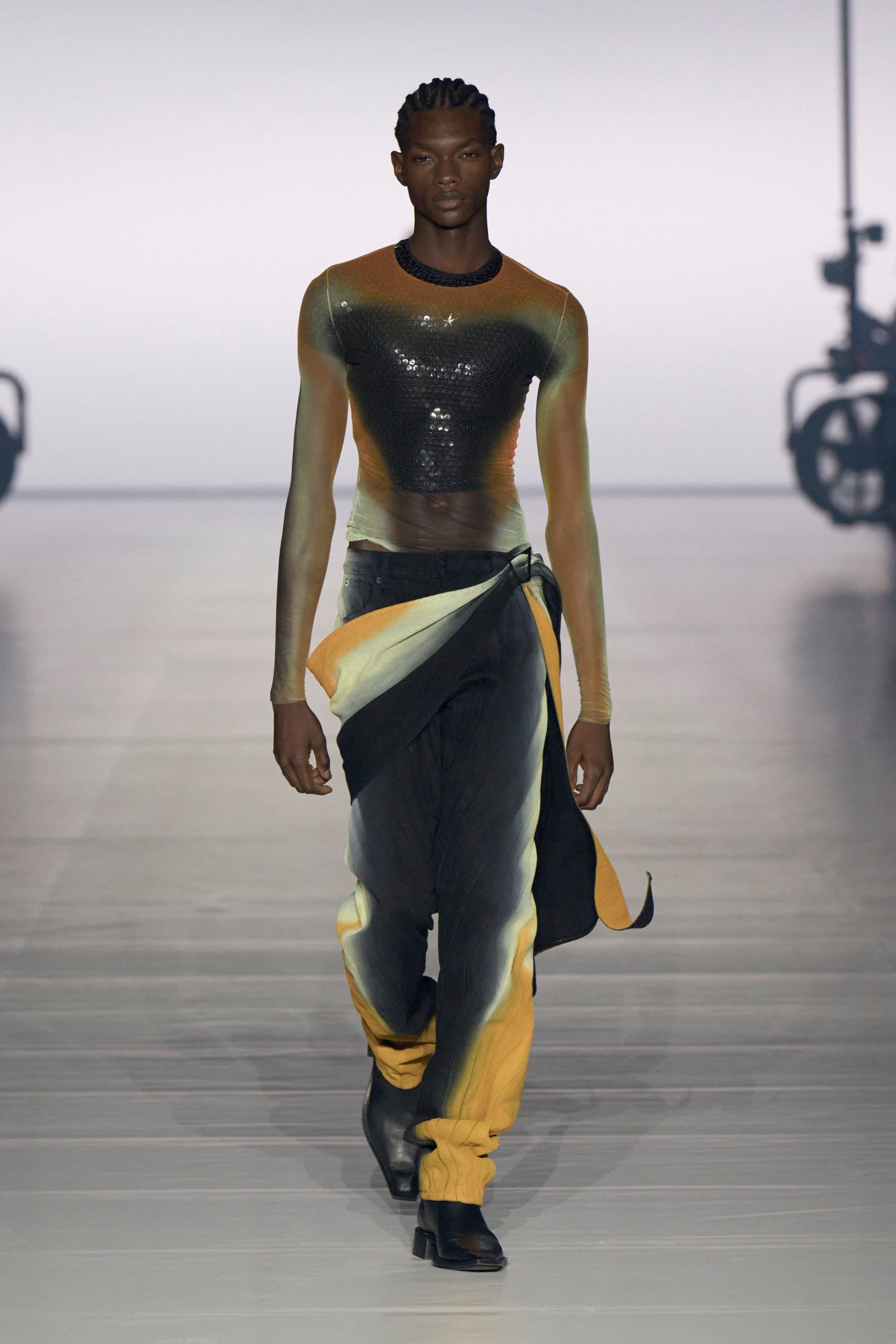
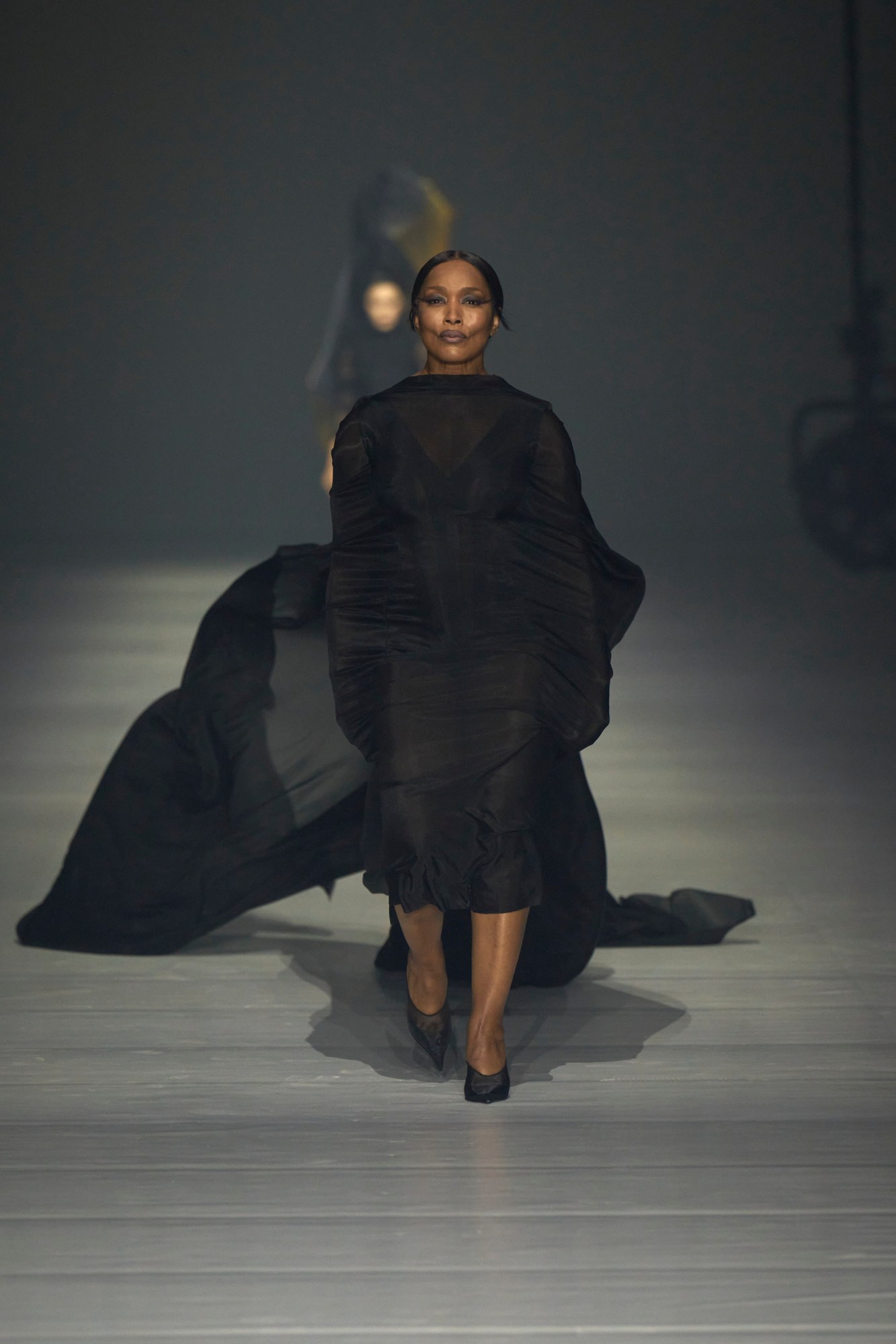
Mugler
Review to come.


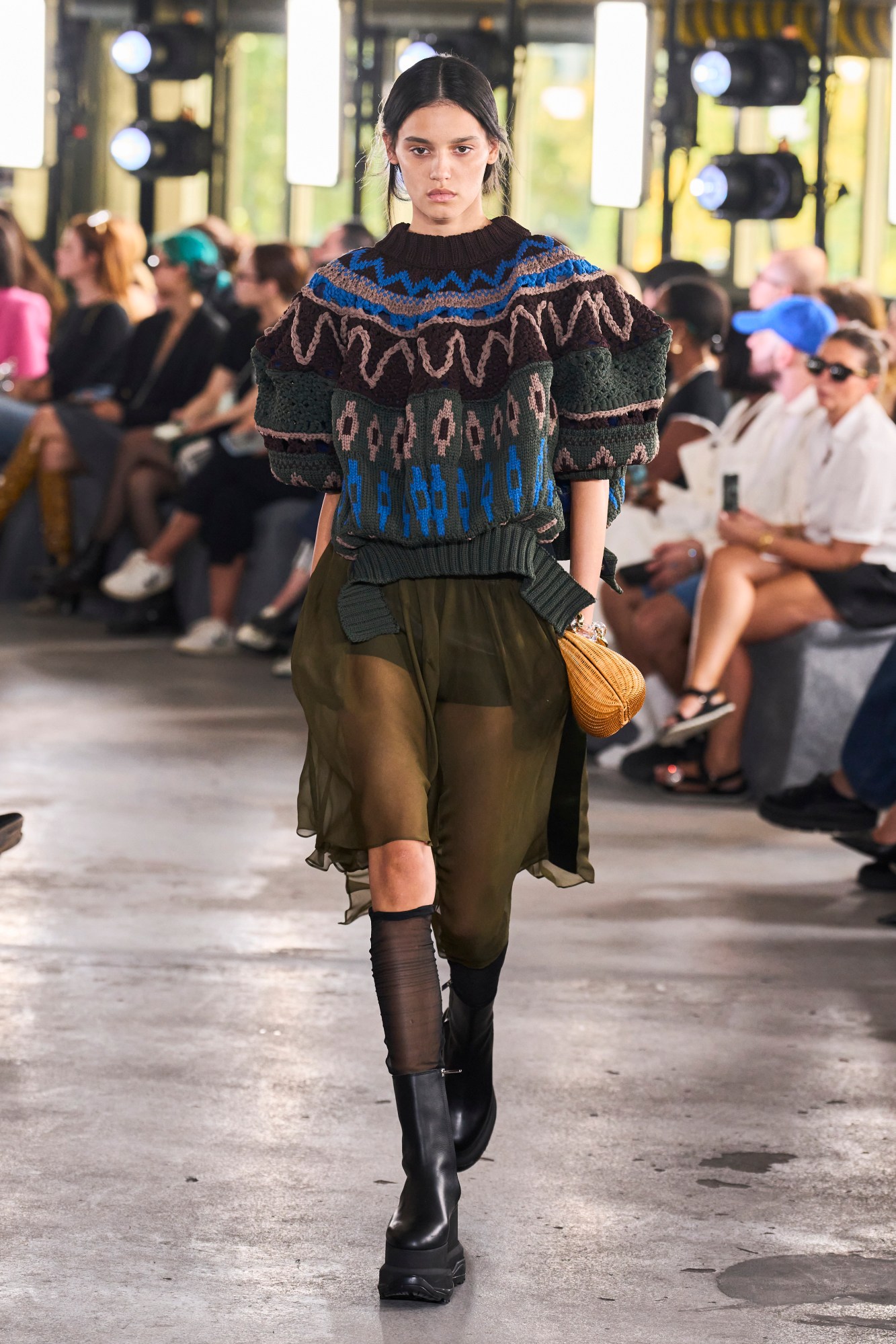
Sacai
Ever since she founded Sacai, Chitose Abe has been creating garments through hybridisation – fusing together knits and shirts, shorts and pleated skirts, etc. – in a way that has become uniquely her own. For SS24, however, the founder and designer decided to pare it back ever so slightly, by utilising her signature, mostly neutral colour palette and focusing on a few key silhouettes. She explored the idea that “The more simple we are, the more complete we become,” the show notes read.
The tailoring was cropped and the pockets slit, for the most part all sans hardware; button up shirts were without exposed buttons, still they held a circular, curved shape that drew the eye. Look closer, especially at the outerwear, denim separates and swing dresses, and you’ll see that they become gentle cocoons or balloons around the body – the circular pattern cutting giving each piece a rather rounded, sculpted look. It was only as models walked down the runway or turned the corner that you could see how truly voluminous this technique made the sleeves and shoulders, how far off the back and chest the garments sat. This gave them movement as well, in a way that even the photos don’t really do justice, and the layers provide an added sense of fluidity amongst the structure. A sphere-like fair isle sweater is worn over a sheer chiffon skirt, while fringed skirts poke out from under suiting. In all its minimalism, this very wearable SS24 collection sees Sacai flirt with a less is more sensibility, however, as we’ve come to know this doesn’t apply to the impeccable construction. ND

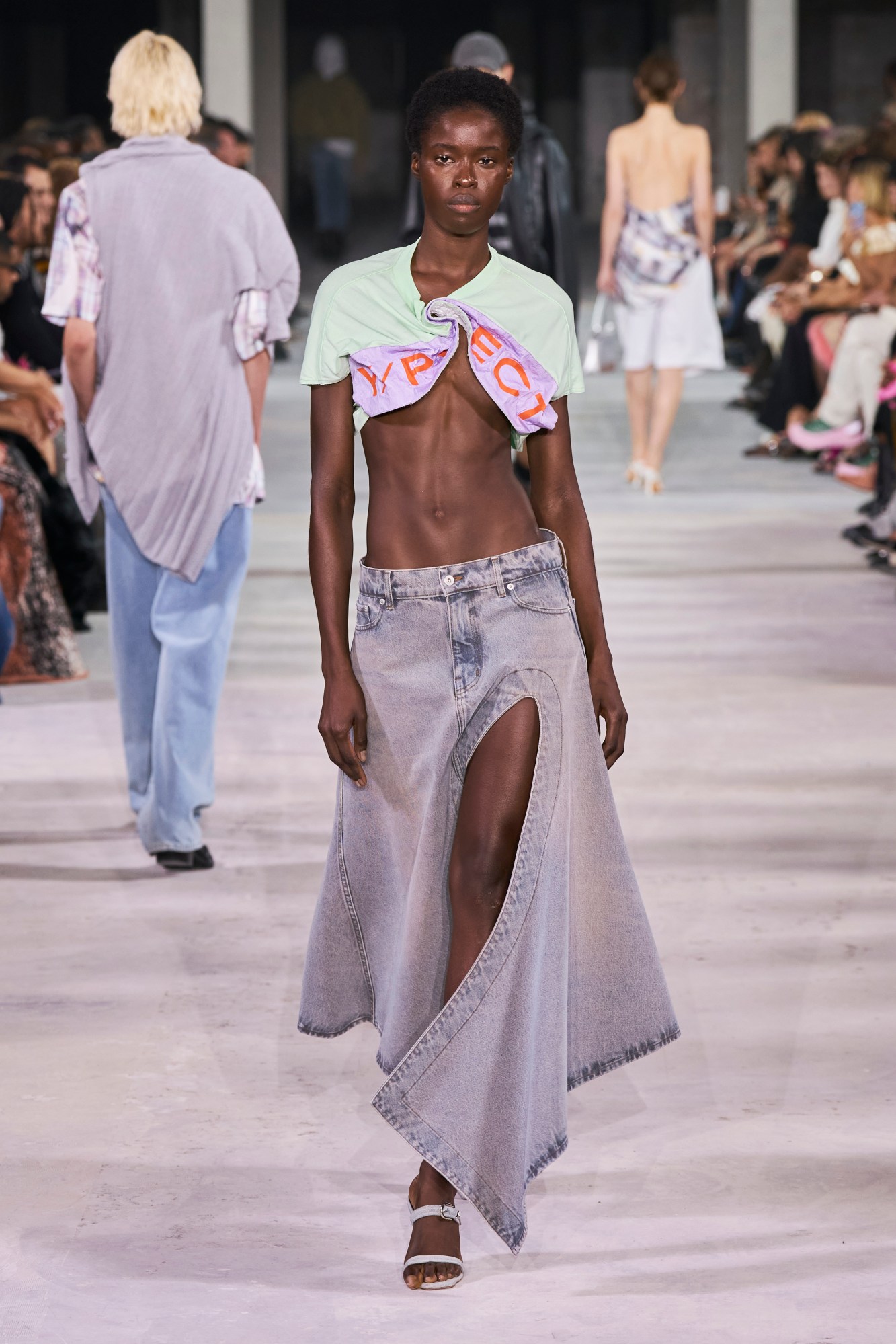
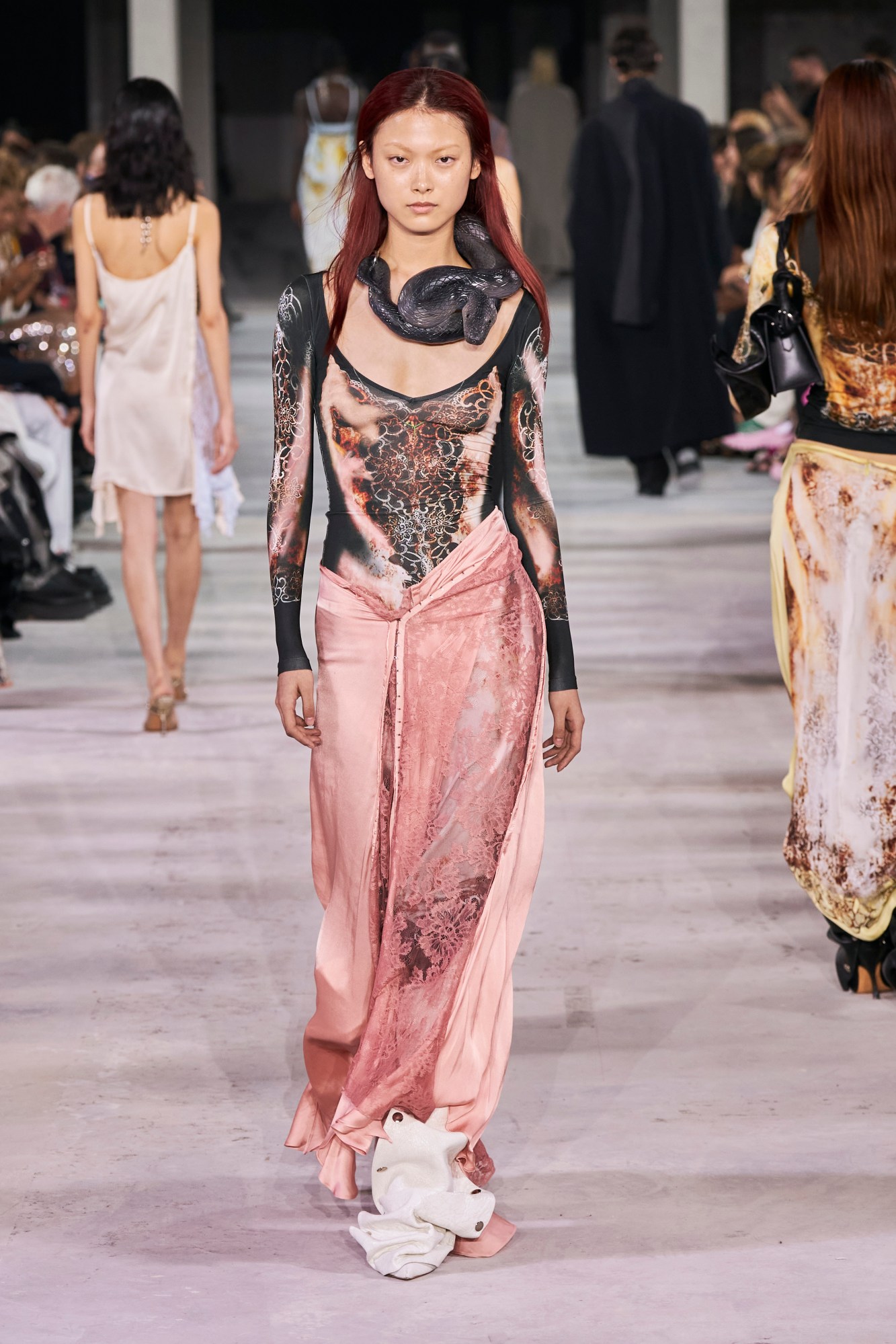
Y/Project
Glenn Martens has lived in Paris for nearly 15 years and though he may be further from his hometown of Bruges, living abroad means he visits more often. There’s an even deeper appreciation there, a yearning, and a connection, which has been fueling his designs over the years, and has more directly inspired his SS24 collection, presented to much fanfare in Paris on Sunday night.
An oversized hooded trench, haphazardly buttoned up the front, featuring hook and eye details, referenced the Dukes of Burgundy, their caped and capped visages often carved into doorways of Bruges’ many Mediaeval buildings. Cropped logo tees were twisted further up the mid-section to whirlpool across the chest and elongate the body; and even the jacquards of the knits and striping of the tailoring went vertical. “I really kind of envisioned it as Gothic towers in the middle of the Belgian fields,” Glenn said of this season’s silhouettes backstage after the show.
SS23 was replete with Y/Project’s signature button closures and zippers, playfully inviting the wearer to customise their look – the styling proposed khaki bombers that unzipped up the front, baggy shorts unbuttoned at the waist, perhaps even layered over a more structured pair; soft leather jacket sleeves can, and should, be tossed over the shoulder like a scarf. Similarly, silk sleeved collars topped blazers, shirt dresses and coats elegantly twisted around the neck, but the standout pieces were the collections final looks — a series of structured jeans and Oxfords, rippled and wind blown into spirals, and pink and blue-green gowns, the iridescent silks tossed about so thoughtfully that the models looked like sculptures moving down the runway. ND
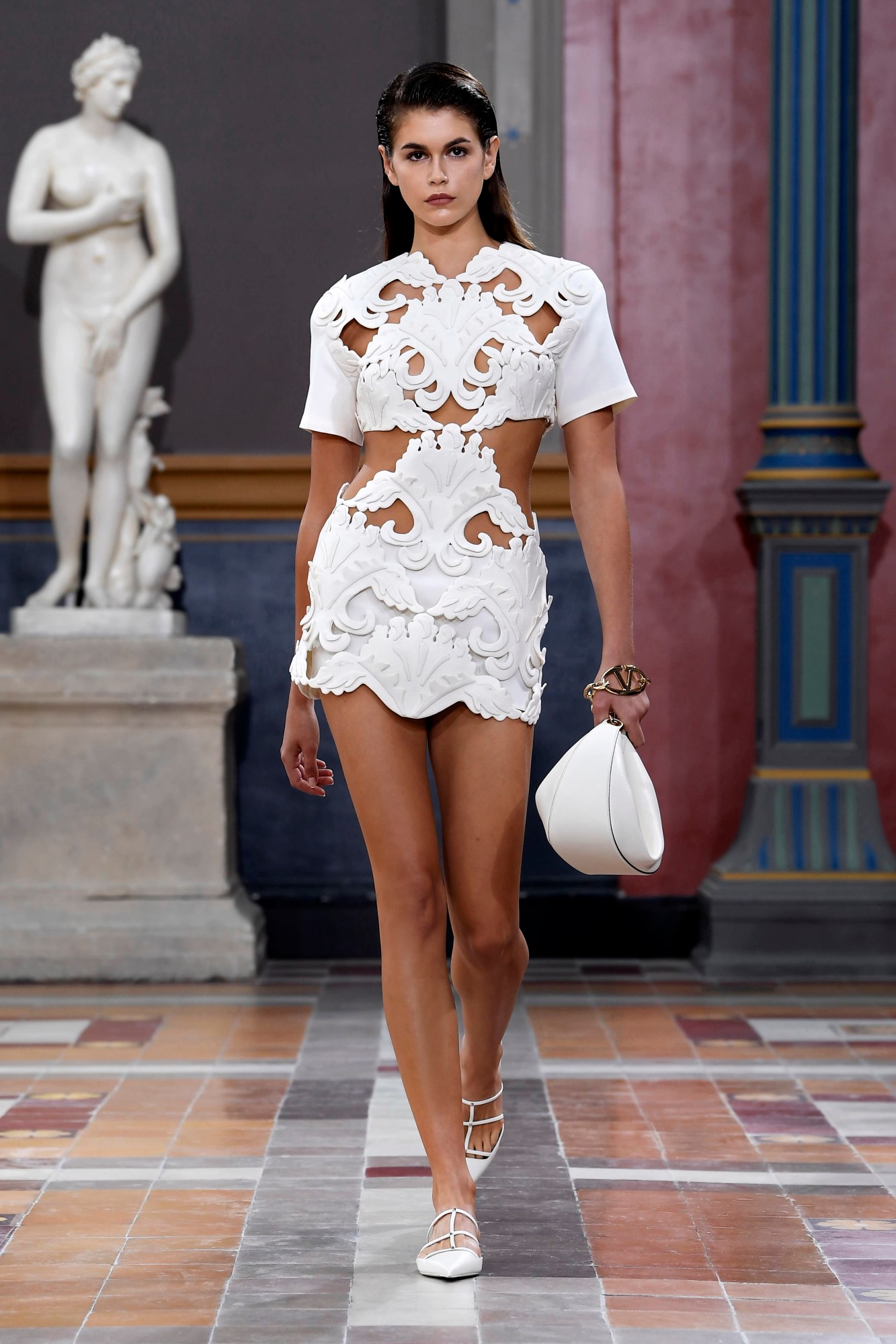

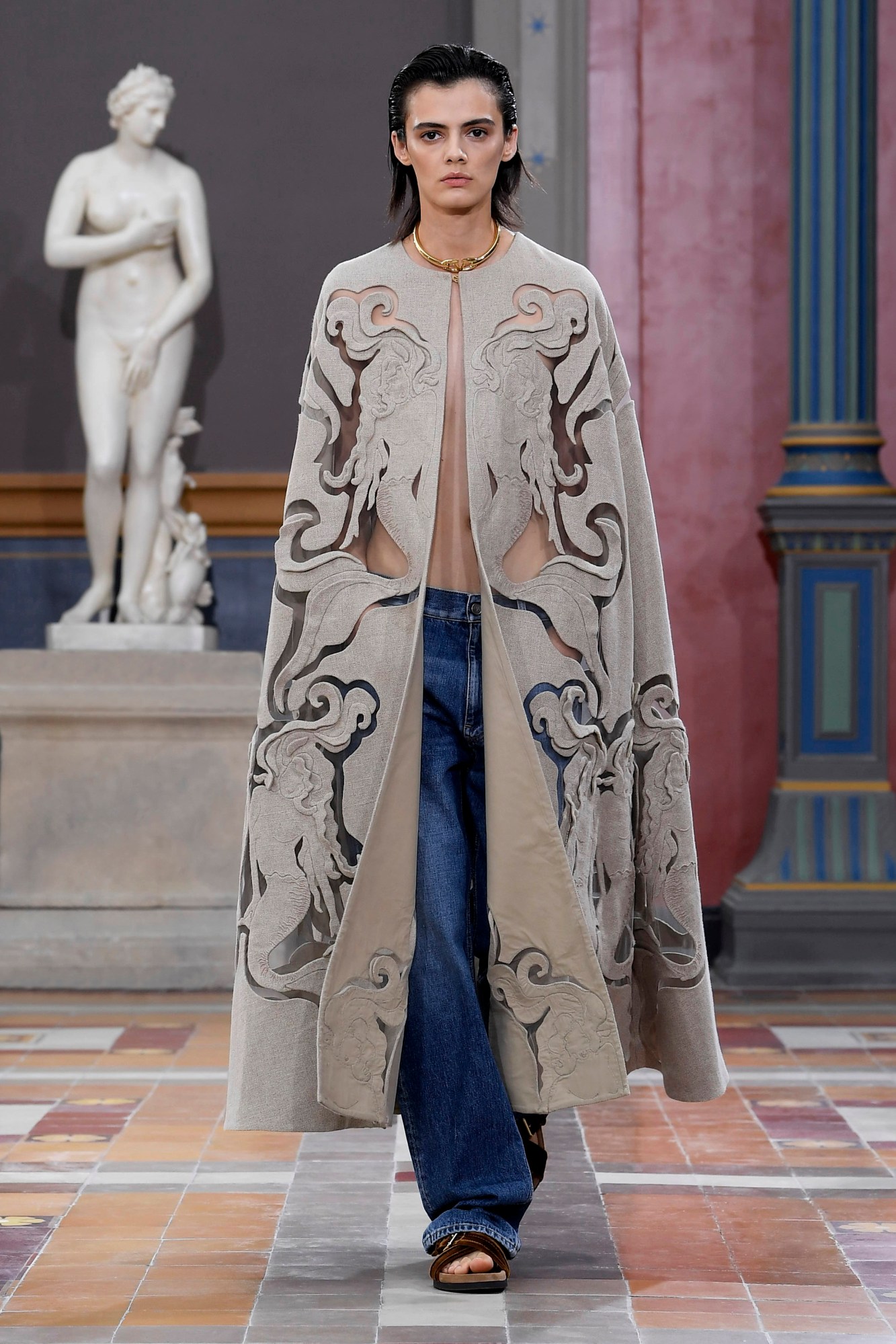
Valentino
Review to follow.
Balenciaga
“I don’t believe in this kind of perfect, polished beige angora world,” declared a hoodie-cloaked Demna after his SS24 Balenciaga show. “I can’t repress my creativity. I can’t castrate my vision. I just can’t do those things. It’s not me. So this collection is a celebration of everything that I love about fashion.” One thing he wanted to assert is that, for him, fashion is not luxury. “I questioned a lot: ‘What does fashion do for us?’ Because for me, I mean, I must be honest, I don’t care much about luxury or the whole idea of it — because I don’t want to give people a proposition to look like they’re rich or successful or powerful. My fashion works from down up, and not from up down.” Read the full review here.
Hermès
Hermès shows are always an oasis of calm during the maelstrom of Paris Fashion Week, the sartorial equivalent of ASMR. This, after all, is a house that has been doing Quiet Luxury for almost two centuries, its products so self-assured in quality and timeless design that it needn’t create a spectacle in order to spell it out to the world. Instead, the show space at Garde Républicaine was transformed with mounds of real reeds, grasses and wildflowers (all will be replanted in various projects after the show, the house noted) that suggested that whereas other houses need to create complicated set-ups and contrived narratives to convince customers of their worth, the concept of luxury at Hermès luxury is simply au natural. Read the full review here.

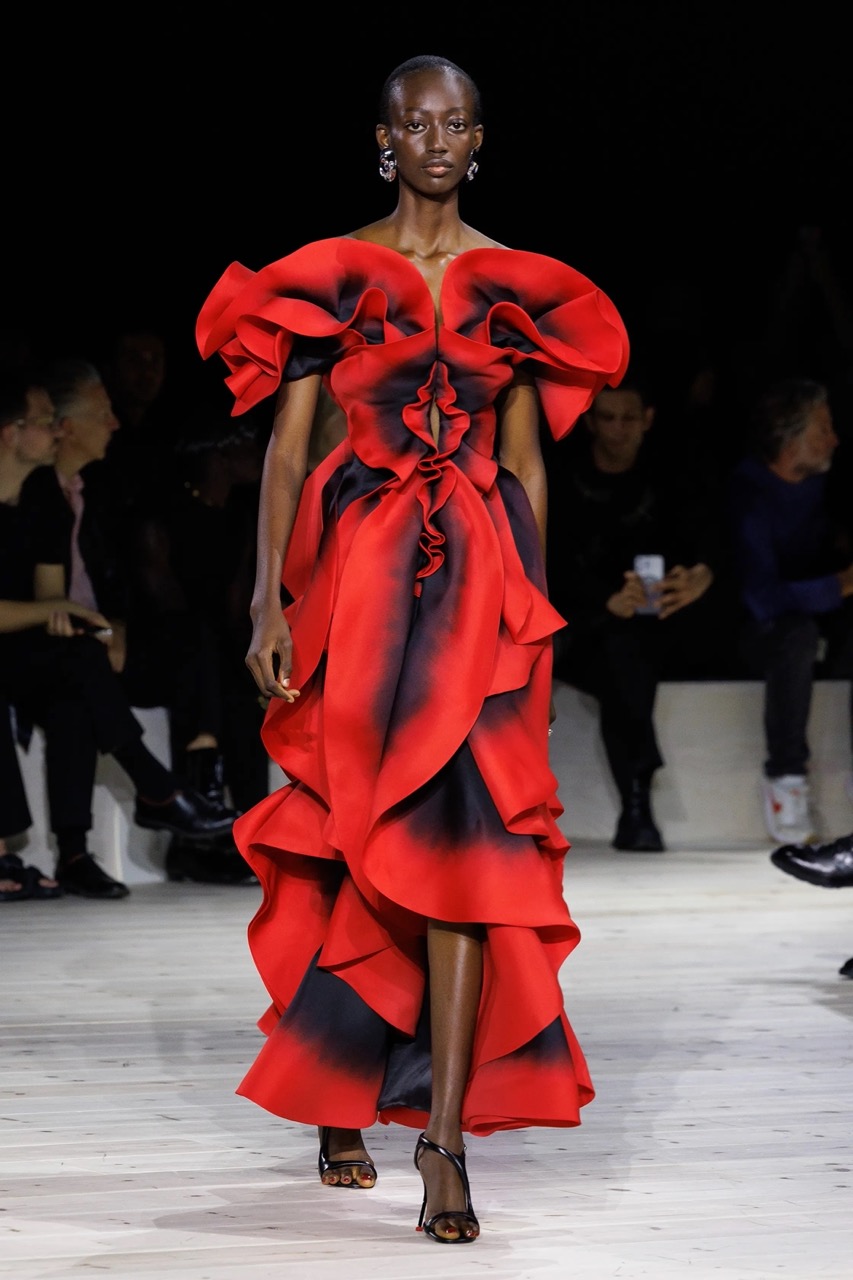
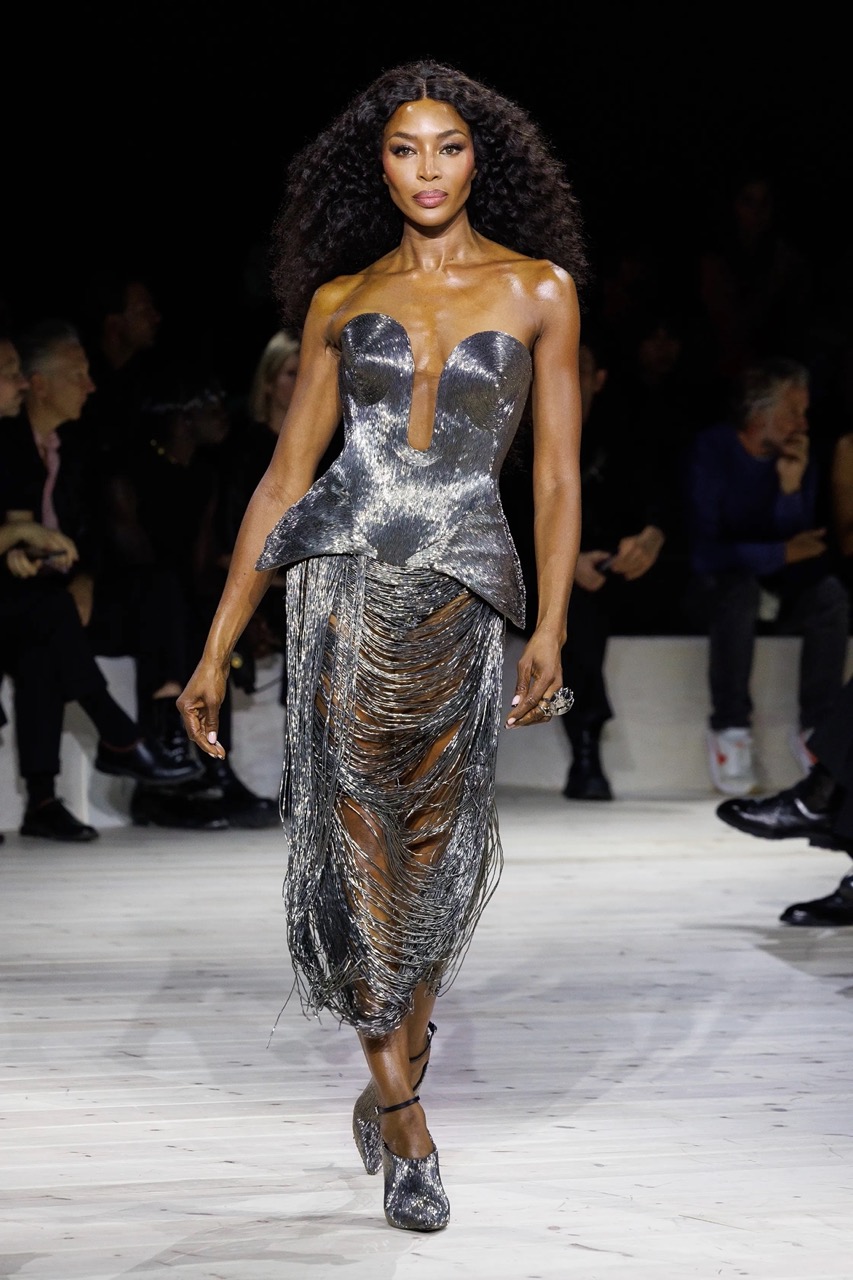
Alexander McQueen
It’s with wet eyes that the fash pack bid farewell to Sarah Burton, the Cheshire-born perfectionist that has helmed Alexander McQueen since SS11. Indeed, Sara is a McQueen lifer, first joining in 1997 and rising the ranks from there. Throughout her tenure, she played a pivotal role as both the late Lee McQueen’s trusty sidekick and also his honourable successor, keeping his fascination for old England and the British countryside enclaves alive while evolving his chaotic Londonisms into something less concertedly dissonant. Today, that legacy was felt by everyone in the room, not least a tear-wiping Naomi Campbell, who closed the show.
Standing as the high-femme riposte to Lee’s grittier perspective on womanhood, Sarah has defined the most commercially successful era of McQueen. SS24 looked set to follow in the tradition she established. Here, power-shouldered overcoats, nipped and seamed at the waist and outlined with bras, felt honest rather than provocative. Bodiced hardware in English rose red plunged to the navel before splaying across the hips like panniers. This was power dressing 2.0. In fact, such boldness was a fil rouge, manifesting in slinky columns printed with David Sims roses or raw-hide skirted suits and chaps, complete with peaked lapels and jutting sleeveless shoulders.
Sarah might do drama, but she’s never been one for prissiness. As such, even the most romantic designs, such as the petalled shoulderless evening dress, were hardened with a dark, if not macabre, edge. Flowers blackened at the centre or, in the case of one tailcoat and trouser ensemble, bled at the edges. Elsewhere, gowns literally gushed with red tassels, emerging from anatomical illustrations or flocked textiles. Of course, the show’s homage to the late Lee was apparent in such dissected, ruddy visions of femininity.
That said, her own Burtonian touches held fort, also. Tailoring – etched away along the flanks or drop-cut across the shoulders and teamed with contrast-stitch welts – spoke less of the exquisite hot mess Lee had presented and more of a femme fatale. Take, for example, the bar jacket template rendered in leather and laced along the sides. Not only could this be worn with confidence and prowess, it also ditched any of the overtly objectifying cues Lee purveyed. This woman was sculpted in its maker’s likeness, not to a man’s skewed ideal.
It’s hard to believe now, but the original McQueen label wasn’t anywhere near as wearable as the iteration Sarah leaves behind. In many ways, Lee’s McQueen was an art project, funded by his gig helming Givenchy, without any concern for cash cows. Under Sarah’s guidance, it’s become one of the hottest names in any department store, racking up sales across among monied internationals perusing Harrods and Selfridges or at McQueen flagships worldwide whose clients are often seen at the shows alongside industry insiders. That it still feels just as distinguished as Lee’s McQueen, is, however, her greatest legacy. She made it sell, without selling out, and that’s quite the gift to honour her late mentor. JB
Comme des Garçons
“To break free of the gloomy present, I hope to present a bright and light future,” read Rei Kawakubo’s single-line statement accompanying her SS24 Comme des Garçons show. It’s a simple message that came through in the refreshingly concise collection of 19 body-defying wearable sculptures, each one turbo-charged with a rainbow of colours, and swaddling masses of fabric. Some of them looked like they were constructed from children’s bedspreads, others came with printed collages of Regency-era portraiture resembling camouflage, wrapped up in big bows — perhaps a nod to the cumbersome (and equally restrictive) silhouettes of the eighteenth-century. Look 16, with its giant red collar, red ruffles and warped polka skirt, seemed to resemble Minnie Mouse. And almost every look had flashed of Barbiecore pink, exaggerated on some with swirls of kitschy ruffles. The trainers and boots worn by every model were covered in découpage of saccharine stickers and bright, fizzy childlike objects ostensibly glue-gunned onto every possible surface. Looks were rounded out with neon-bright wigs, some of which were completely solid blocks of rubber, and others hand-painted as if a little girl had decided to give her doll a makeover. Read the full review here.
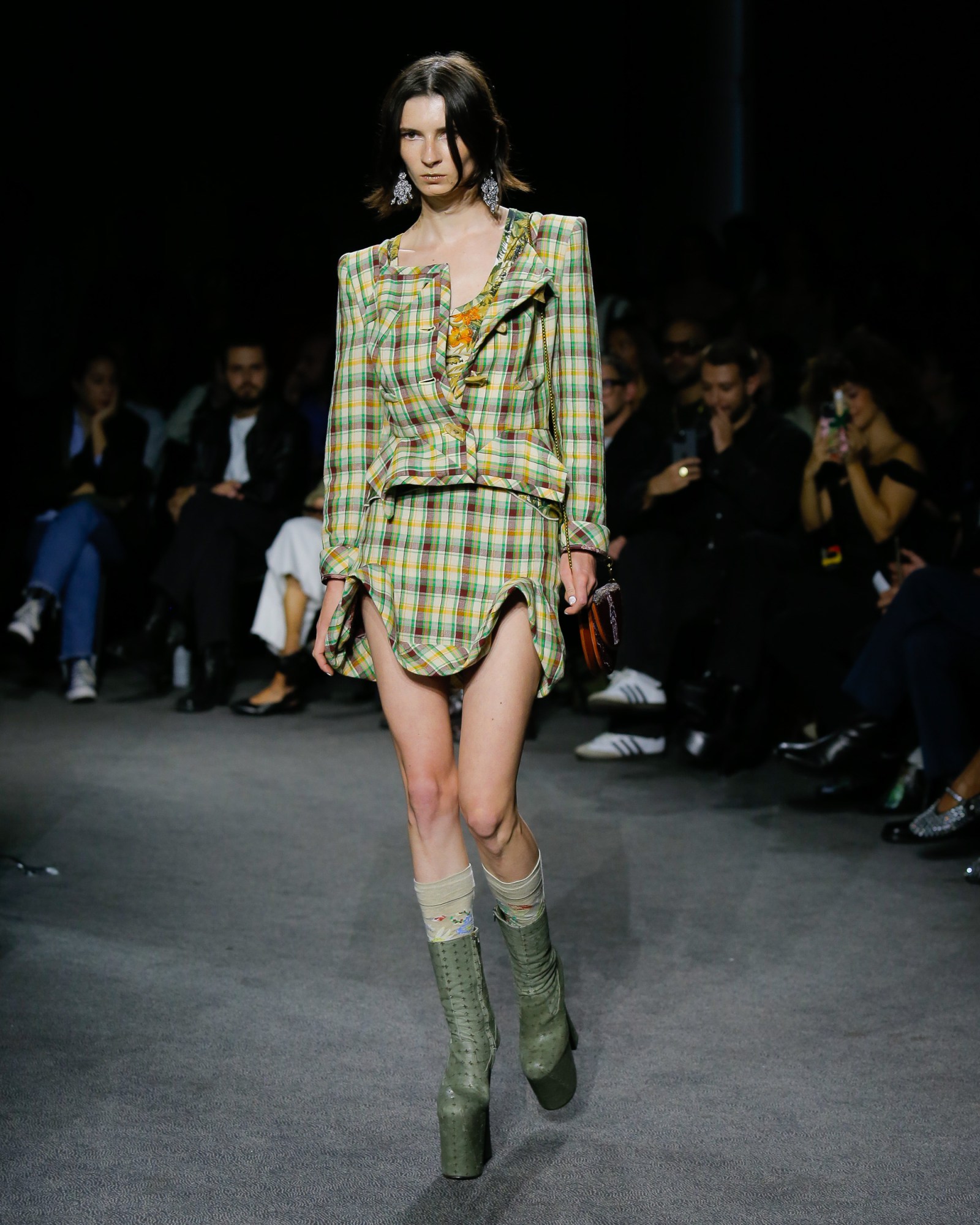
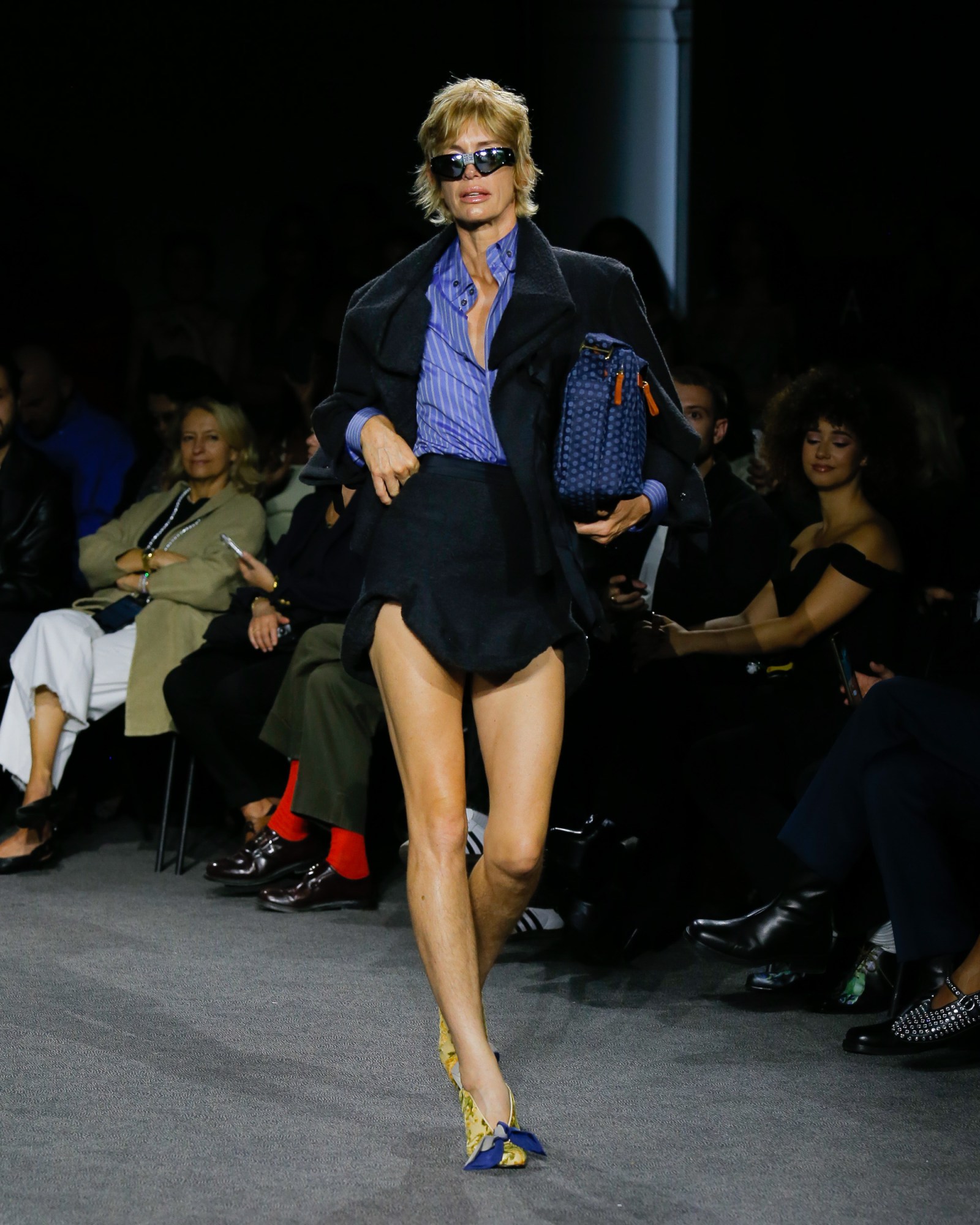
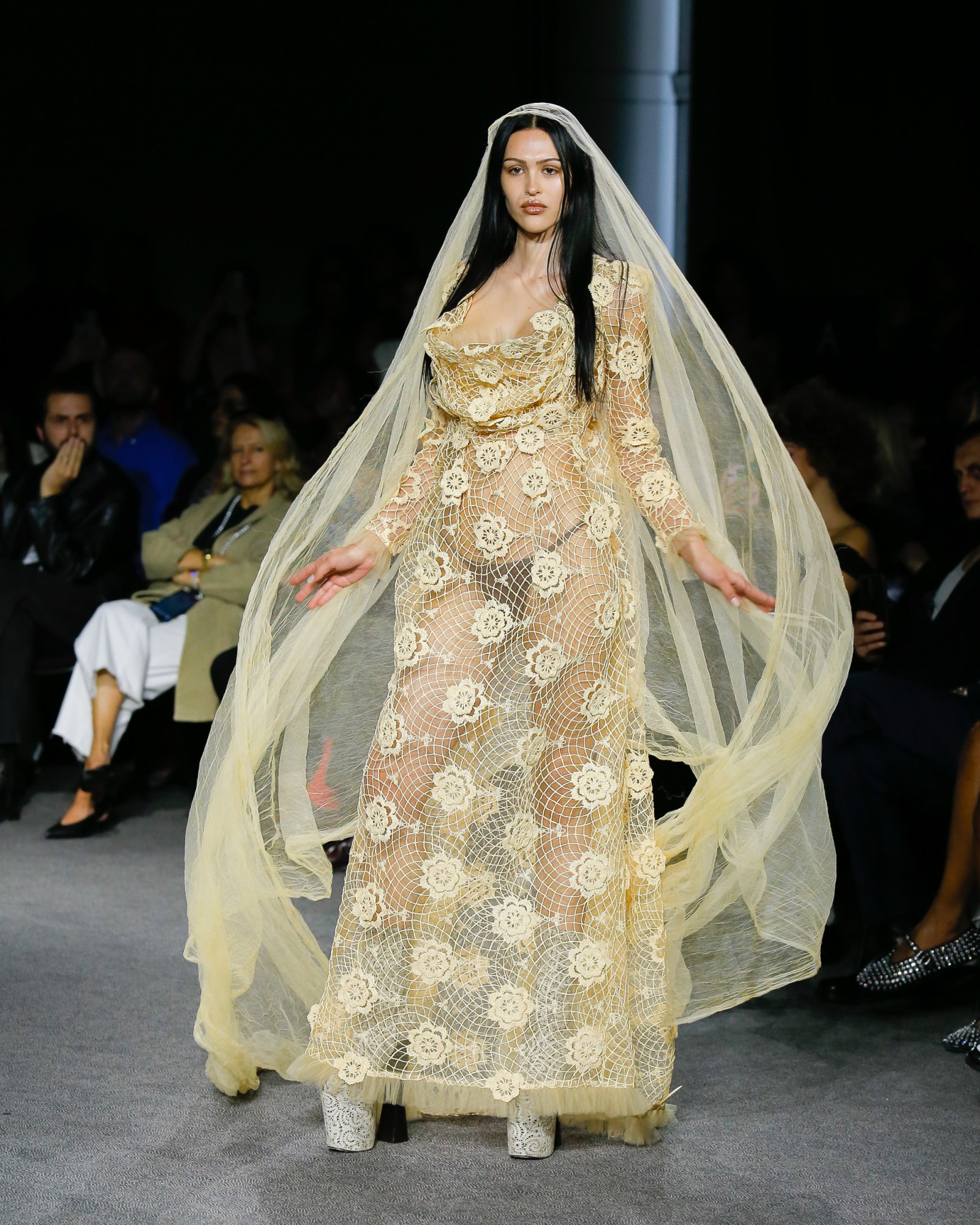
Andreas Kronthaler for Vivienne Westwood
Over the past few days, Andreas Kronthaler has been sharing some rather iconic images of his late partner, the inimitable designer Vivienne Westwood, on Instagram, wearing the house’s archival designs – a rose coloured minimalist silk set from AW03/04’s ‘Le Flou Taille’ collection, on the front lines of a protest in SS14’s ‘Everything Is Connected’ T-shirt and linen cape, a striped and checked ‘Blue Sky’ SS04 patchworked dress and her signature, brown corduroy suit designed for ‘Exhibition’ AW04/05. “Loved the way she dressed. Always the opposite of everybody else,” Andreas wrote in the show notes for his latest collection. “Wore things until they fell apart – her corduroy suit which she wore over 20 years constantly. A great mender, always done in bed – never wasted anything.”
Inspiration for SS24, which he called ‘43 Old Town’, struck when Andreas began organising Viv’s personal collection and decided he’d reimagine 40 looks for the now, starting first with the suit – done in a pale violet, both solid and striped, spliced together and belted for relaxed, everyday wear. Then there was a green and brown plaid set pulled open, the skirt hem slit up each side and cheekily ruffled, that was inspired by ‘Tied to the Mast’ SS98, and a teal, silk jacquard dress that took inspiration from AW09/10 was topped with a taffeta bow bonnet, its long tendrils trailing the runway.
Set to live drums, there were a handful of excellent tailoring moments — a broad-shoulders 80s skirt suit set that cinched in dusty evergreen, boucle blazers and waistcoats with lop-sided collars that looked like fallen hoods — none of it being too serious. And the crowd audibly gasped when Amelia Gray walked out in a draped, floral raffia lace bridal look straight out of ‘Storm in a Teacup’ SS96, not long after Irina Shayk in a white silk moire, corseted gown. Though references abound this season, perhaps more houses should follow Andreas’s lead — in looking to the past, to some of Vivienne Westwood’s most lived-in, most beloved, designs, the designer created a playful collection that feels both true to the house, and to its future full of promise. ND
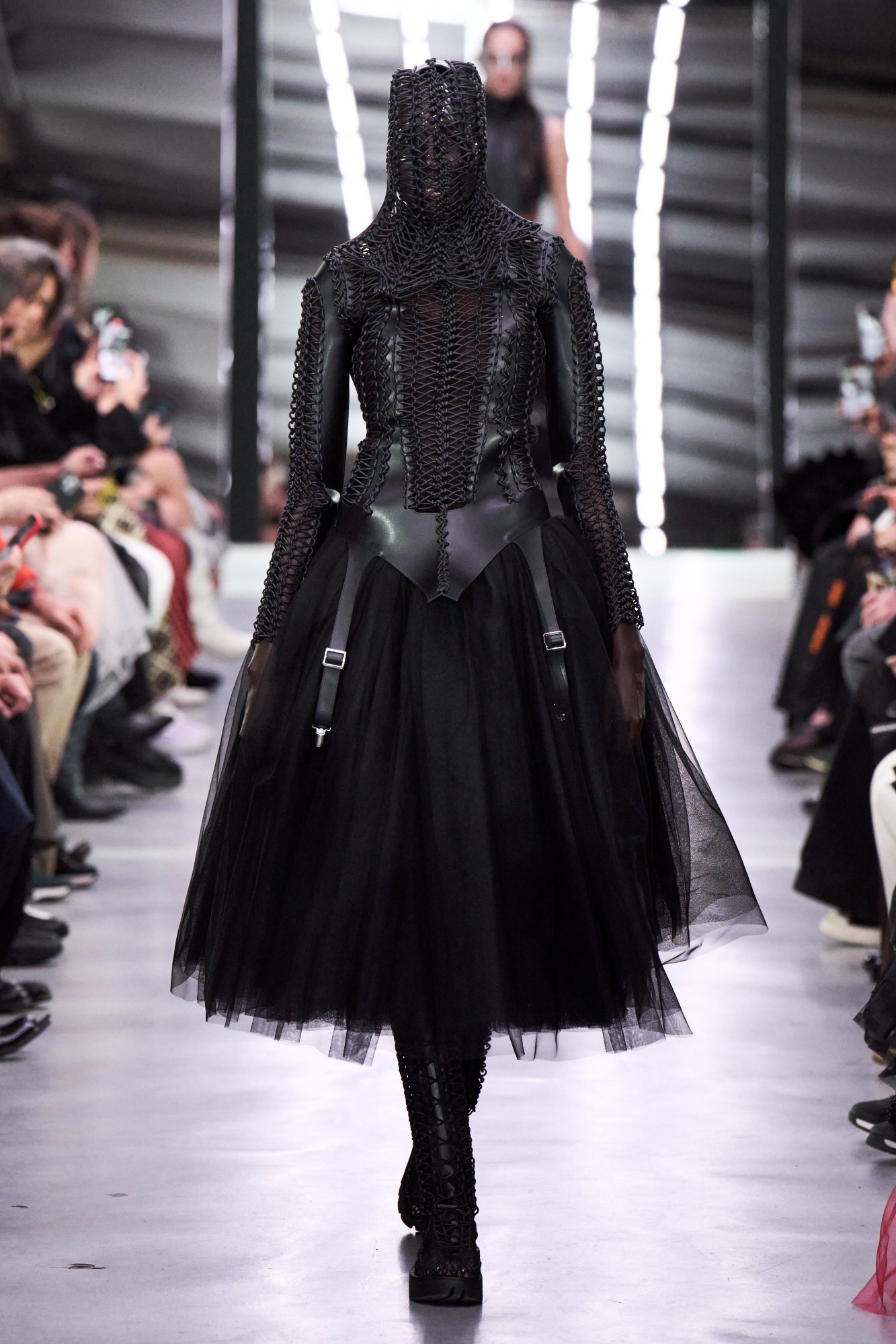
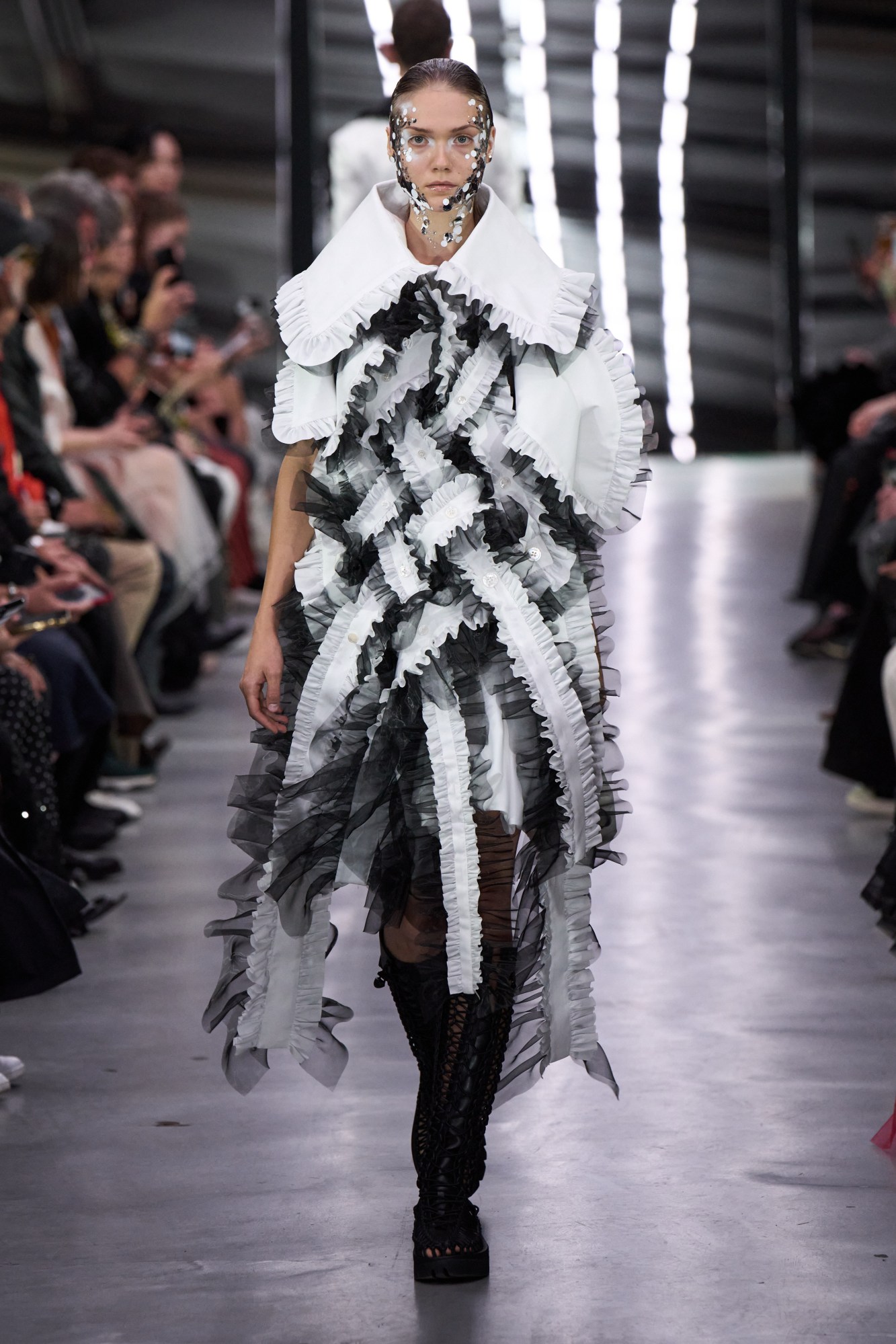

Noir Kei Ninomiya
Hot on the heels of Junya Watanabe and Yohji Yamamoto’s monochrome offerings, the aptly named Noir Kei Ninomiya presented the second and penultimate show of ‘Comme Day’. Sticking to the black-and-white theme – quel surprise! – the Rei Kawakubo protégé who cut his teeth pattern cutting for CDG, served up a mystical medley of puffball frocks and gothic lolita occasionwear. Set to a squelching alien soundscape that slipped from IDM to acoustic strums and orchestral symphonies, the catwalk came alive with extraterrestrial models, dripped in mercurial blobs across the cheekbone and sternum.
The familiar dandelion silhouettes of Noir were present in abundance, yet even more intricate than before. With black frosted tips, one dress (if you could call it that) obscured the face completely. From afar, the dandelion seeds appeared as if floating, but closer inspection revealed they were held in place by clear, laser-cut acrylic. Below, woven-leather knee-highs finished the look, pitting a cruel punk sensibility against the lighter, airy-fairy fluff. Of course, this play with juxtaposition, a running thread among the Japanese designers this week, was an integral part of the collection.
Certainly, it explained his palette. “I use the example of white paper, when you write in a black colour,” he said backstage. “If you ask, what colour is it?, you would answer, black. That’s how I made the collection.” It’s almost laughable that such a simple soundbite could underpin such complex garments, but therein lies the takeaway. Rather than leaning into weighty concepts, he instead flexes his craft, presenting what could pass as couture without the stuffiness. This refined and uncompromising vision is why he shows under the Comme-brella. No doubt, he knows the consumer base for elderberry dresses that bounce like shrubs in the wind is limited, but that’s beside the point. That small niche wants only the most directional designs and knows that he’s one of few providing it.
At times, some of the clothes verged on the visceral. That frou frou column dress, replete with venus fly trap florets, and the wired body bubbles akin to bionic suits were a lot to take in. As were the laced-lattice leather crusader ensembles, obscuring the faces and sticking to the hips like rubber-suction suits. Kinky. Elsewhere the suspender trope, used to form netted slip dresses or cling-on tennis skirts, added an out-of-joint masculinity to the delicate tulle confections and ribbon-bowed ruffs. Again, it’s that contrast. The broderie anglaise floor-grazers, matronly but sweet, were offset by fringed-tassel brothel creepers. Polar white, jet black; walking bouquets; fetish gear; ruffled collars; sliced mandarin blazers. Noir is a master of dark and light, presenting the two sides of life in an ongoing, sartorial conversation. It’s the good, the bad and the ugly. JB
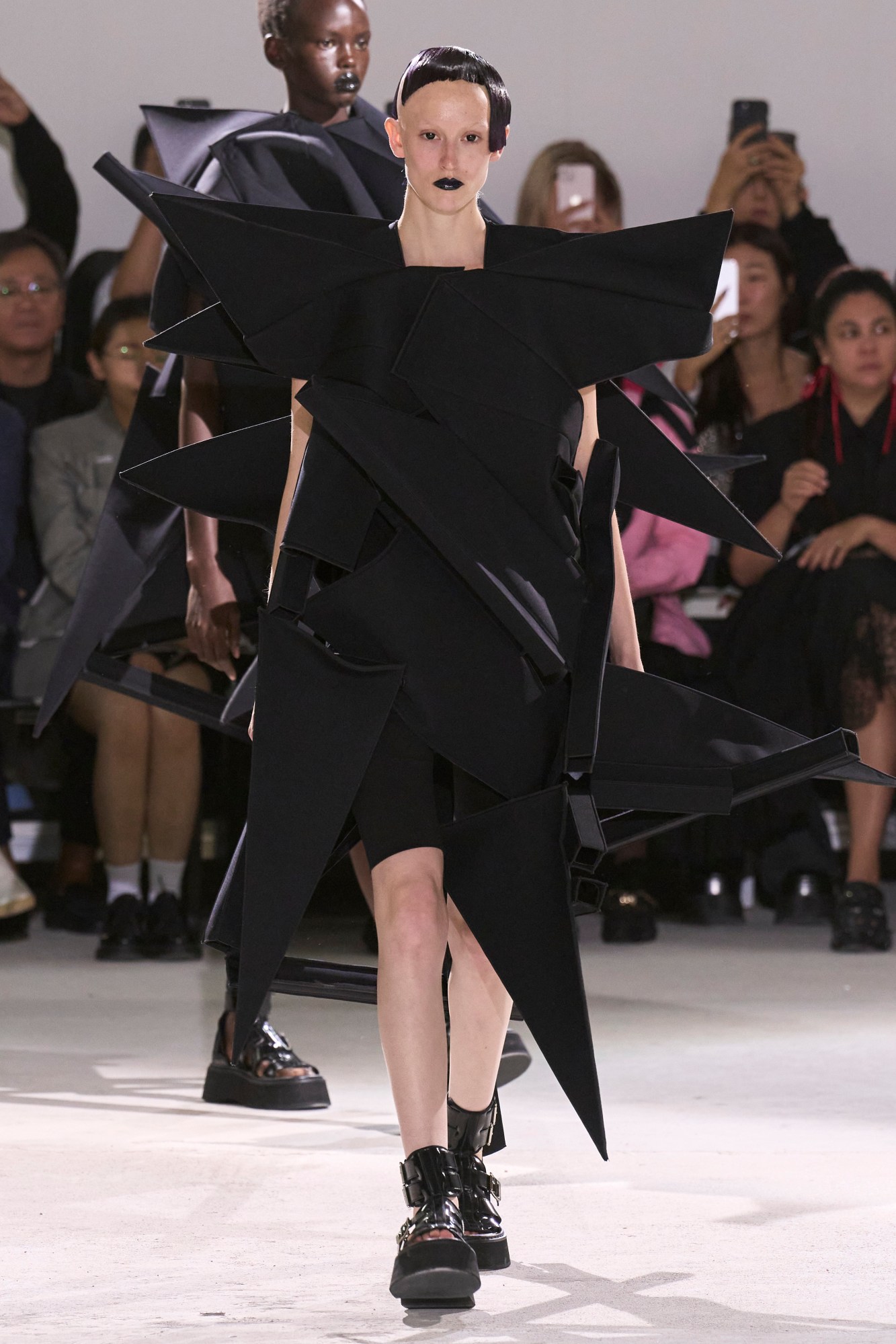
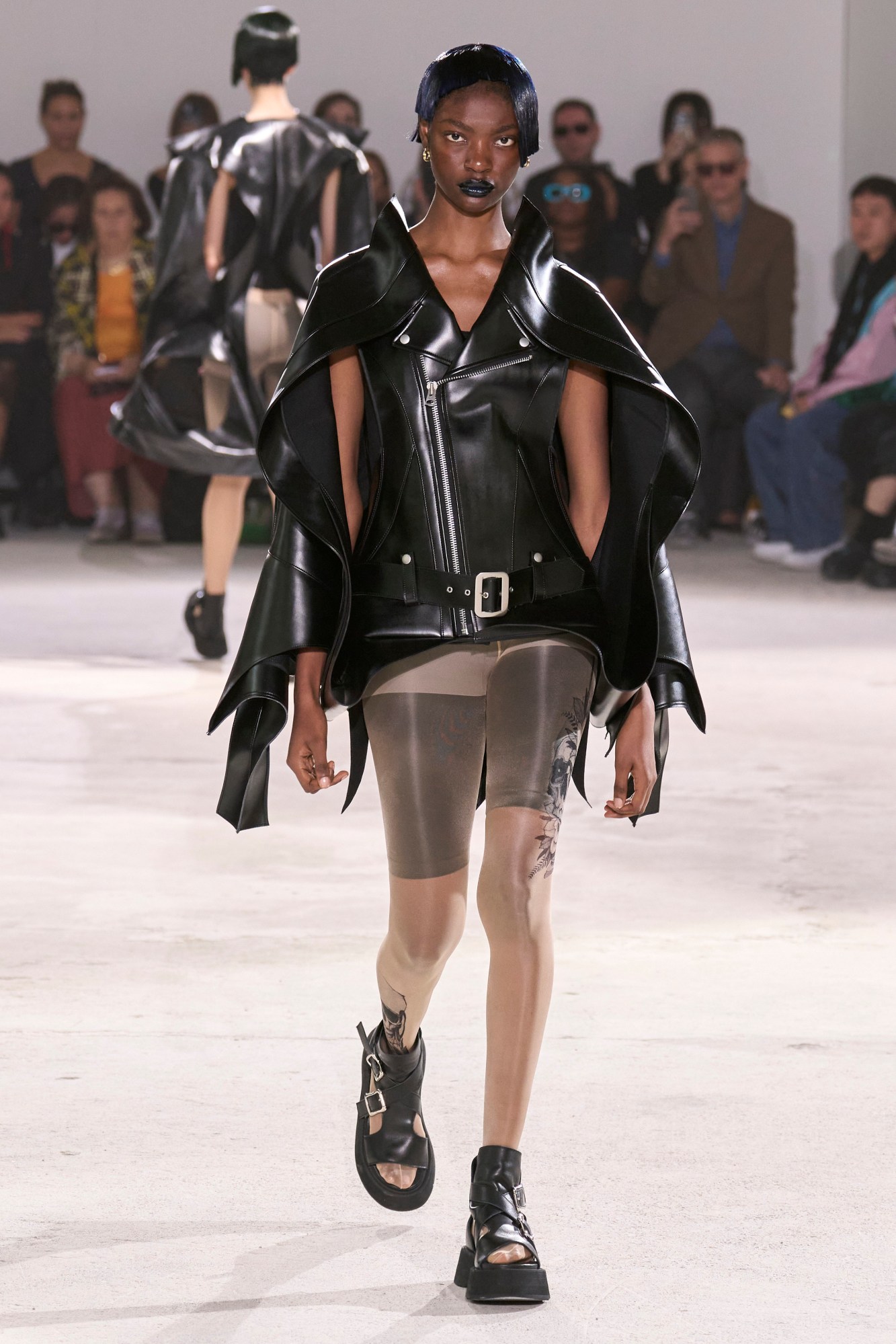
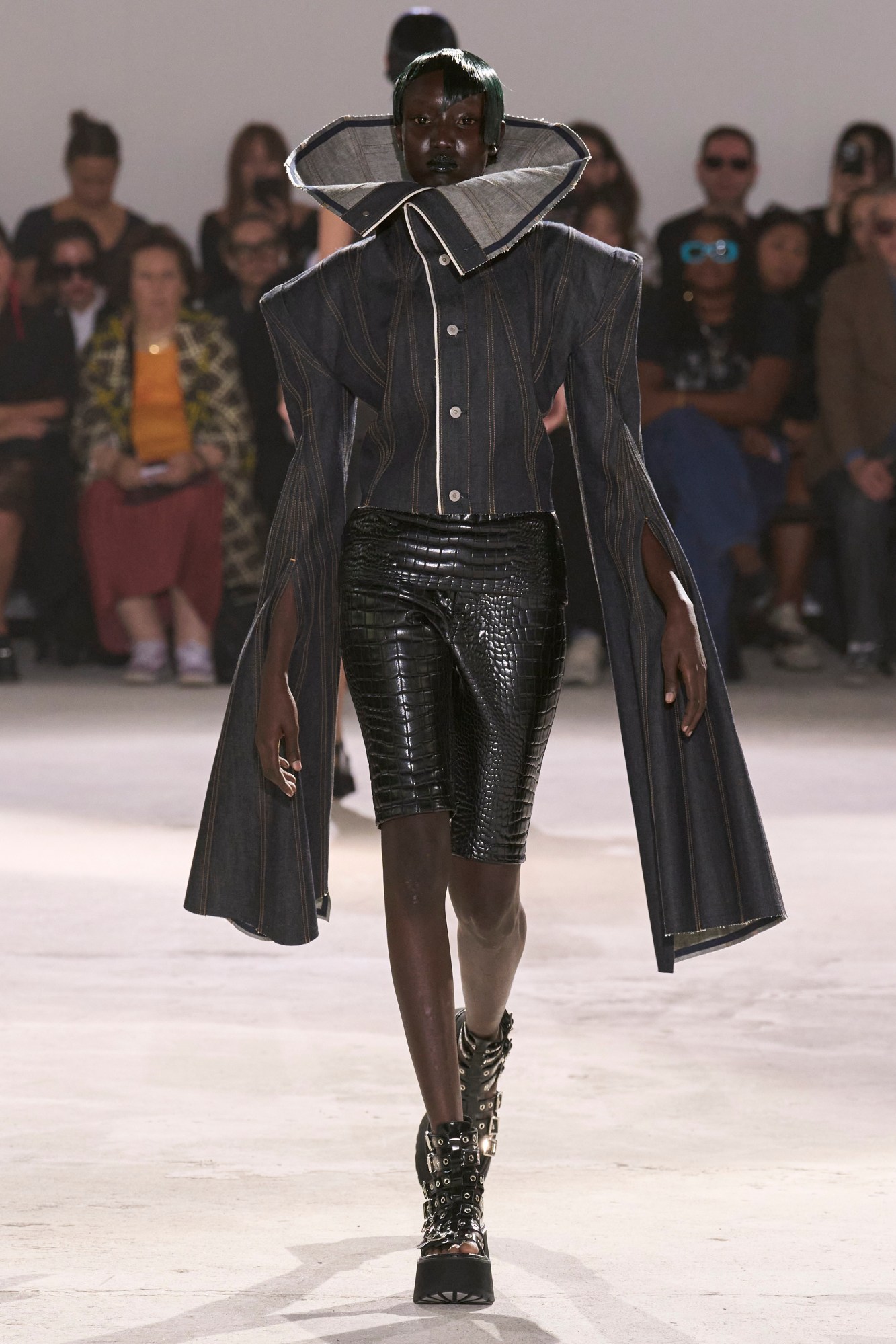
Junya Watanabe
Known internally among fash-packers as ‘Comme Day’, Saturday’s the day when the weird and wonderful talents under the Comme Des Garçons umbrella come out to play. Kicking things off bright and early inside a glass-walled building (ideal for chancers trying to get a peek), Junya Watanabe attracted his usual crowd of Japanese fashion cognoscenti and IFYKYK boutique owners looking for gold. Of course, what gets shown doesn’t necessarily make it to the shop floor of your local Dover Street Market, but the odd pieces that do inevitably get lapped up by self-proclaimed archivists and collectors.
As ever with Junya, the show’s soundtrack – produced by Michel Gaubert – mirrored his magpie sensibility, opening with slow, soupy trip-hop before segueing into acid breakbeats and a rockier racket. No shocks there. Junya, a confessed anglophile, has a gift for taking British subcultures and making them even scene-ier than their original renditions. Of course, this is something particular to him and his peers, especially his mentor Rei Kawakubo and the CDG cronies Chitose Abe and Noir Kei Ninomiya. Where clothing was concerned, this mapped onto spliced and spiked perfecto biker jackets whose very bends and stiff folds of polished leather gave way to hulking, aggressive silhouettes. In keeping with the punk-inflected look, models swaggered with an air of insolence, screwing the audience and turning on their creeper-heeled bondage sandals as if to say, “Up yours!”
Elsewhere, thick cubed pipes of felt formed frocks akin to landmines, teaming neatly with razor-sharp, high-shine hairdos and black lippy implemented as a blanket rule. As a sartorial proposition, this woman didn’t need much explaining, nor would she care to elaborate had you asked. Here, jutting sleeves and patchworked inserts of leather structured a lightly cinched mesh-polyester blazer, together embodying that strange confluence of fabrics and conceptual touchpoints that defines Junya’s bandit couture. Indeed, look closely and you realise, the man is not just an obsessive lover of the style tribes colouring Harajuku’s backstreets, but also, at times, an iconoclast, willing to rip it up and start again. Take, for example, the bomber jacket, articulated across the chest with an abdomen of leather, triangular pectoral patches and slick, stegosaurus ridges on the flank. That kind of dressing is brave at any moment, but especially now, when the runways are awash with cool minimalism and watchwords include ‘quiet’ and ‘wearable’.
As for the Junya acolytes who have been analysing his every move on Reddit threads since the late-2000s, the subplot unfolding between this collection and his previous menswear collection will make for serious discussion fodder – especially among stuffier hypebeasts with stakes in deadstock Junya menswear. To contextualise, the men’s SS24 offering – still replete with collaborations from your Stüssys and Palaces – had directly referenced the flowier, A-lines of his womenswear. Again, today’s collection also gave gender-bending a whirl, bucking the saccharine lolita-isms usually present in his women’s line and embracing the harsher workwear silhouettes and selvedge denim of his men’s. Yep, those patchworked jean dresses on show this morning, believe it or not, were a carryover from his menswear show. While none of this is groundbreaking in today’s fashion sphere, for Junya, who has always clearly demarcated the two labels, Junya Watanabe MAN and Junya Watanabe, it’s big news. No doubt, his menswear loyalists will soon loosen up, while the womenswear fans acclimatise to an even fiercer femme. JB

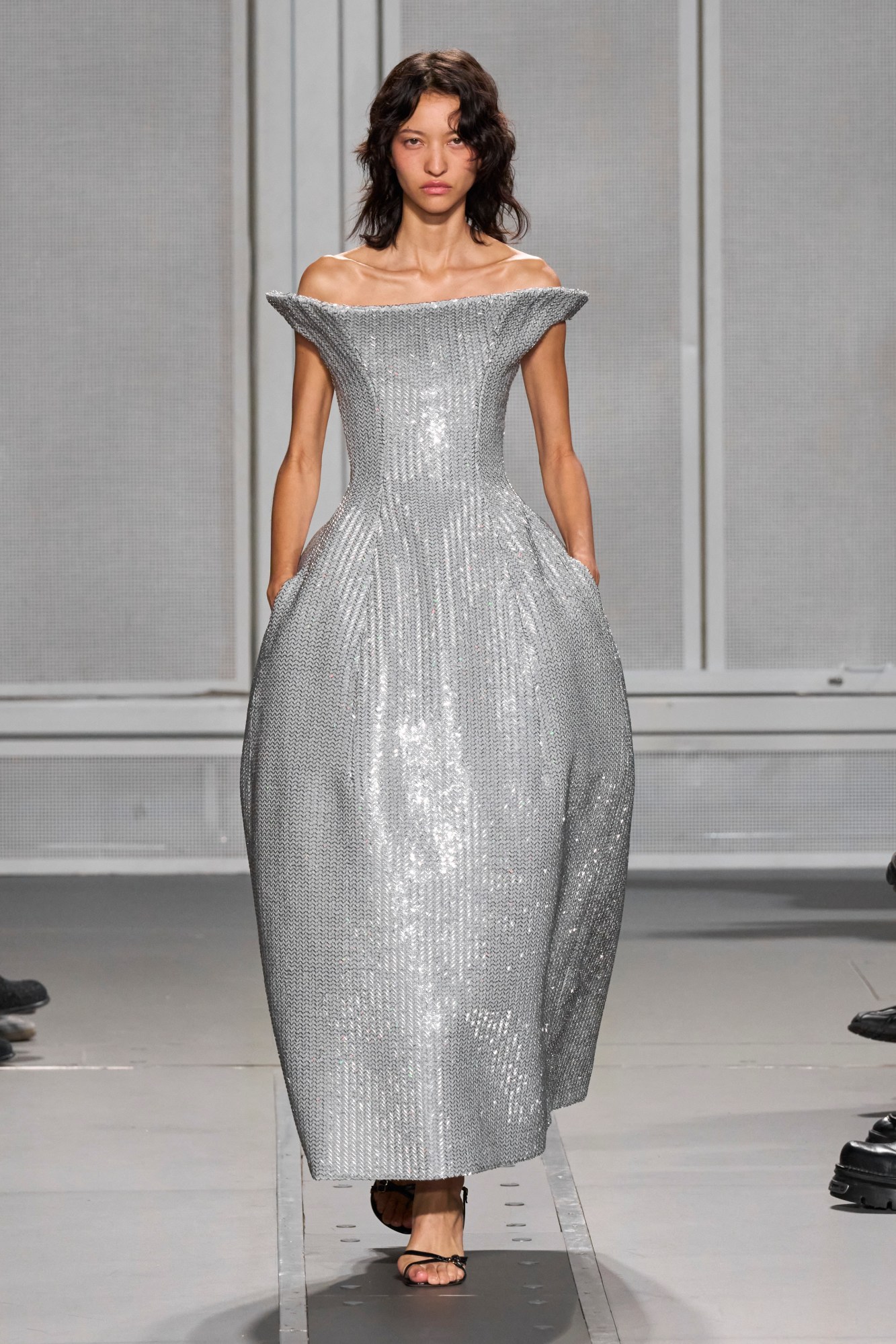

Coperni
If there’s one thing we’ve learned from Silicon Valley, it’s that tech bros don’t do fashion. And so, while we might be trusting the app developers, coders and AI-generated prompts to guide us through the next century, we can’t rely on them for style advice. Lucky, then, that Coperni – the space-race label dressing tech-savvy gaulois girlies – has it covered on the sartorial front. Of course, it’s easy to assume we’ll be floating around in Space Odyssey astro suits when the time comes to disembark planet earth, but as the co-designing couplet Sébastien Meyer and Arnaud Vaillant made clear last night, it’s going to be a far sleeker affair.
SS24 gave us space-age dressing 2.0, combining retro-futuristic blasts from the past and highlights from tech’s bleeding edge. Presented inside the Institute for Research and Coordination in Acoustics / Music, the show began as long, perforated steel speakers began to shift and gyrate in the walls and ceiling, unleashing a series of strange but familiar sounds. “For eight years, it was closed for renovation,” explained Arnaud backstage. “We are the first to show in this beautiful location, so we have done a residency with our sound designer [u.r.trax]. She’s been working there for six months building the soundtrack.” Indeed, the rich and clear sounds chimed (literally) with the clothing. Instrumental triangles formed insets across the chest of an 80s tracksuit or keyholed the centre of one model’s tank top. Meanwhile, the walls pounded, scratched and jingled with the sounds of fabrics in motion, triangles and other bizarro tones to form a musically inflected collection that we’re calling sartorial synesthesia.
Elsewhere, sports vests were perforated along the flanks and across the navel, forming circular or concave outlines across the body. On foot, racing sneakers bevelled and set like polygons finished the look. These were designed with Puma’s innovation team – as opposed to its run-of-the-mill collaborations team – Arnaud noted. The result was kooky, svelte and racy, perfect for anyone trying the door at Berghain’s 2089 equivalent. Of course, for anyone that’s been watching the duo’s meteoric rise this past decade, such innovation is now protocol, spanning everything from that robot-sprayed number Bella Hadid donned for SS23 to laser-cut apple-leather Swipe bags. This time round, it was the Humane Ai Pin – a bite-sized smartphone that will project your emails, digital calendar and incoming calls straight to your hand – that took the prize for nerdiest gadget. However, unlike the robo dogs of Coperni’s recent past, or even the chrome Walkman-cum-bags of this season, this tech design is still a work in progress, positioning Coperni at the forefront of tech’s next big takeover. If that sounds a little scary, don’t fret. The future promises plenty of fun, too. Shoulderless vests that splay outwards like trumpet horns? That’ll be hot stuff in 2089. As will the bandeau dresses with zip-lined roses or the speaker-fitted separates. The future looks (and sounds) great. JB

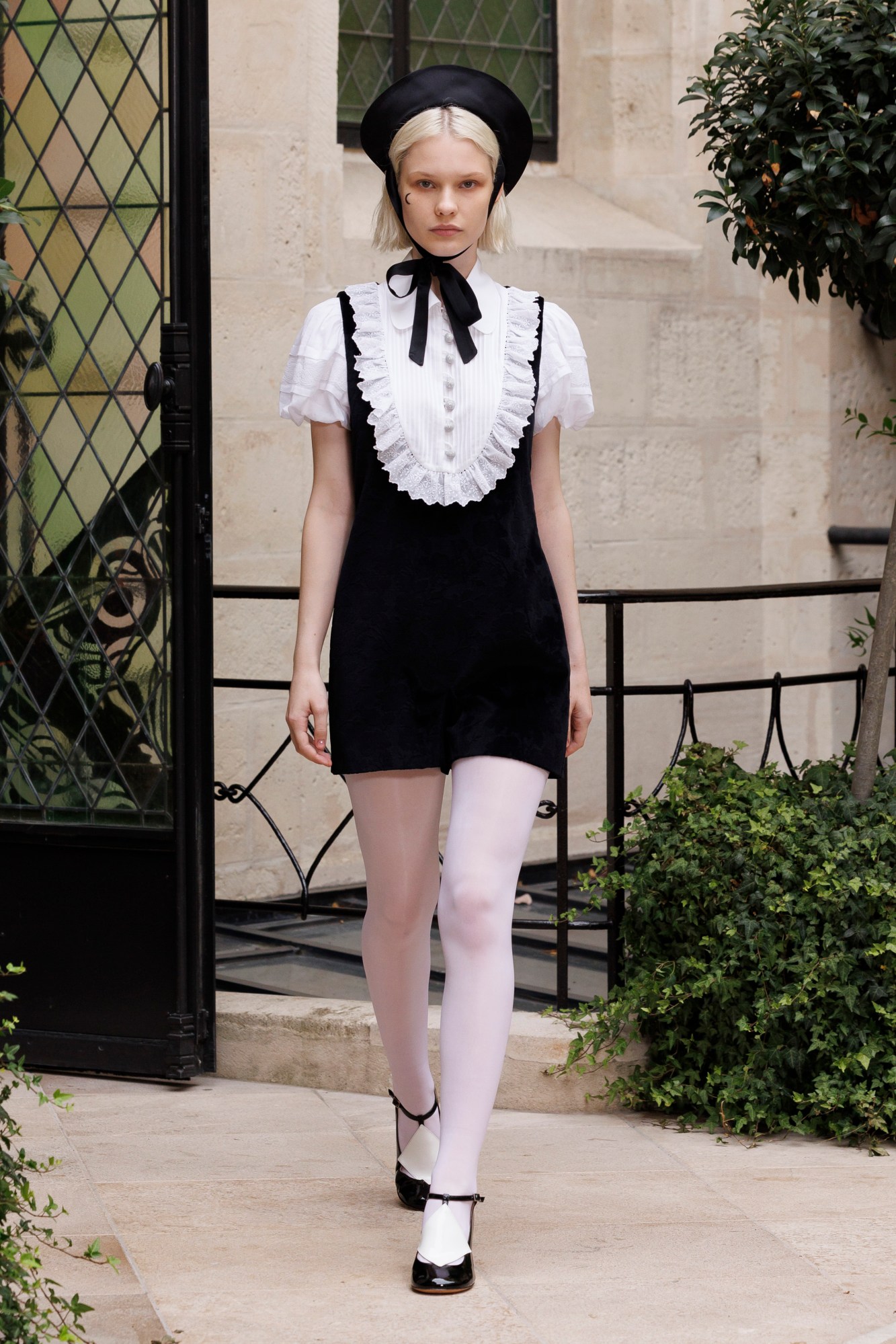

Paul & Joe
Sophie Mechaly, the founder of Paul & Joe, has been going it alone since 1995 when she opened her esteemed fashion label. As far as independents go, she’s the real deal, working closely with two French ateliers: one for womenswear, which she heads up, and the other, for menswear. Yes, those ‘Made in France’ labels adorning each piece are no gimmick.
Indeed, it’s this fierce independence that drives her life’s work. Growing up, Sophie kicked back against her bourgeois background, disenchanted by the stuffy restraint expected of her. From here the seeds of Paul & Joe were planted and later unleashed in colour and drama aplomb, an approach felt today at the brand’s SS24 presentation.
And so, in a fine Parisian hall, the latest collection was exhibited without reserve, taking the form of a long, saccharine feast in which the P&J femmes could recline, mingle and showcase their wares. Taking cues from the 18th-century tradition of commedia dell’arte, the story unfolded before us without the strict scripting of a catwalk, but instead improvised modelling. Here, lightly panniered dresses, generously feathered in ostrich plumes joined slips illustrated with playing cards. A palette of fairytale pastels and brash harlequins held court. Drama? Check.
Elsewhere, pom-pommed Pierrot-esque shirting, quilted and splashed in daisies, came with matching bloomers, while the slap – from the brand’s very own beauty line – was otherwise dewy and natural, zhooshed up with half moons and concave blusher. Sure, these are old templates that Sophie is riffing on – historical costumes, in fact – but there’s a contemporary appeal to her work. Striped suits in taupe and cream were sharply pleated across the ribs, speckled with ribbons on each shoulder, while one double-breasted blazer, buttoned again with pom poms, stood replete with baby-pink and ivory brocade. Very Barbie.
Where quality’s concerned, P&J ticks every quirky but monied parisienne’s box. “It’s very important for Paul & Joe,” affirmed Sophie. “After 28 years, I’m still so full of passion – full of energy, full of desire – to please my customers and keep doing my job by myself.” Clearly, something is working. JB
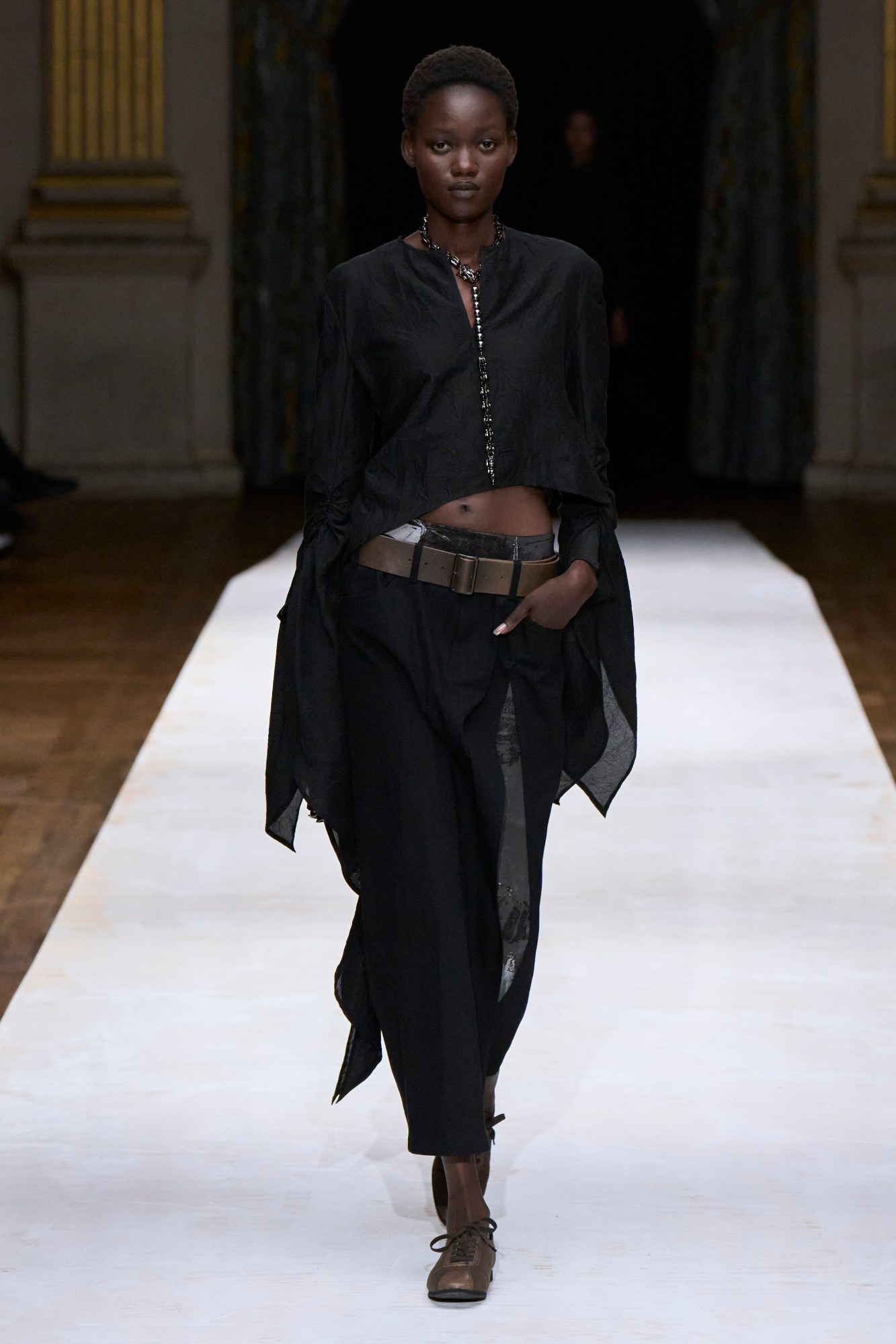
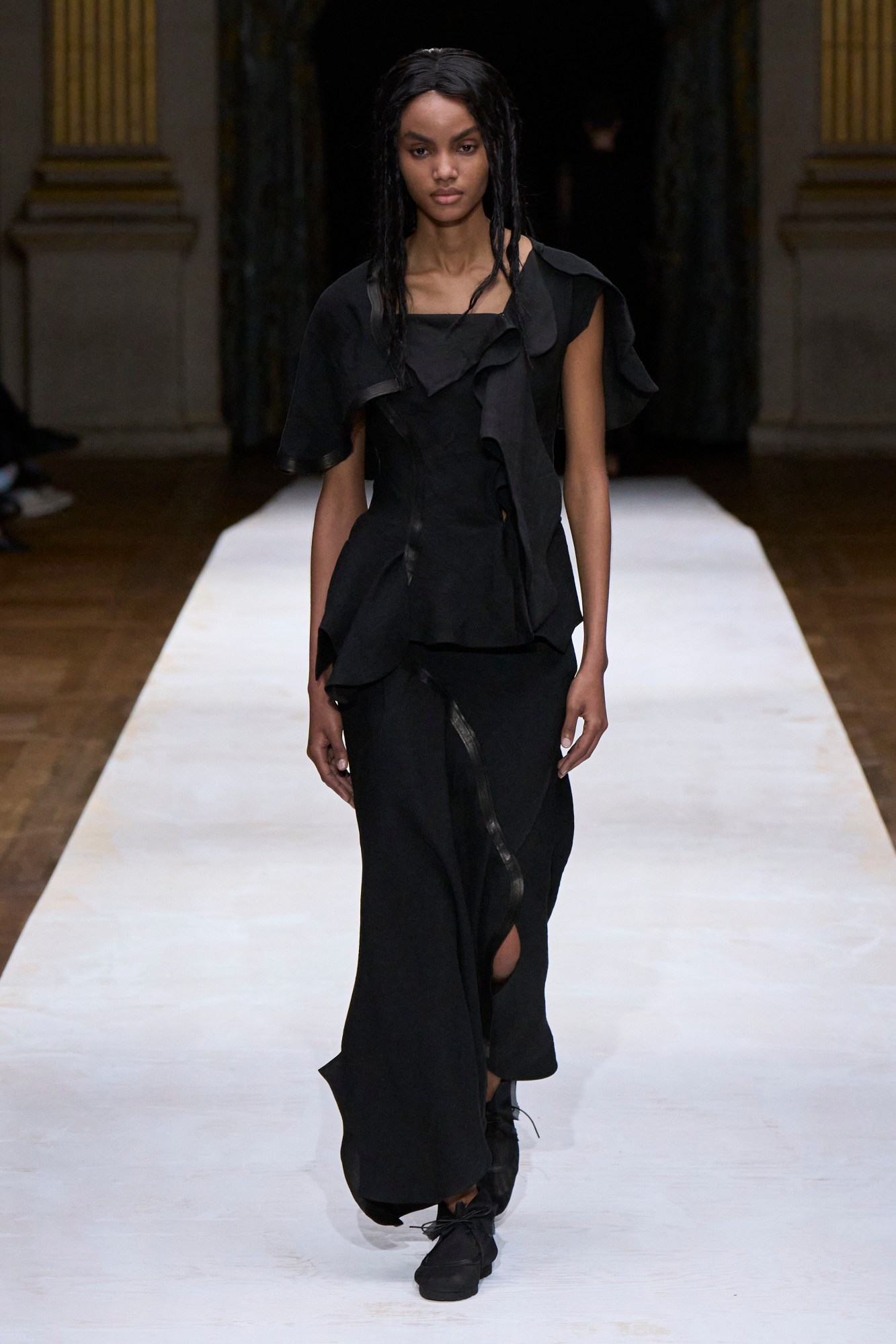
Yohji Yamamoto
Yohji Yamamoto is of a dying breed. Cutting his teeth on pure couture, the dark magician learned the rules in order to break them. Nowadays, most designers rising the ranks profess a broader, anti-specialist approach to design. Take, for example, the likes of KidSuper’s multi-hyphenate Colm Dillane, who sat front row at Yohji’s show last night. Colm spreads himself across the mediums of fashion, fine art, film-making and artistic direction, while Yohji hones one stubborn aesthetic and method, season after season. Of course, this is not to pit one modus operandi against another, but simply to note the impressive singularity of Yohji’s vision. In more than 50 years, he’s extracted so much from such a tight template.
Indeed, you could guess much of what goes down at a Yohji show. Was the palette black? Did the models walk in slow, deliberate motions? Does the pope have a balcony? You know the score. But it’s this familiarity that makes shows like SS24’s special. Under such restraint, subtleties come into sharp focus; otherwise tired editors enter a flow state.
To the sound of a strumming guitar – he also plays himself, as it goes – girls with stark to little make-up and jet black ringlets moped along the catwalk like banshees, primed with ivory-buttoned Victorian waistcoats and white linen shirts that pricked upwards at the shoulders before obfuscating the arms. “This time, I wanted dark, twisted hair, because the hair needs to fight with the skin,” Yohji explained backstage. “This combat – of skin and black fabric or black hair – for me, is very important.”
Later, the banshees took an even darker turn, slipping into shrouding cacophonies of thick black cupro. This was Yohji 101, tweaked again with a generous use of the fabric scissors and a seasonal penchant for wrapped sheaths. Witchy, but wise. Elsewhere, tasselled and tulled confections, dotted with buttons and intentionally awkward drapes, spoke of anti-heroine confidence. A willingness, if you will, to stand out while also stepping back. Shrinking violets by choice.
It wasn’t all par for the course, though. This season, the crows came with a few curveballs, albeit ones designed on Yohji’s own terms. Belly chains, mangled in pewter metal, were shucked of any Y2K connotations, instead reading as mystic talismans. Even the blazers, redolent of Dior’s Bar jacket, were bastardised with raw slashes across the bottom and thick white stitches left unfinished. One could unpick (literally) and study these pieces for hours on end, however, in some ways, that would defeat the point. The wear and tear they so proudly pronounce is part and parcel of their magic. Sure, they’re made to last, but as the wabi-sabi touches tell us, nothing lasts forever. Wear it to death. JB
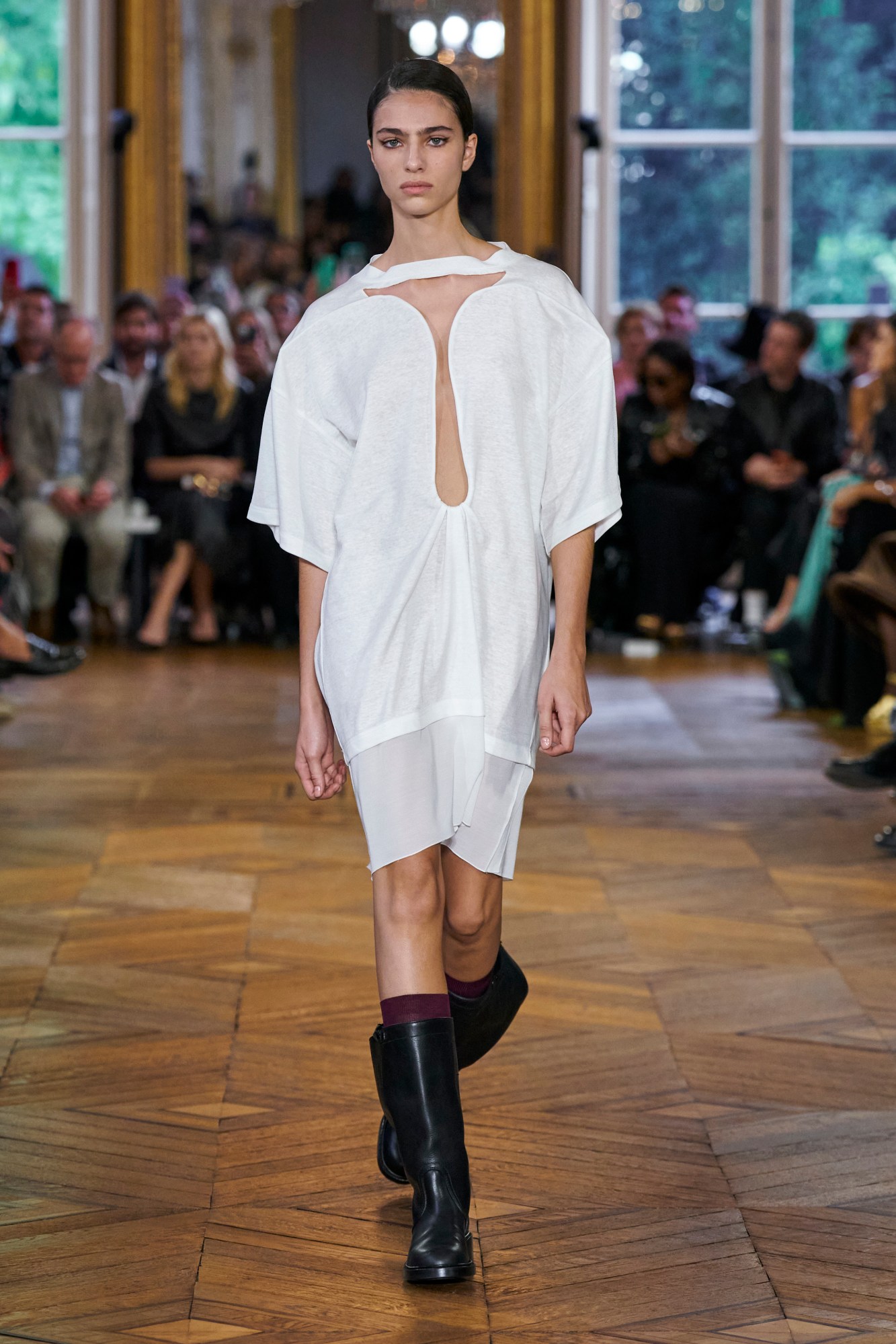
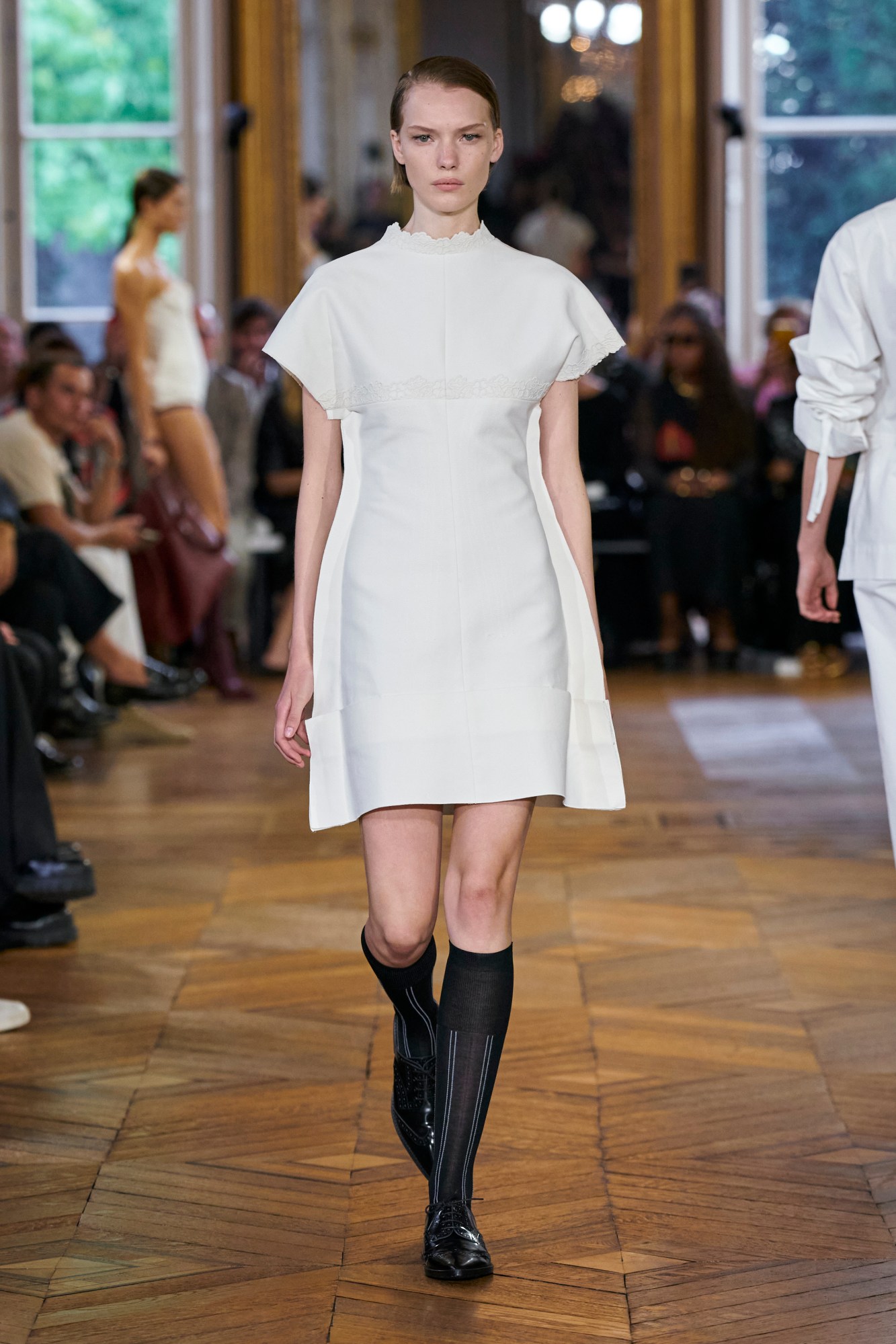
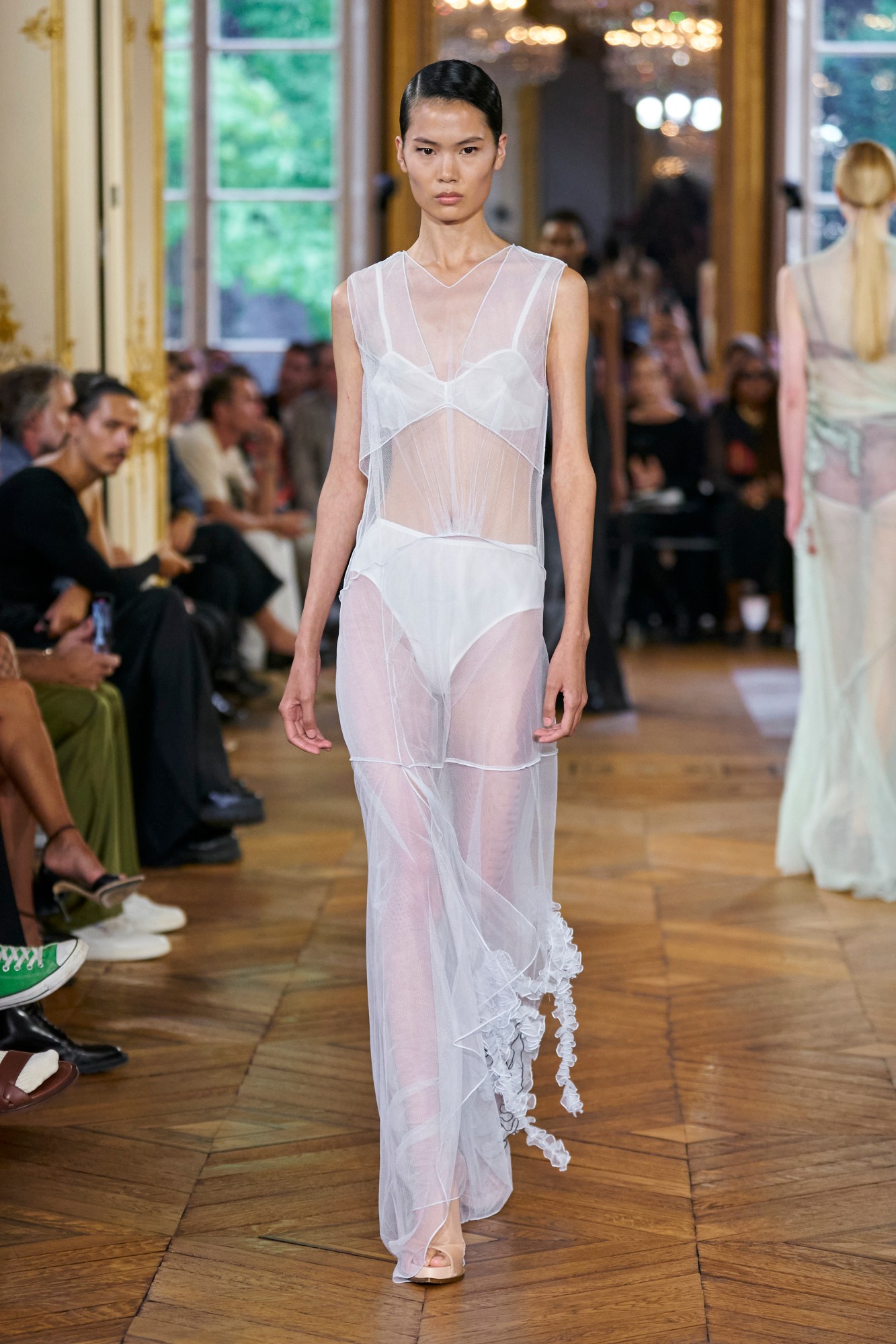
Victoria Beckham
The word chic gets thrown around a lot, especially in Paris. These days, it’s a catch-all byword for anything remotely refined. Reading Le Monde with a ciggie and croissant? Chic! Sauntering across the Seine for dinner at your favourite brasserie? Chic! Eating a McDo while being chauffeured to the next show? You guessed it. C’est chic.
However, in this instance, at Victoria Beckham’s latest show, the term was used without an ounce of exaggeration. This was chic, stripped back to its original meaning. And so, there, along the manicured lawns and regal halls of Karl Lagerfeld’s former Hôtel de Soyecourt, VB served serious fashion for serious women.
Less chic, was the late start time, but we will forgive the designer, as it was Kris Jenner, Kim K et al. we were waiting on. You can’t argue with that. Kicking off to the dulcet tones of Rose Royce’s Wishing On a Star, the show began with the fluid silhouettes that define Vicky’s label. Soft and supple, separates and ensembles arrived in optic whites, greige and black, cut across the chest with a curving keyhole before sloping into a kaftan or taking the form of an oversized, inside-out t-shirt with the wash label exposed. The latter was teamed with the signature, meringue-tone slacks – replete with blink-and-miss-it welt pockets on the waistband – and styled with tailored shorts beneath. As ever, the devil was in the details.
Later, thickened, buttonless suits arrived in marl, the pockets and lapels padded as if stuffed with styrofoam. On foot, cherry-brown brogues with pointed toes made for a playful quirk in an otherwise sober collection. That said, the polished tailoring found its foil in silk satin slips, scalloped along the straps and split with an exposed, flapping hem. The sole flourish? Minutely finished broderie anglaise.
In many ways, this felt like the VB woman revealing a little more of herself. A fragility, if you will, that sat at odds with the assured confidence of écru jumpsuits and the snatched flanks of a needle-check sleeveless suit. This was especially so in the duchess satin gowns, again, crimped along the edges or left with an unsewn strap and exposed bra stritching. Together, but a little undone.
It’s no secret that Victoria’s brand has faced its challenges, despite impeccable collections, but this felt optimistic and – like all her work – amenable to a woman who wants to look chic (there it is, again!) on her own terms. One day, she’s a confident, quiet luxurian; the next, she’s a soft-girl sophisticate sharing just a hint of her vulnerability, but owning every exposed stitch. JB
Loewe
In a season where most designers have been exploring the idea of pragmatism — real clothes for real life — along comes Jonathan Anderson to subvert the status quo. It was the word he used to describe his show, held in the courtyard of the Château de Vincennes on the outskirts of Paris, where a vast Loewe-branded grey box had been constructed and filled with metal works by American sculptor Lynda Benglis. “A stringent proposal of daywear,” Jonathan described the collection as. “A pragmatic one.” Read ou the full review here.
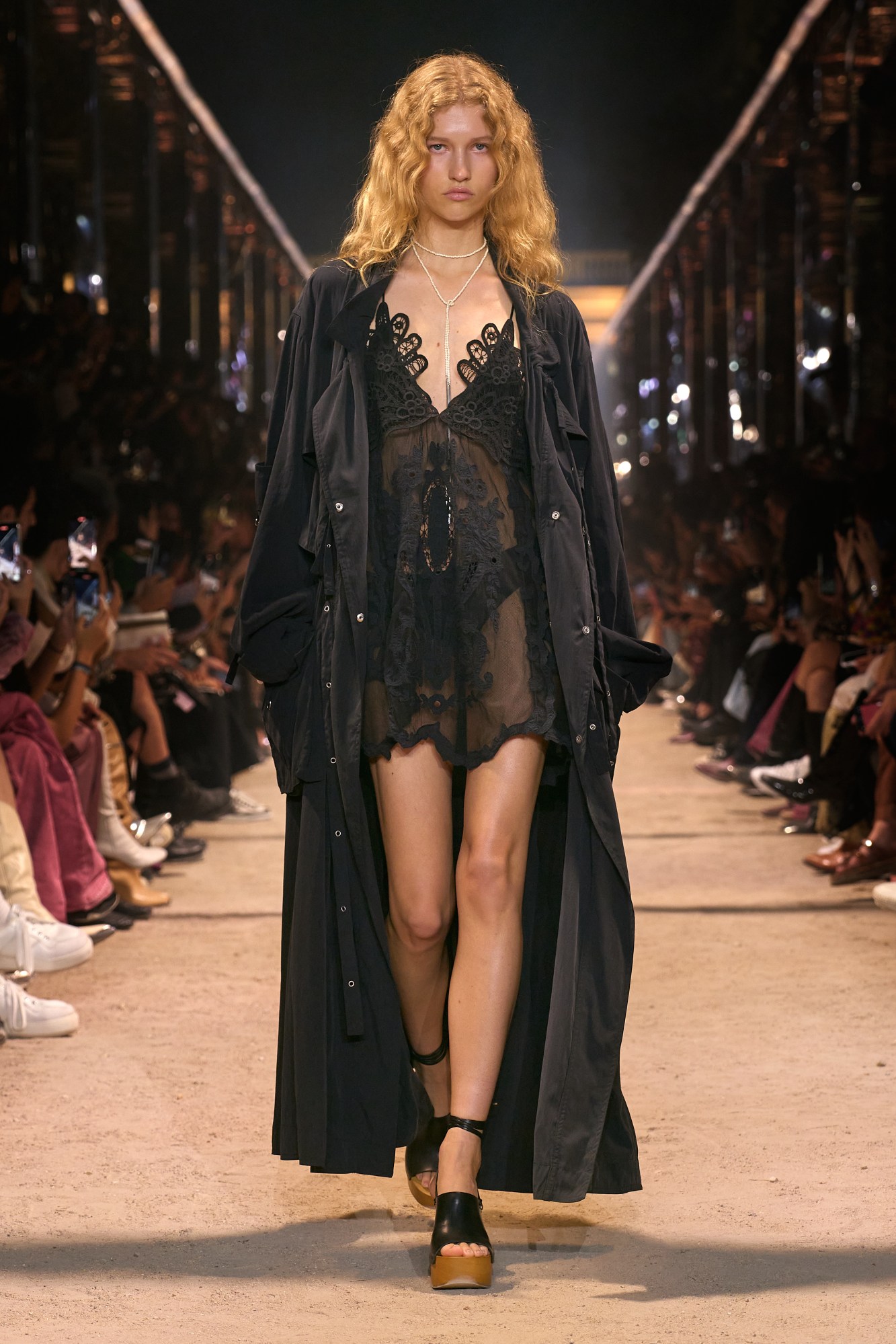
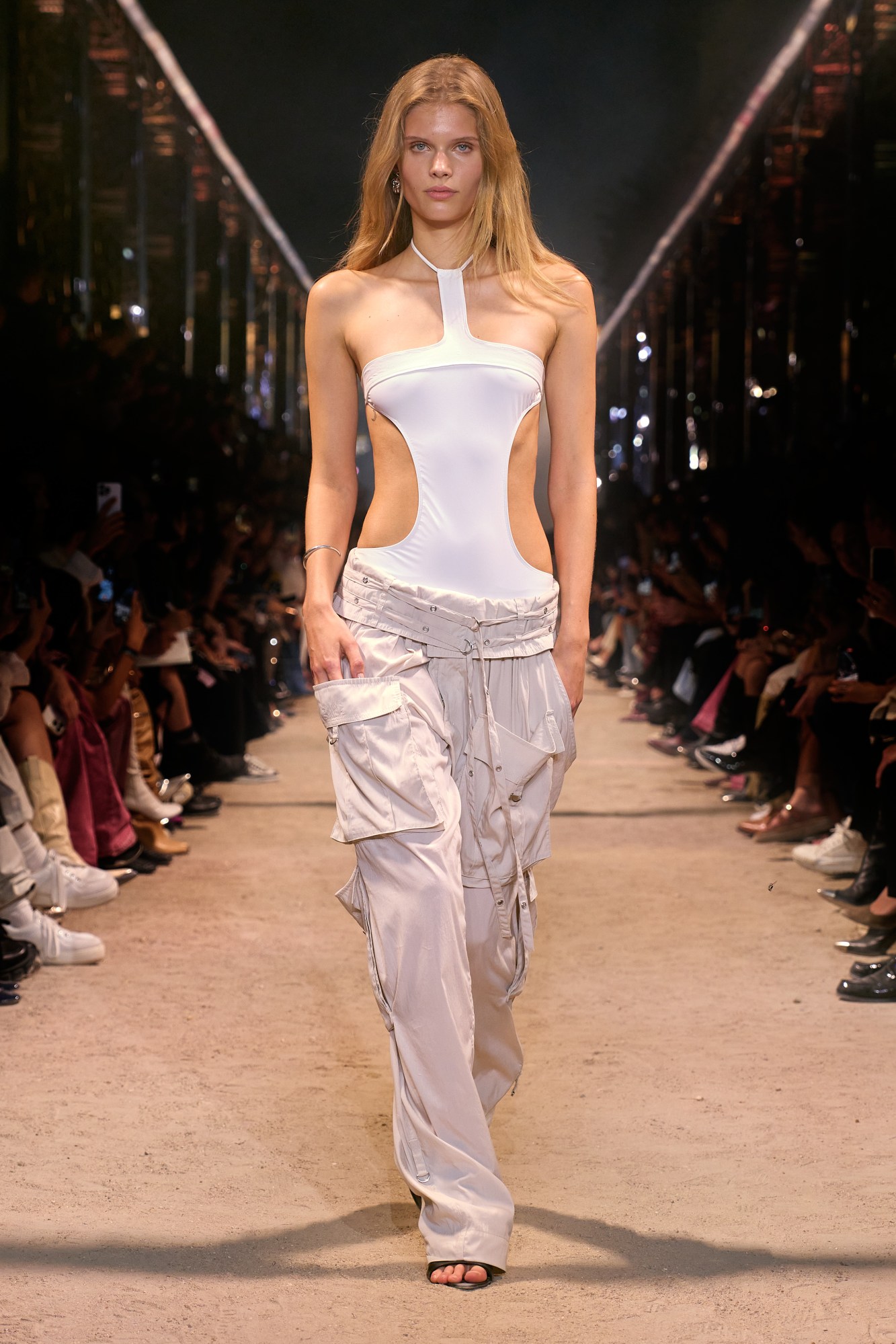

Isabel Marant
On Thursday night, Isabel Marant plunged the gardens of the Palais Royal into darkness. Well, Midnight blue, to be exact, with ornate fencing lining the long runway. Guests might’ve stumbled in and struggled to find their seats in the dark, but the moody scene set the tone for the designer’s latest collection transforming the label’s recognisable boho-chic aesthetic into a series of eye-catching evening looks for the fashion capital after-dark.
Inspired by “ornamental Art nouveau curves and radiance”, as well as a sense of “this summer’s insubordination”, it’s clear that Isabel had a Parisian night out on the mind: semi-sheer lace shift dresses took on a witchy vibe in shades of black, strappy bodysuits and halters met baggy, rolled over cargos, very much in line with our generation’s penchant for sexy-yet-comfortable ‘going out’ garb, but there were also variations on leather hot pants – racecar red and tan with rounded seams, worn with matching moto jackets for the club, or the café, or studded and paired with a sheer tank and oversized blazer, in a look that practically reinstated Isabel Marant as the OG arbiter of French girl style.
There was a sense of unconventionality throughout SS24, as well, with T-shirts made of silk crepe and the slinkier dresses were crafted from cotton jersey, plus many of the body-hugging silhouettes featured extremely high necklines, accentuated by embroidery or silver cuffed chokers. “The collection evokes a poetic-yet-nonchalant desire for lightness and femininity,” the show notes read, “ultimately encapsulated in the wild and shimmering evening looks” – a black 80s lurex disco pants and a catsuit, with contemporary side cut-outs, as well as metallic beaded dress, fit to close out any show. Or club. ND
Schiaparelli
Schiaparelli has never been one to rest on its laurels. Indeed, the very concept of a chronological, clearly defined set of house codes is alien to anyone in its atelier. Of course, no one knows this better than the Texan mastermind, Daniel Roseberry, who has reignited the couture maison since taking its helm in 2019.
A dark horse who earned his stripes working for Thom Browne’s design team in the 2010s, Daniel has risen to the challenge with a brazen approach that’s rare for anyone assigned such an old house. Rather than waxing lyrical about a return to the archives or a rediscovery of its oldest techniques, he has instead looked inwards, bringing his own bizarro imagination to the fore. And quite, right, too. Daniel was immediately vocal about his approach. For him, the house was defined not by a silhouette, shape or particular cut, per se, but rather a commitment to concept. Naturally, he took this as carte blanche and ran with it, delivering sensations aplenty.
This collection was no exception to the rule. And so, he delivered his own, souped-up and uncanny version of Old Hollywood glamour, rich with Americanisms and the kitschy quips he does so well. Jumbo keyhole dresses – cut like shoulderless boleros – arrived in ecru and black, further tweaked with freaky accessories and finishes. Think wonton-shaped earrings, a set of shag-pile sleeves or simply some golden-capped baseball trainers, which upon closer inspection, were welded with the outline of toes (nails included). Elsewhere, the lobster nods, perhaps the closest we come to a house code, came as hulking customer jewellery, while ribbed, fleshy separates were buttoned taut or splayed across the chest as if about to pop open. On the midriff, there were literal piercings, while the panties below were decked with that familiar (but unfamiliar) keyhole hardware.
True to Daniel’s modus operandi, this took the banal or obvious only to place it in terra incognita. Nail varnish was splashed across a blazer, which itself was dotted with trinkets and jewellery, not to mention cigarettes. The lapels were sized up ad ridiculum, as was the denim collar on one dress-overcoat hybrid. To many, these clothes read as strange, if not slightly grotesque. But that’s the point. Daniel wants his wares to unsettle. Like Elsa Schiaparelli and her contemporary Salvador Dalí, Daniel is bringing his dreams – the good, the bad and the ugly – to the fore, elevating them with a seasoned team of petites mains. The best part? It’s being snapped up by star-studded clientele keen to make a splash sur le tapis rouge. Like it or not, that’s entertainment! JB
Rick Owens
When you think Rick Owens, tall, slender silhouettes come to mind – cinching pencil skirts, those signature pointed shoulders and trailing, tightly draped gowns meant for giants (or Kiss boots) – for the most part, in shades of black. And, to be fair, this was the look widely seen outside the designer’s SS24 show on the many diehard fans trying to catch a glimpse of the Palais de Tokyo runway – one climbed into a tree; Rick fandom runs deep. However, what set this collection apart were the pops of colour seen throughout, pale pinks and violet, burgundy and bright red, and tones of burnt orange, that conveyed an otherworldly, intoxicating sense of optimism. Read the full review here.
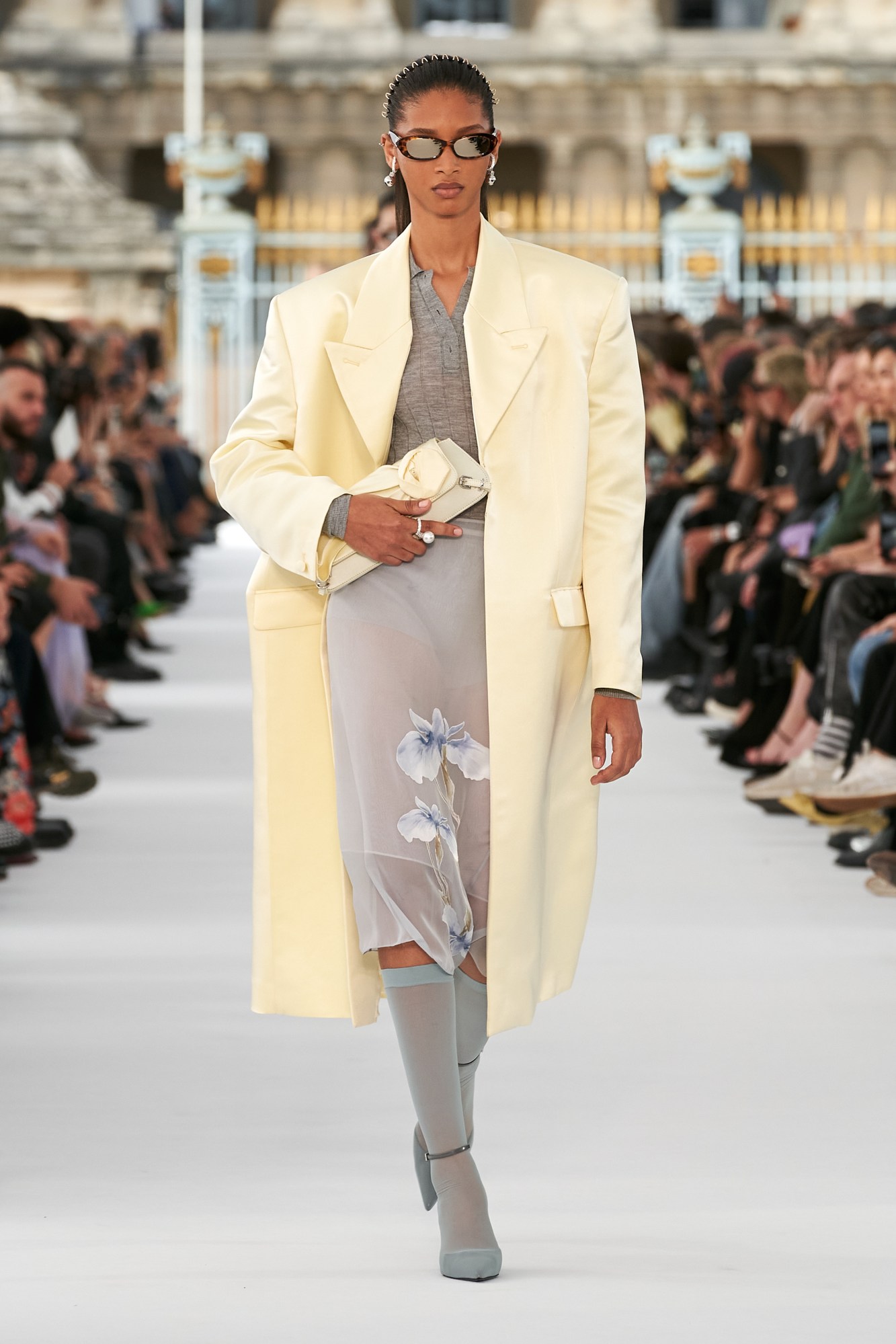
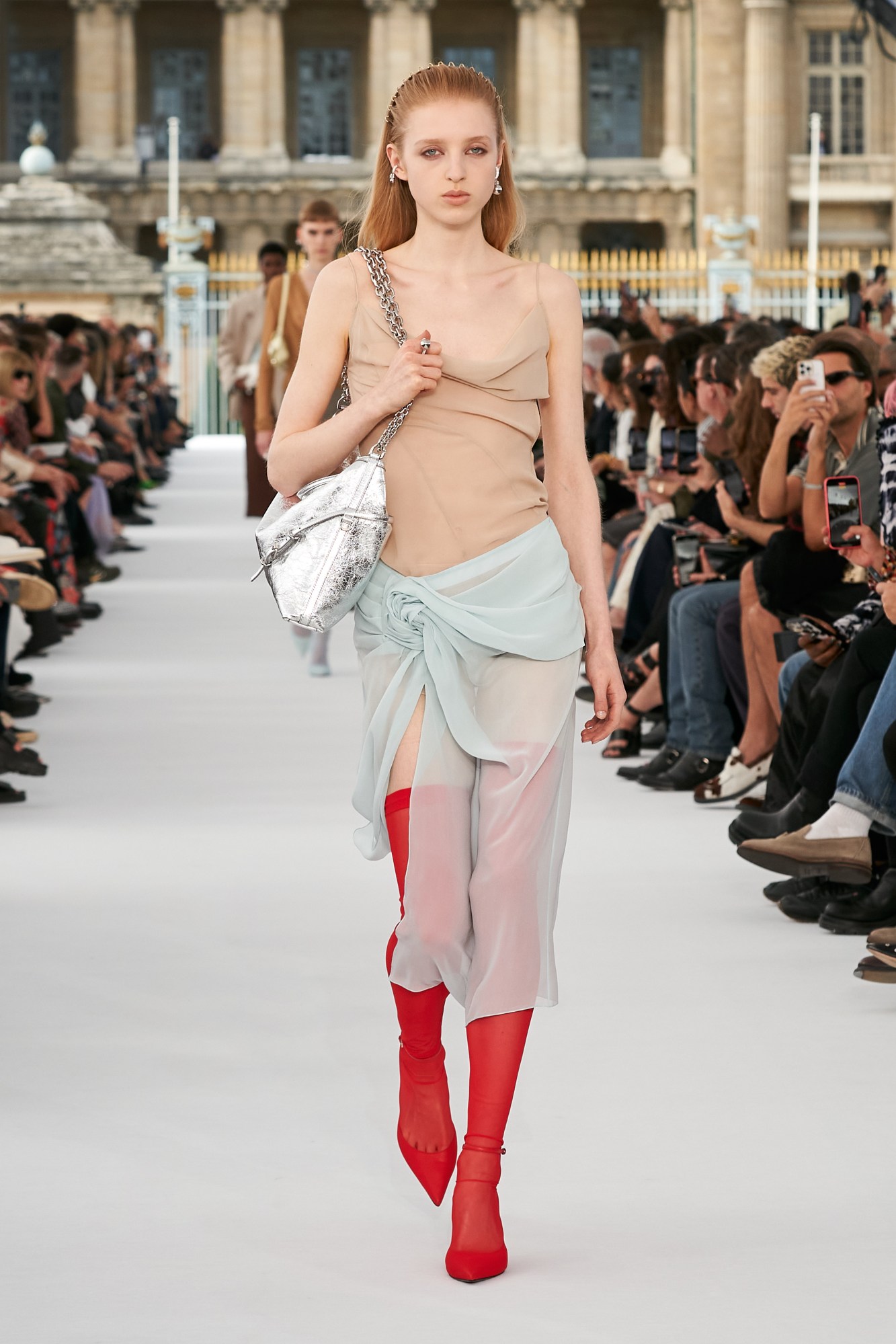

Givenchy
In the courtyards of the grand École Militaire in Paris, Givenchy’s show was held in a stark white cube with tent-like ceilings and open walls, designed by architect Gabriel Calatrava, who happens to a friend of Matthew M. Williams. It seemed to suggest a carte blanche, purity and precision to set the scene for a collection that the house described as “a contemporary grammar of elegance mirrored in the ease of the real wardrobe mentality of the women who surround [Matthew].” Cleaner, lighter, and simpler seemed to be the order of the season. Or as the show notes put it: “A collective comprehension of elegance as shaped by the genetics of [Givenchy’s] heritage and a present-day desire for simplicity.”
The show opened with a trio of looks that set the fundamental tone for the rest of the collection. The first was a black skirt suit, a blazer with softly squared shoulders over a simple white tee, knee-length skirt with an asymmetric hem – long at the front and lifted at the back, framing sheer black tights pulled over ankle-strap court shoes. The second was a wispy chiffon dress suspended by thin straps, drapes of the sheer material swirling into a corsage at the bust. And the third was a masculine black overcoat, perpendicular shoulders and lapels geometrically sliced into an almost hexagonal shape. The rest of the collection riffed on those three archetypes. Occasionally, the big coats came in humble wool, but also in operatic duchesse satin. The gossamer chiffon dresses and blouses floated by in sugared-almond shades, sometimes with embroideries and hand-painted floral motifs. Sometimes, the two collided – a big menswear-sized coat thrown over a barely-there dress. Masculine meets feminine! Structure and softness! The elegance of juxtaposition!
And of course, there was the eveningwear, the silhouettes of which any true fashion will spot the references to Audrey Hepburn, the patroness saint of the house. Long, silky bias-cut black dresses — some with plunging backs, others edged in lace, and many worn with chiffon opera gloves (or just one, in some cases; the modern Givenchy woman has selfies to take) — came out in proud procession, perhaps a result of Givenchy’s recent collaboration with Tiffany & Co — a branded officiating of a match first famous onscreen in Hepburn’s most iconic role as Holly Golightly. There were long black dresses with incendiary slits, some adorned with grids of crystals and pearls underneath scrims of chiffon even one in all-out nappa leather (although technically it was a robe, clutched at the chest). It was old-world elegance by way of a more contemporary sex appeal. After all, Holly Golightly was no saint — even if Audrey Hepburn was. Here were clothes that you could imagine her wearing today, arriving home at dawn after a big night out.
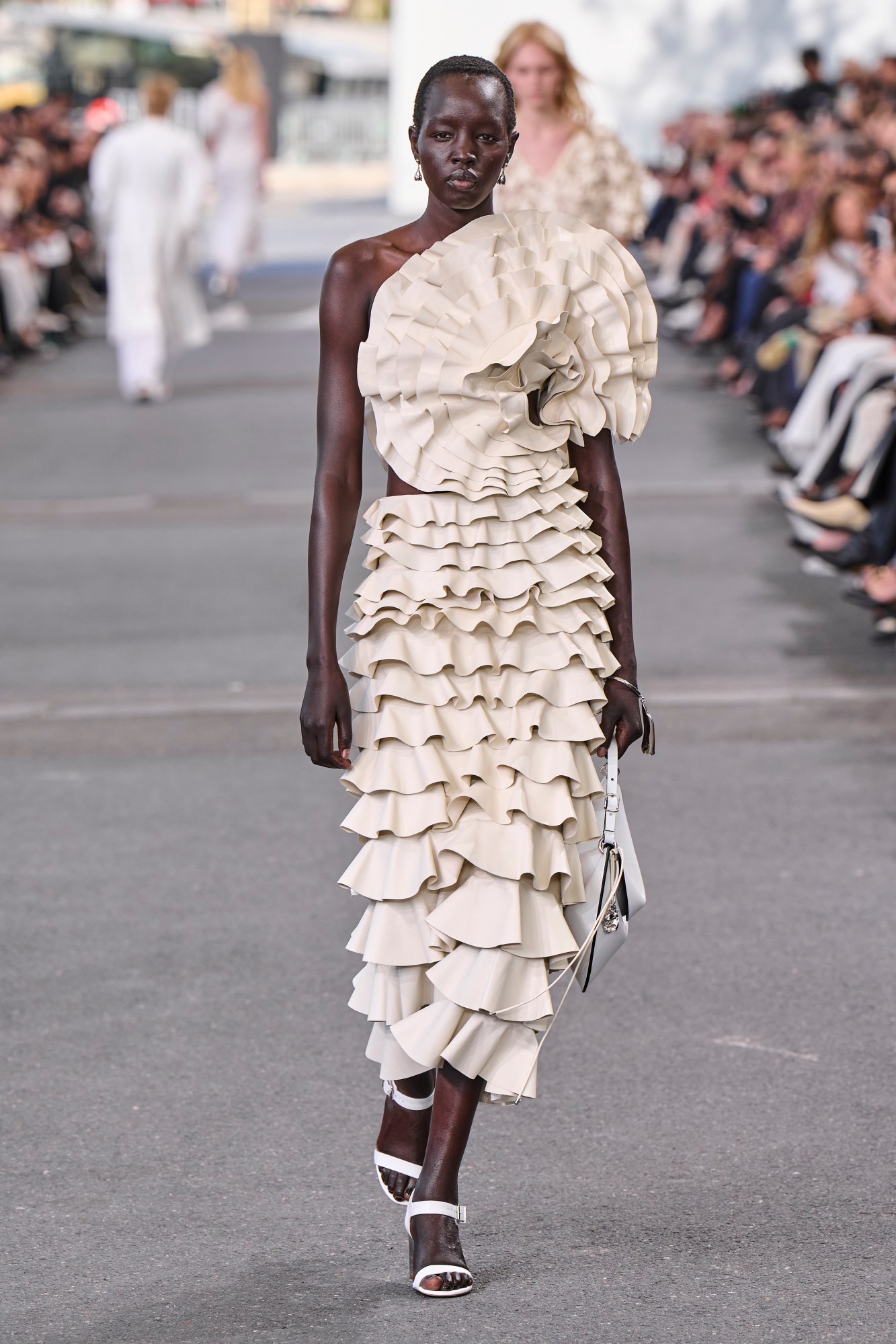
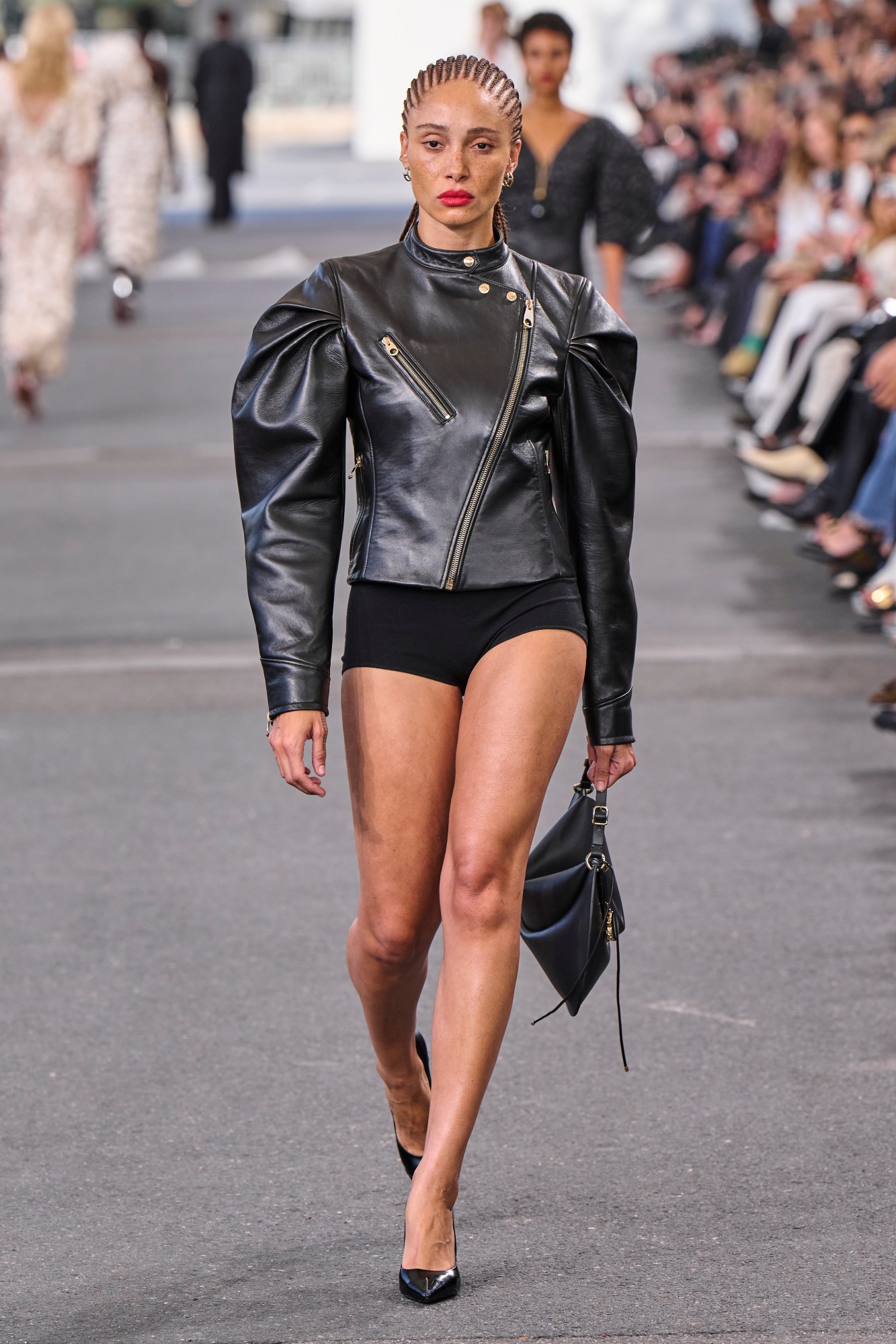
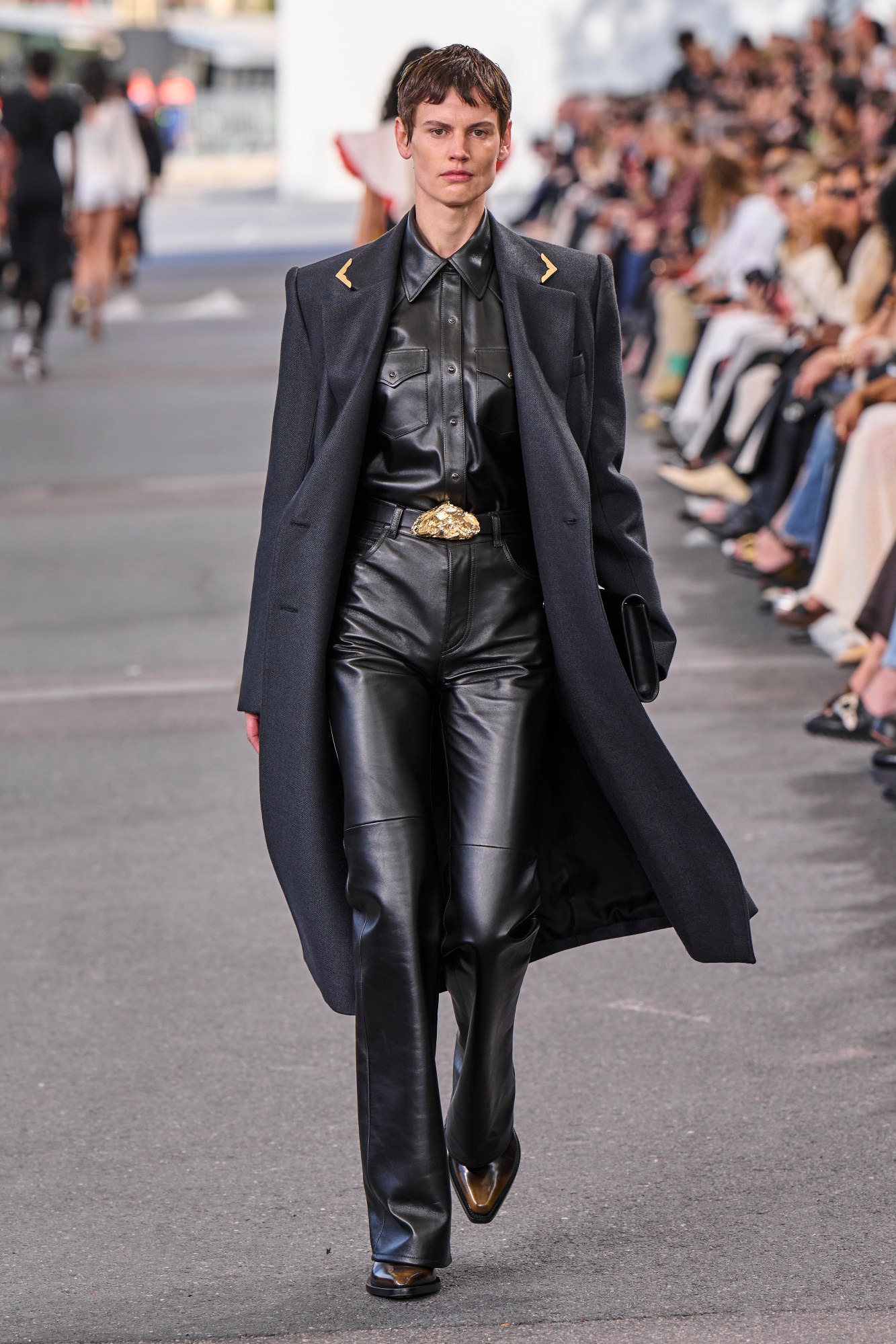
Chloé
For her final collection at the helm of Chloé, after three revolutionary years championing sustainability and environmental consciousness at the Parisian house – and within the fashion industry at large – Gabriela Hearst invited editors to Port de la Bourdonnais for a spirited SS24 show along the Seine. The fourth and final chapter of a series of shows, each focusing on a different climate solution – for AW23, regeneration; SS23, clean energy; AW23, female leadership – this time around, the creative director explored consciousness, and “the power of individual action as a form of environmental advocacy”.
Inspired by the plant kingdom and blossoming flowers – if they can grow amidst the chaos and climate crisis, we can too, right? – Gabriela channelled this positive energy into botanical silhouettes, such as the opening white and black ruffled gowns, each featuring a circular cutout at the side; petals sprouted around it, and up and over the shoulder into a sleeve. A trench and leather biker jacket featured similarly ballooned sleeves that capped and creased to emulate the natural shapes of calla lilies, and perhaps also the delicate curves of the female form.
Though Gabriela focused on the “sacred geometry of flowers” throughout, there was a sense of fluidity and feminine ease to the collection – zippers curved across the torso, necklines dipped low to the breastbone like waves and simple white tank and tube dresses were transformed with flowing chiffon rosettes or seafoam fringe. As a “love letter to Chloé,” Gabriela developed a new print inspired by paisley bandanas worn by gauchos in her home country of Uruguay, but perhaps most memorable of all was the show’s closing performance, which brought musicians and dancers from Rio de Janeiro’s Mangueira school to Paris. They danced the samba, which has “come to resemble social harmony and resilience,” the show notes read, and this moment of pure joy will surely set the tone for the house’s new chapter. ND
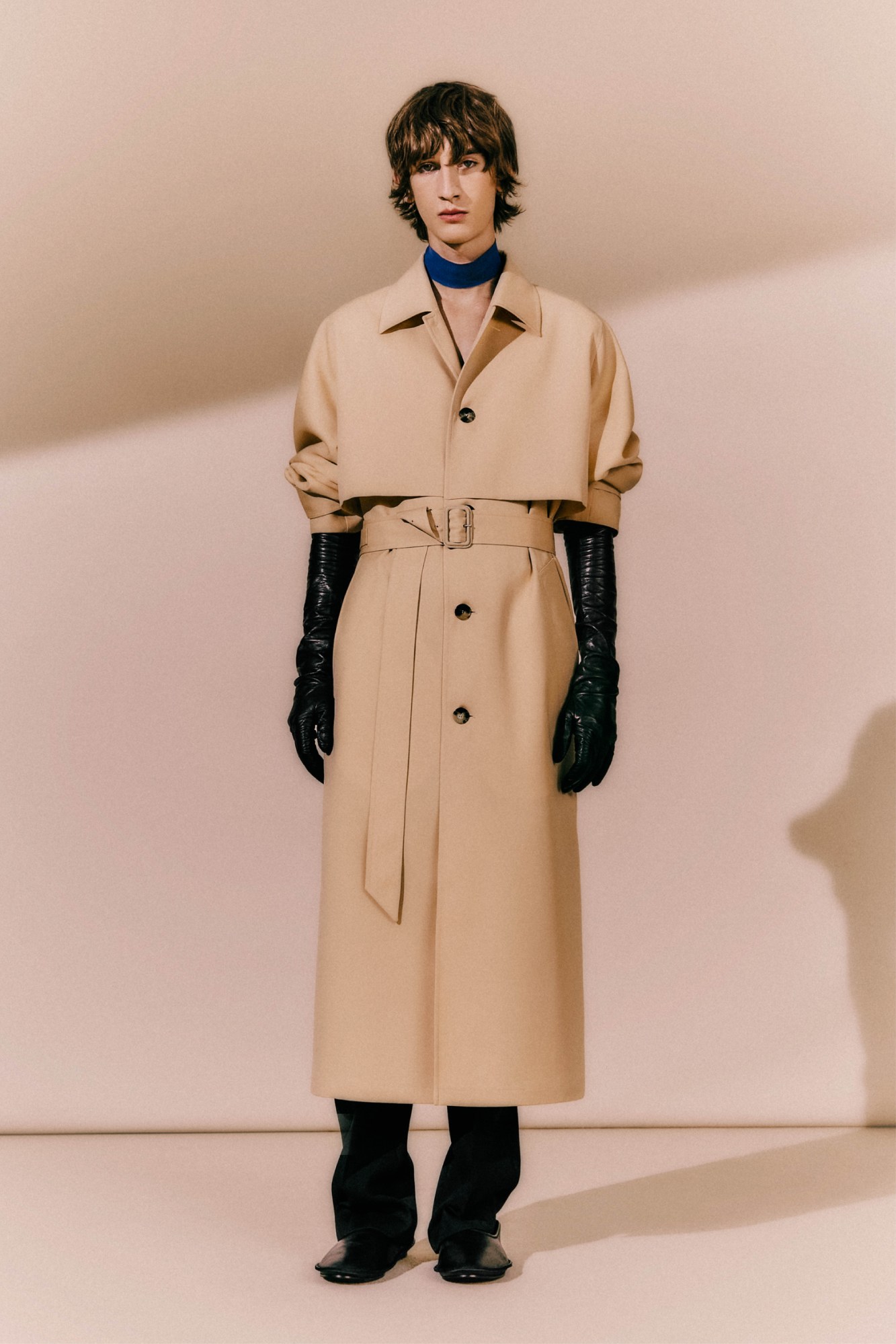
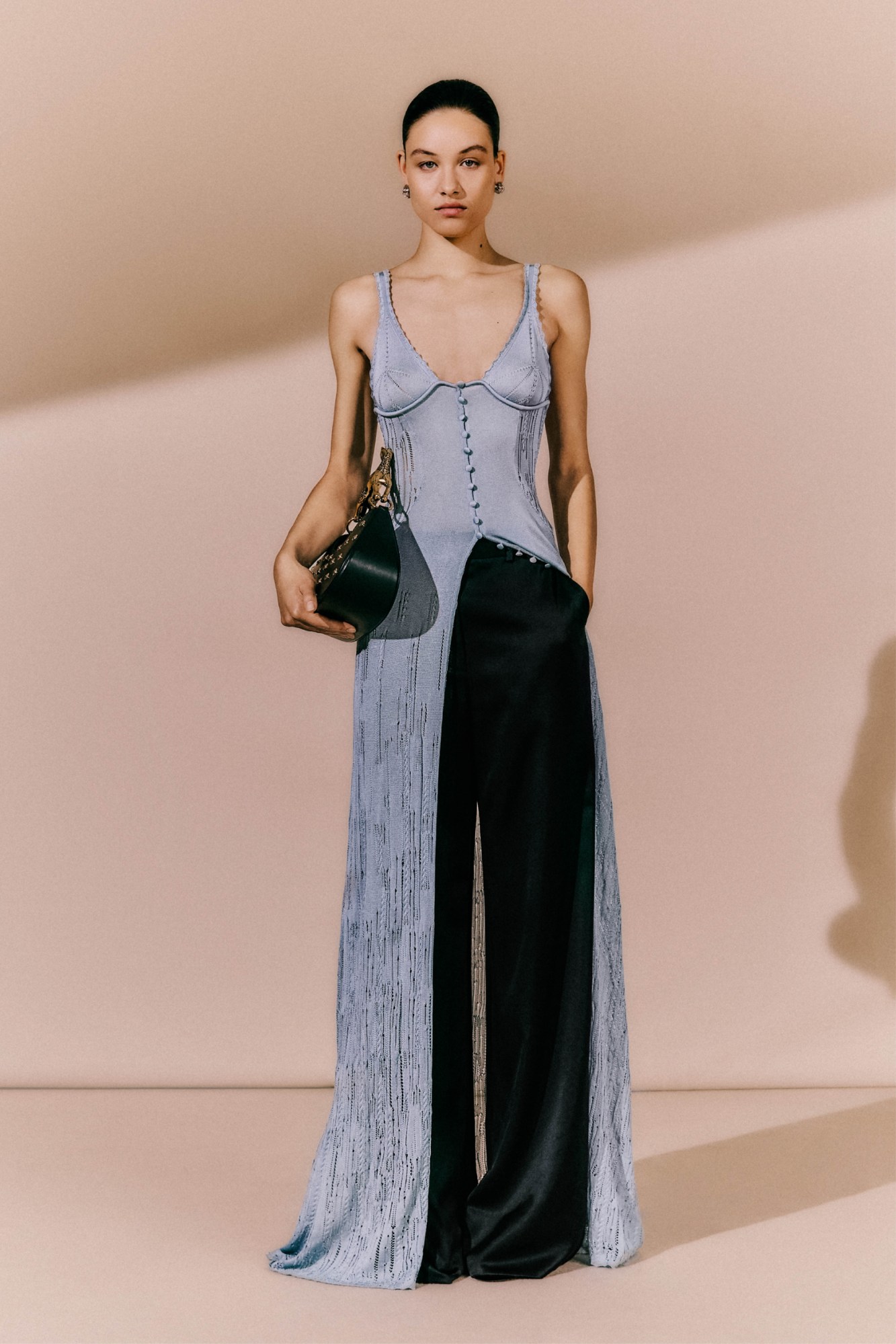

Lanvin
Lanvin is at a crossroads. Just months ago, Bruno Sialelli stepped down as creative director after four years at the helm, leaving the house in fashion purgatory. Of course, works are underway: this is the oldest fashion house in Paris, owned by the major Chinese conglomerate, Fosun. If ever there was a reason to kick things into gear, it’s a hungry stakeholder awaiting serious ROI.
As such, the maison plans to unveil a guest collection designed by rapper Future (welcome to fashion in 2023) this autumn under its Lanvin Lab division, while also sourcing a new leader to drive the mainline imminently. Until then, it’s returning to the archives, reminding its current, die-hard clientele of exactly what they love and why they love it. The glamour, darling!
And so, there, in the stately halls of Lanvin’s showroom, the brand’s studio staged a presentation of new but old designs, mining the archives in what felt less like a stock take and more an assured record of how far the brand has come.
The full bouffant skirted ‘robe de style’, first conceived by Jeanne Lanvin in the 20s before dominating high-society fashion in the 30s, played a starring role, albeit in a modernised format. Cutting off just before the ankles and dropped at the waist, the house template was decked with the protocol daisy embellishments – more is more – that defined Jeanne’s Art Deco-inflected oeuvre, but slimmed down across the hips (goodbye, panniers).
Indeed, this was demi-couture – counting up to 500 man-hours and 200 employees to make some of the gowns on show. However, costume this was not. Here, tailoring was delicately lined with wire-beading across welt pockets, moving from cropped waistcoats to folding-pleat suit pants. Elsewhere, one crystal-splashed salmon slip dress hung from the shoulders with chrome serpent bracelets, placing what was otherwise a bourgeois blast from the past firmly in the present.
Even the menswear seemed to heavily cite the label’s past – albeit, its most recent one. The boyish cuts of Bruno, and the lightly dropped shoulders of his predecessor, Alber Elbaz, were all given their dues. In this way, the evolution of historied couturier techniques born from Jeanne and channelled via Alber was charted with tact, drawing connections between a men’s and women’s Lanvin that had, until now, been hard to pin.
Besides that, the leather evening gloves, worn on both genders, harked back to that old-world glamour, kinked up for a new generation embracing high-octane opulence. Post streetwear boom of the mid-2010s, fashion’s fancy for finery could work wonders for Lanvin. Here’s hoping it sticks. For now, the Lanvin legacy hangs in the balance, but the future looks as bright and starry as ever. JB

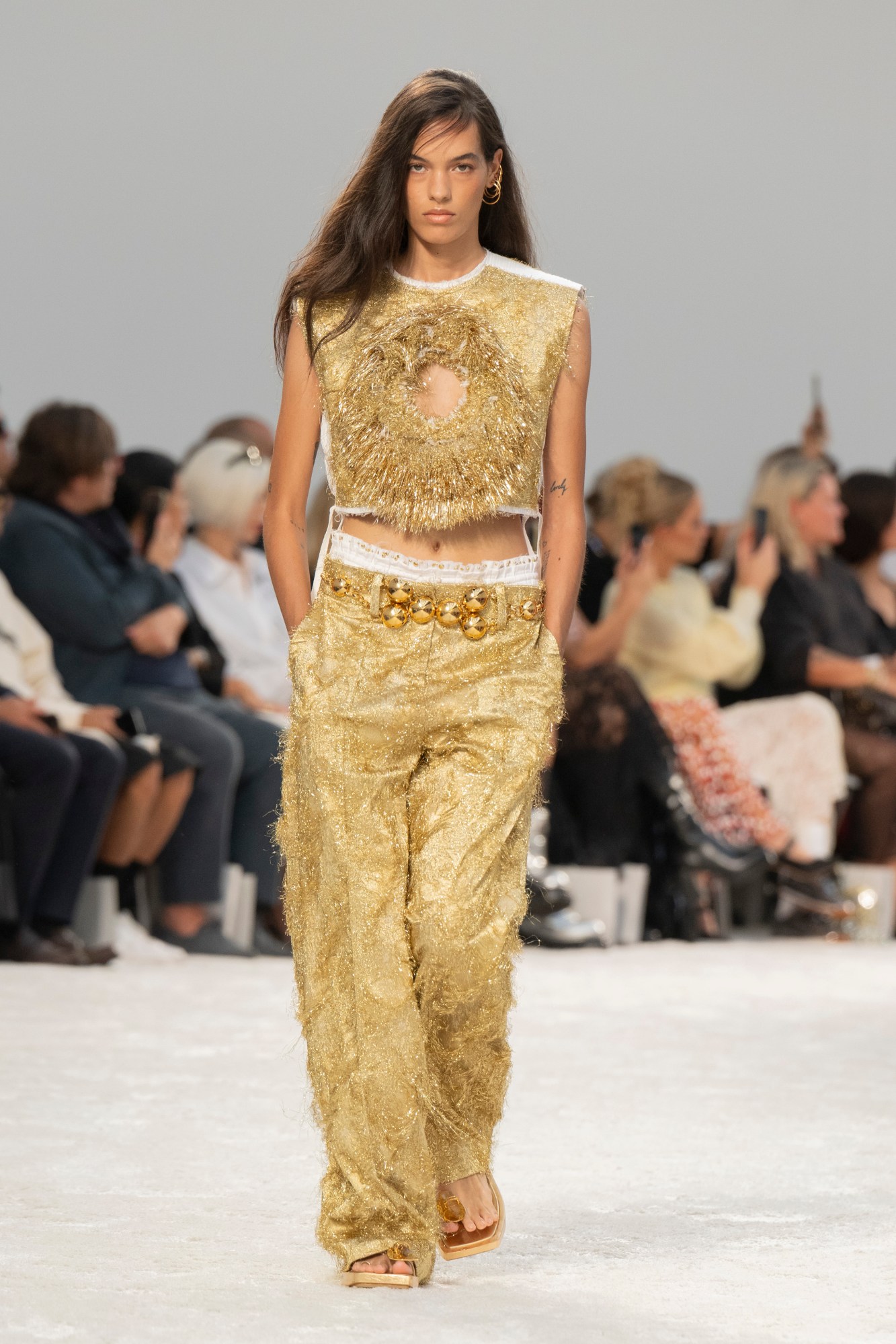

Rabanne
Ten years deep at the Rabanne label, Julien Dossena has earned his stripes as one of the purest designers in the game. A little at odds with the increasingly celebrity-laden world of fashion, his is an approach rooted in perfectionism – no doubt a lesson from his former mentor Nicolas Ghesqiuière, whom he worked under at Balenciaga during the late noughts and early teens. This season, still designing in the wake of a late Paco Rabanne, he invited guests to the plush halls of the Palais de Tokyo, lining the runway and seating area in thick meringue-hued carpet. If that sounds a little chi-chi, it’s because it was. Flashy, after all, is the lifeblood of Julien’s Rabanne.
As such, the Frenchman draped his silhouettes in regal, belly-dancer templates, letting the signature chainmail that defined the house throughout the sixties slide across bodies like molten gold. If you thought Versace’s ‘Oroton’ slips were the height of ostentatious sex appeal, think again. Here, Julien showed us his greatest asset: an ability to modernise what, until he took the helm, had been a stagnant brand resting on its laurels. Indeed, chainmail might be the house’s bread and butter, but fringed and hung across the chest like metallic shemagh scarves, it became wholly novel.
“I wanted to have that statue feeling, but in a cool, really easy way,” Julien explained backstage. “You know, like having slits in the skirts, showing skin – summer. It’s about balancing that,” he said. Certainly, that princess-level poise and form was felt, but not in a haughty, bourgeois manner, no. Rather, true to the original enfant terrible behind Rabanne and Julien’s own esoteric taste, this was about taking classicism to a new place. “What I like most is to search and explore, explore, explore, explore, and find a new way of putting things together.”
It’s true. Those shag-trimmed gowns, complete with high-shine amulet belts and macramé gladiator sandals – again, nodding to Paco with the triangulating design – summarised the shabby chic aesthetic he elevated and merged into an otherwise historied brand. As for the flocked pleated trousers, belted with ball-bearing jewels, these were another case in point, celebrating some of the once-derided techniques he pioneered on the runway. In many ways, it’s a similar story to Paco’s elevation of space-age aesthetics via plastics, metals and sliced leathers.
Of course, it’s easy to forget how hard taking on a house of this ilk would have been that fateful summer of 2013. Not only had the maison trialled two creative directors in just two years before he joined, but it was also dearly held by the people that knew it the first time around. Now, whether he cares or not, swathes of Tiktokers and Gen-Z It-kids flock to the shows, hungry for curios like those delivered today. Whether it’s the desert tailoring – knotted at the navel before caressing the buttocks – or peacock-feathered crusader suits, his work attracts new audiences, and that counts in a cut-throat industry. If that’s not your vibe, then there’s always the original, wired chest plates, this time in bronze, with make-believe v-necks outlined in chrome. So, here’s to the next decade. JB
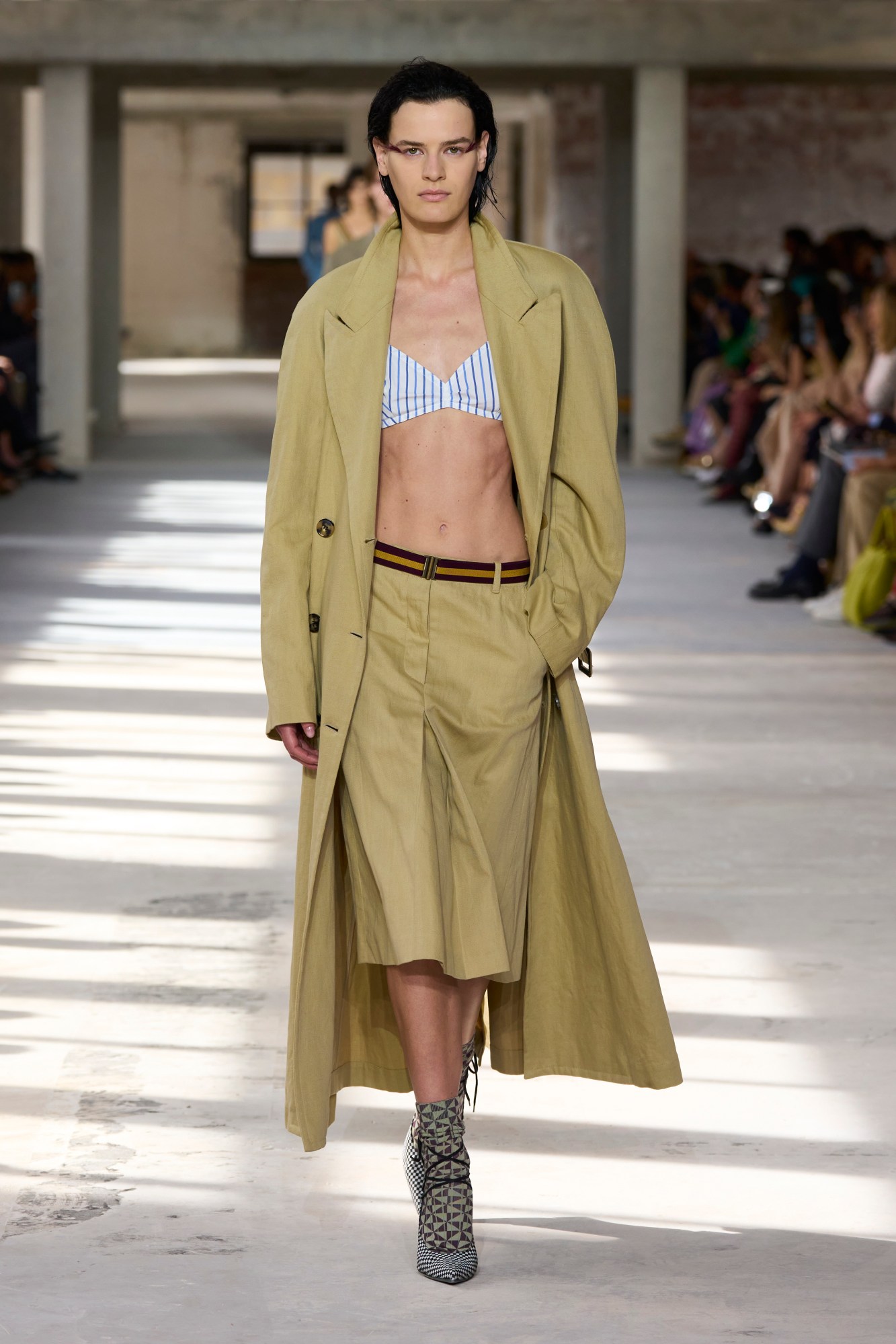

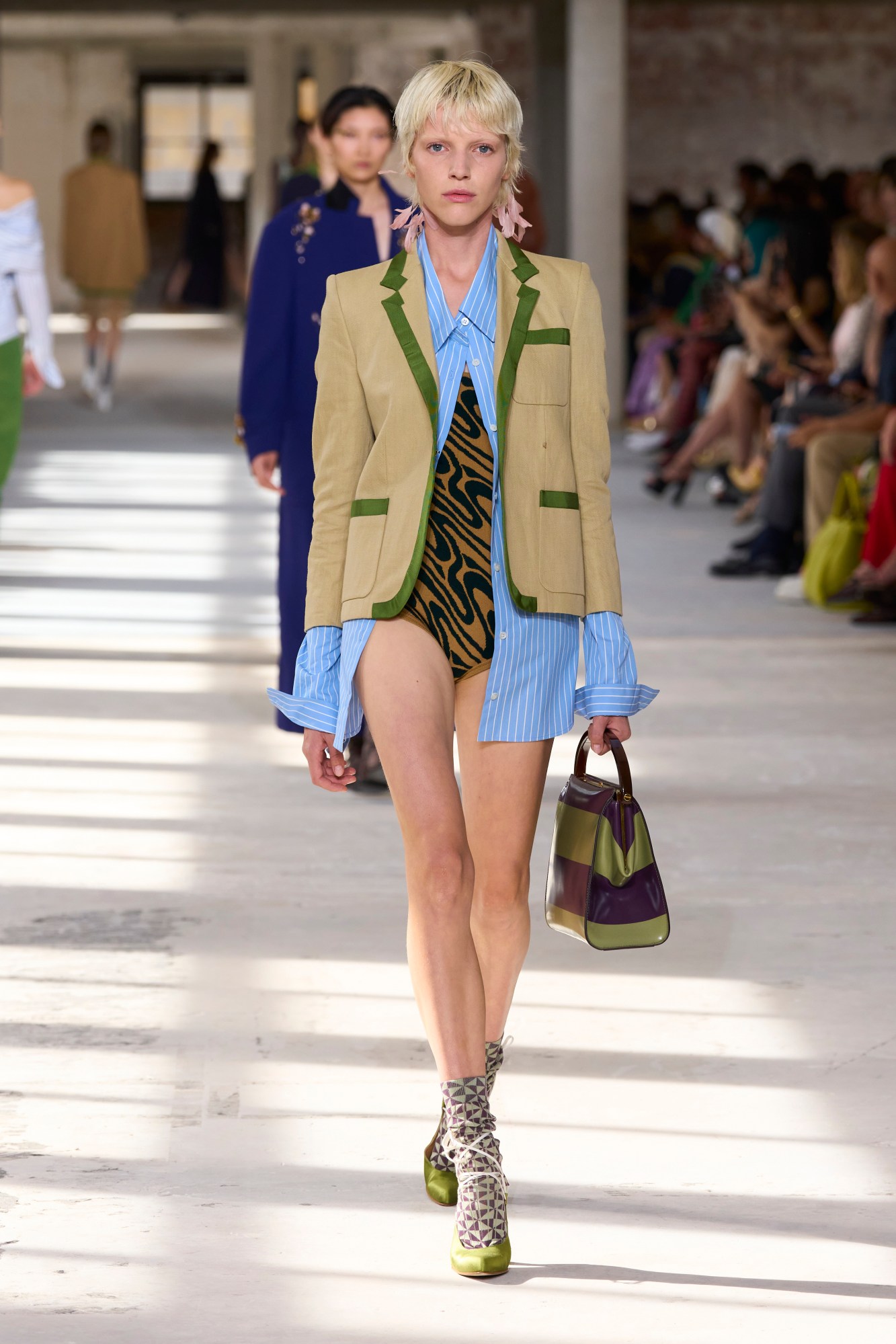
Dries Van Noten
The Dries Van Noten SS24 show opened with a khaki, cotton chino trench over a striped bralette and shorts, strung up with a rugby-striped belt. An oversized double-breasted blazer and printed hot pants followed. Then a lean, asymmetric dress shirred and striped up the front, all paired with strappy shoes and graphic socks. Titled, ‘Unfamiliar familiar’, the collection’s aim was to reimagine traditional and recognisable garments into something slightly more jarring, “spontaneous and free-thinking” by offsetting them ever so slightly.
This applied to sportswear codes – the rugby stripe, tennis scarves turned knit top, or skirt – as well as traditional men’s tailoring. For example, a staple striped Oxford shirt was reinvented as a sumptuous draped and cinched dress; elsewhere, layered over a skirt that laced up, or laced down rather, like shoelaces. A similar floor-length shirt blew up over pocketed cargo pants. Though we’re some years out of the pandemic, our penchant for casual dressing endures, and Dries’ easy silhouettes and polished formal-yet-casual-wear is an interesting proposition that might just please the working woman in all her forms, whether she’s at the office or working from home. After all, ethereal sequinned button-ups, knit vests and sheer skirts with clear jewels, or even the most gorgeous grey wool coat embellished with tiny pearls are still chic when thrown on with a rugby shirt or trackies. Here, opposites do attract. ND



Marni
“When was the last time you got lost?” was the opening line of a letter handwritten by Francesco Risso, the invitation sent to guests for his SS24 Marni show in Paris, the final stop in a travelling trilogy of shows, preceded by stops in New York and Tokyo. As we arrived at the grand private apartments and the formal gardens of Hôtel de Soyecourt, the hôtel particulier famously owned by Karl Lagerfeld, we were invited to get lost through the gilded salons and the Baroque-style hedge mazes that provided a backdrop to the bouncy, air-filled tubes that formed the labyrinthine seating for the show. Sunshine poured in through the tall windows, making the salons showpieces in and of themselves, dioramas in which you could stumble across Erykah Badu in a towering knitted top hat, and in another room, an orchestra of white-clad musicians playing to a score composed by a Dev Hynes. As the show started, more than a few models got lost in the rhizomatic runway, which only added to the Wonderland atmosphere that we’ve come to expect chez Marni.
It also set the scene for Francesco’s take on Parisian fashion, and all the savoir-faire usually associated with its most famous export: haute couture. Except, there was none of the stereotypes à la parisienne to be found, instead a peek into the swirling imagination of the designer and his motley crew of creative collaborators. The show opened with easy, athletic ribbed tube tops in various lengths, palette-cleansing showcases of the body as a blank canvas. Then came the the checked tailoring, coats and jacquards and patchworks in Marni’s signature kaleidoscopic palette, every colour of the rainbow in psychedelic harmony. And finally, the show closed with sequences of dresses made from floral découpage which Francesco described as channelling “the ecstasy of the hand.” Hundreds of bright-coloured images of flowers, each one sourced from antique botanical almanacs, were printed on cotton, cut by hand, and then stitched together onto crinoline skirts, mini dresses and a skirt suit with exaggerated shoulders.
Just when you’d thought you’d reach the zenith of Francesco’s imagination, out came minidresses with flowers dancing around the body en tremblant from long stems, entirely crafted from discarded tin cans — a reaffirmation of the upcycling that Francesco ushered into the Marni ateliers all those years ago. These were clothes that he described as “a quest for joy”. Sure, they won’t make it to the shop floor, but they served to create a fantastical display of artistry — one that feels like a rebellious riposte to the widespread 90s-tinged minimalism (which often just means commercialism) of so many collections we’ve seen this month. OA
The Row
Review to come.
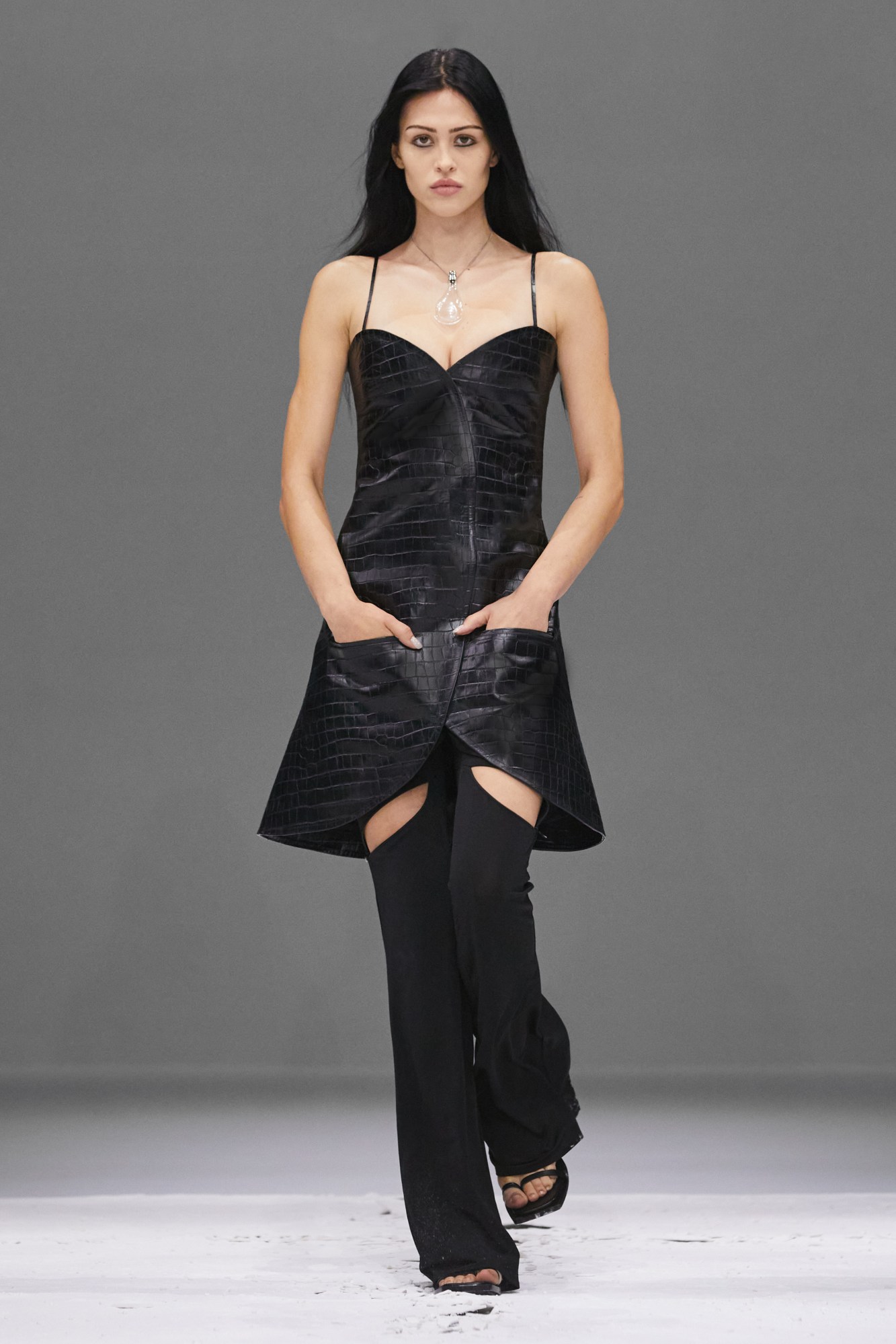
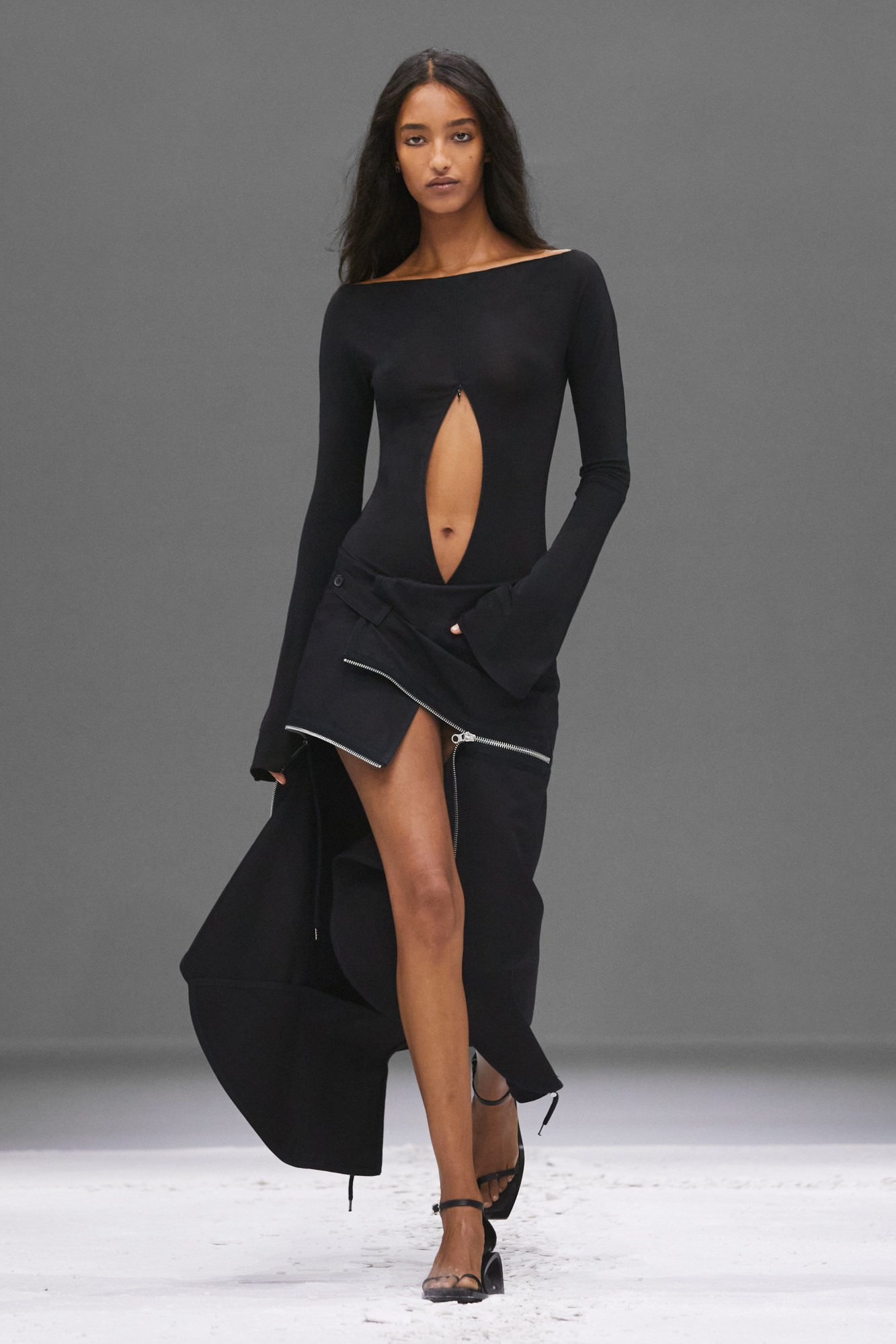
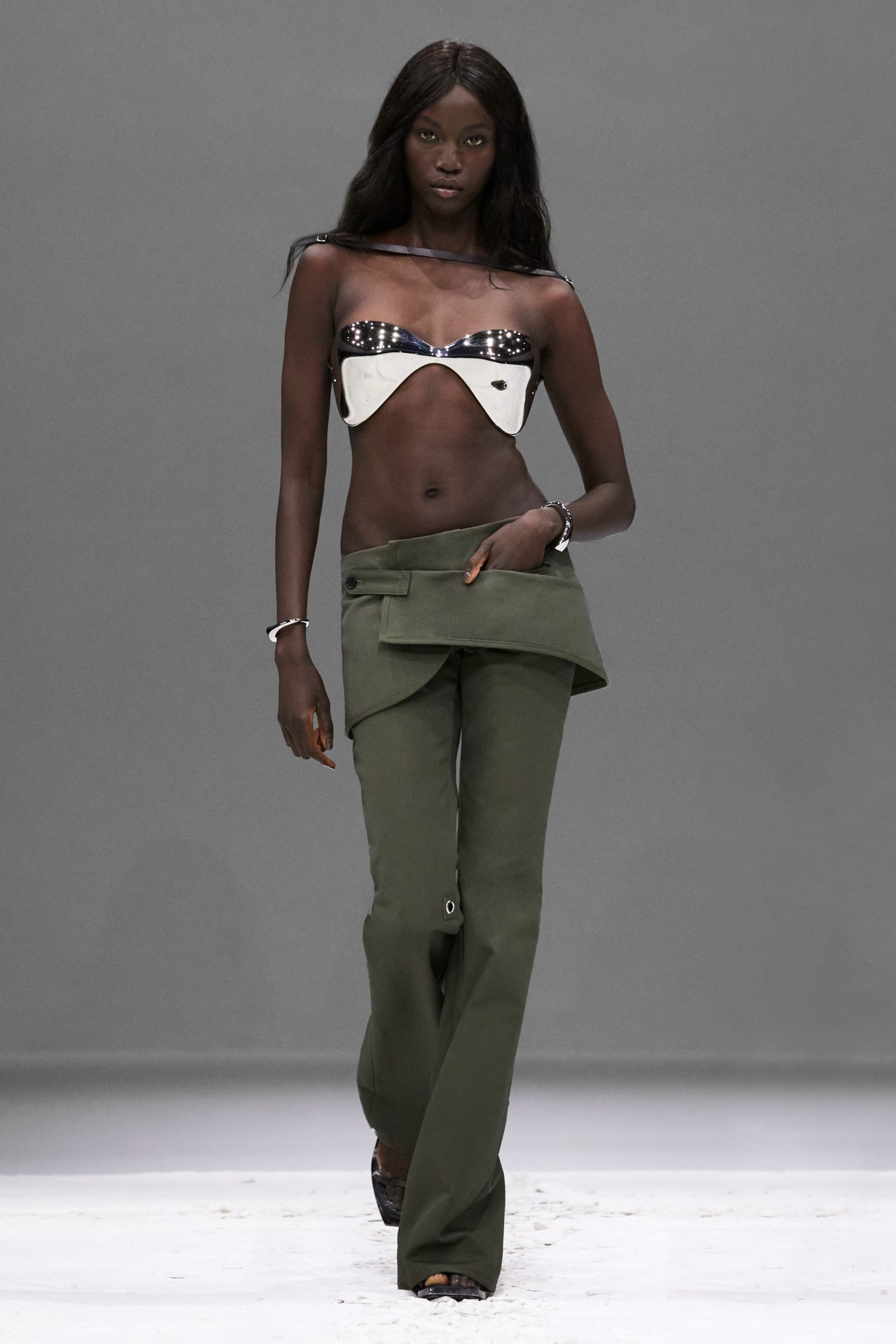
Courrèges
Ahead of the Courrèges SS24 show, guests were sent square invitations that appeared to be covered in textured white paint; shattering them revealed the show’s location in Paris 15e – a white, cylindrical warehouse marked with the Courrèges logo above the door. Inside, the space was washed entirely in white and the floor covered in the same sandy plaster which, as the groundbreaking show began, cracked into tiny, little pieces with each model’s step.
Entitled, ‘The Miseducation of Courrèges’, the offering saw creative director Nicolas Di Felice flip the house’s signature 60s and 70s Space Age-inflected silhouette on its head – a series of slouchy shirt dresses twisted around the body to be split up the side, the shoulders of button ups were constructed to roll over the shoulder and croc embossed skirts wrapped around the waist atop matching, spliced low-rise flares that together created a leather-like armour. As seen on a convincing cast of “female pioneers”, including Amelia Gray, Mona Tougaard and Anok Yai, who appeared in a curved silver breastplate and army green skirted trousers, the designer’s fluid, explorations and experimentations in shape were meant to channel the elements, “question notions of authority and norm” and signal “the advent of newfound beliefs”, according to the show notes. “Their first steps on virgin land shatter the moon-like surface, carving a fissured road that chronicles each passing stride.” Outfitted in Nicolas De Felice’s sexy buckled leathers, cape-like dresses and even a hoodie tunic, which dips to the belly button, the modern day Courrèges woman is ready to, quite literally, walk on the moon. ND
Saint Laurent
Last night, as the peach-coloured skyline of Paris darkened into nightfall, Saint Laurentopened the doors to its latest installation at the foot of the Eiffel Tower. This time, an entirely marble set, somehow with entirely symmetrical veins, complete with an Art Deco swimming pool. The setting was prescient. Marble is merely a simple raw material that can be transformed into something grand, after all – as Michelangelo famously said about his David: he was there, I just carved away to set him free. Simple yet spectacular, not unlike Anthony Vaccarello’s collection of utility-inspired ‘workwear’, an almost entirely cotton collection marking a newfound sense of ease for the notoriously slick Saint Laurent woman. Read our full review here. OA
Dior
What do Maria Grazia Chiuri and Rei Kawakubo have in common? If Dior’s latest collection was anything to go by, more than meets the eye. The French house is famously a symbol of floral femininity, a beacon of wasp-waisted tidiness and polite clothes that follow the exaggerated lines of the female form. These days, it is not a fashion house that customers flock to for radical or rebellious fashion. Yet, Maria Grazia Chiuri’s latest collection had more in common with the rebellious Japanese designers that arrived in Paris in the 80s and introduced radically worn-and-torn clothes to the canon of fashion history. Yesterday saw a Dior show brimming with distressed knits, ostensibly moth-eaten Bar jackets, singed ivory dresses, frayed hems, jauntily strewn shirts, and panels of chiffon floating like embers of a flame — all of which suggested a woman emerging from the ashes of ruin, which brings us to witches. Read our full review here. OA
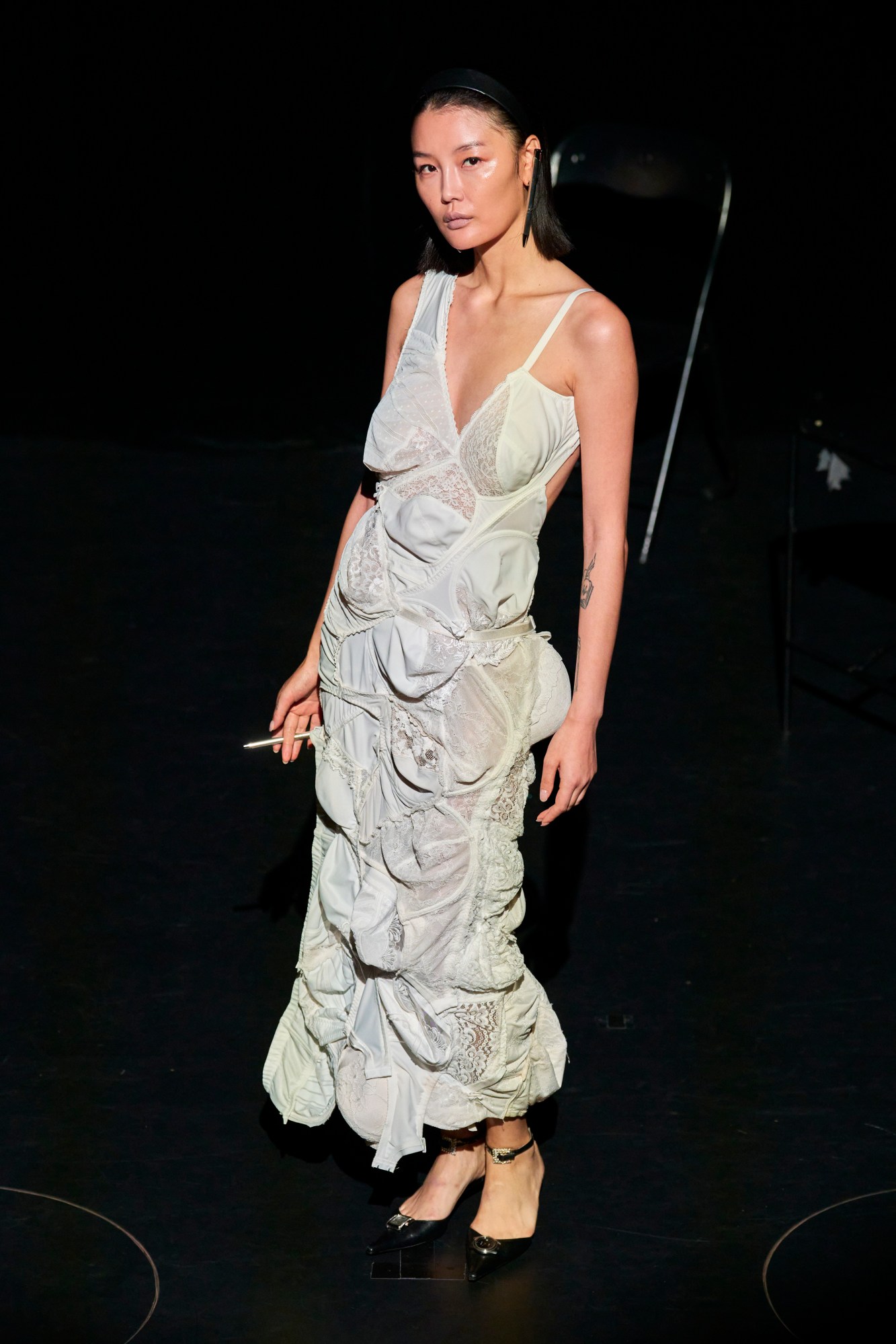
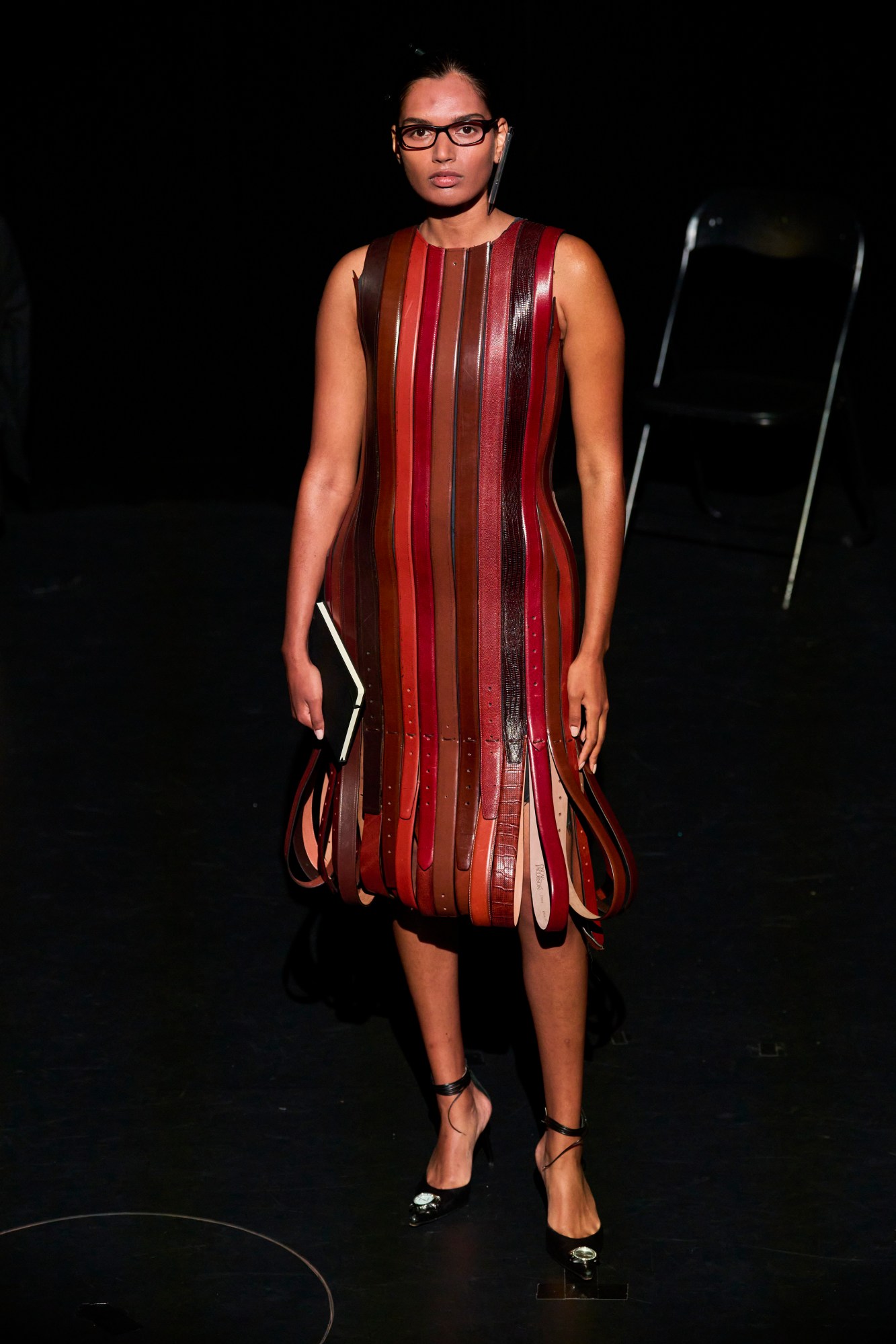
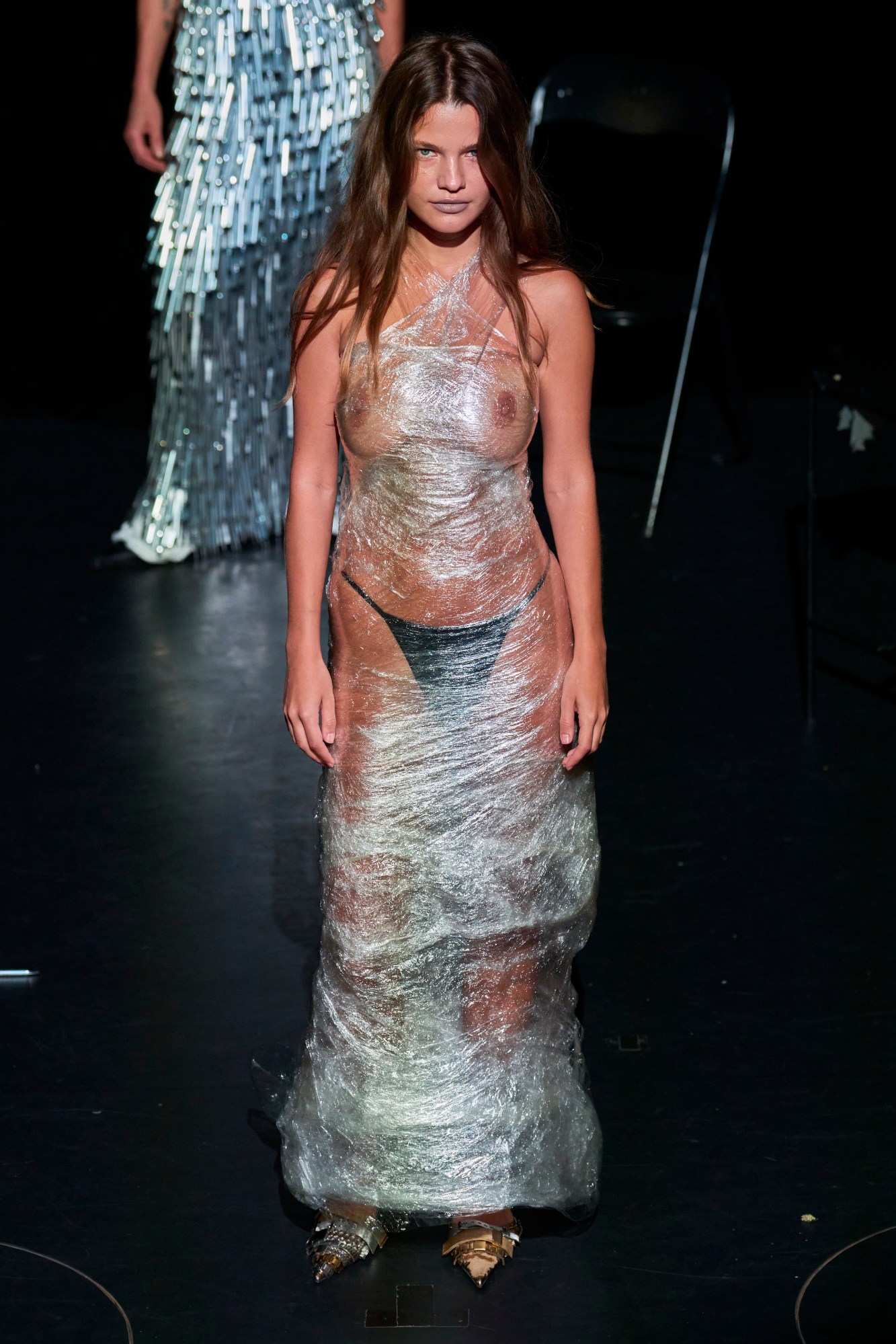
Hodakova
On Tuesday, Ellen Hodakova Larsson presented her SS24 collection entitled ‘The Perfect Show’ at the Théâtre de la Tour Eiffel, where the red velvet curtain swung open to reveal a performance of a Pina Bausch’s Seasons March, reinterpreted by NYC-based choreographer Sharleen Chidiac. As the performers circled the stage, models walked up one by one in Hodakova’s signature upcycled creations – a ruched dress made from deadstock white lace bras or some 20 or so stacked trouser waistbands; a gown covered in wildflowers picked in the Swedish countryside – each piece meant to exist “in-between the permanent and the ephemeral, the eternal and the transient.”
The collection explores identity and self-expression in an ever-evolving world, and specifically, a digital one that often centres and rewards perfection. However, Ellen has a better idea: “The Hodakova form isn’t about achieving an ideal,” she wrote in the show notes, “but rather about embracing imperfections until they become uniquely your own.”
This identity struggle comes through in the show, which was designed to feel like a simulated office environment. Bespectacled models compete for attention in their fascinating frocks, including a handful of silhouettes made from leather belts and a silver gown fastened from nearly 2000 pens. They were also dangled from earrings or used to accentuate the hair. All eyes were on Hodakova, here. ND

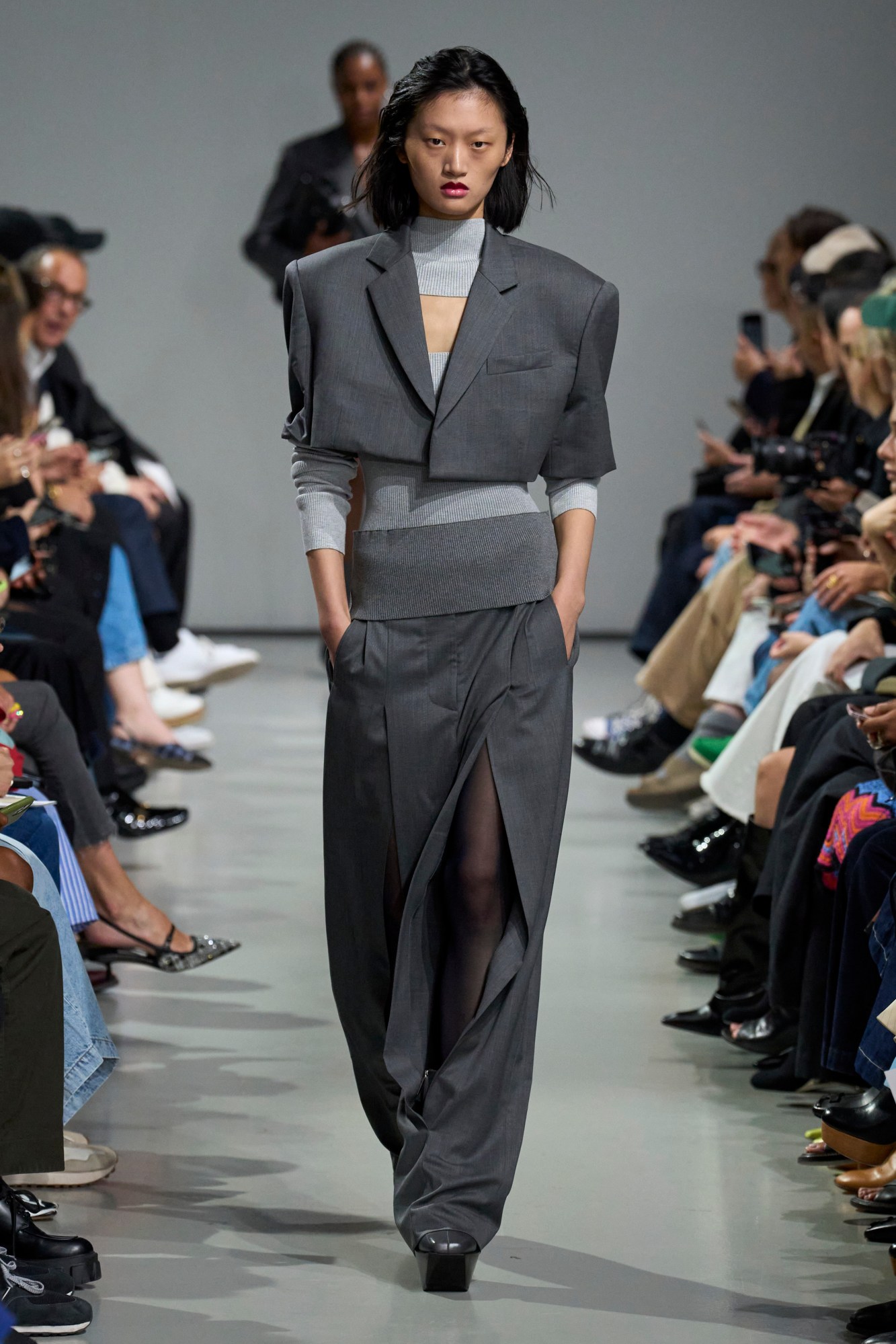
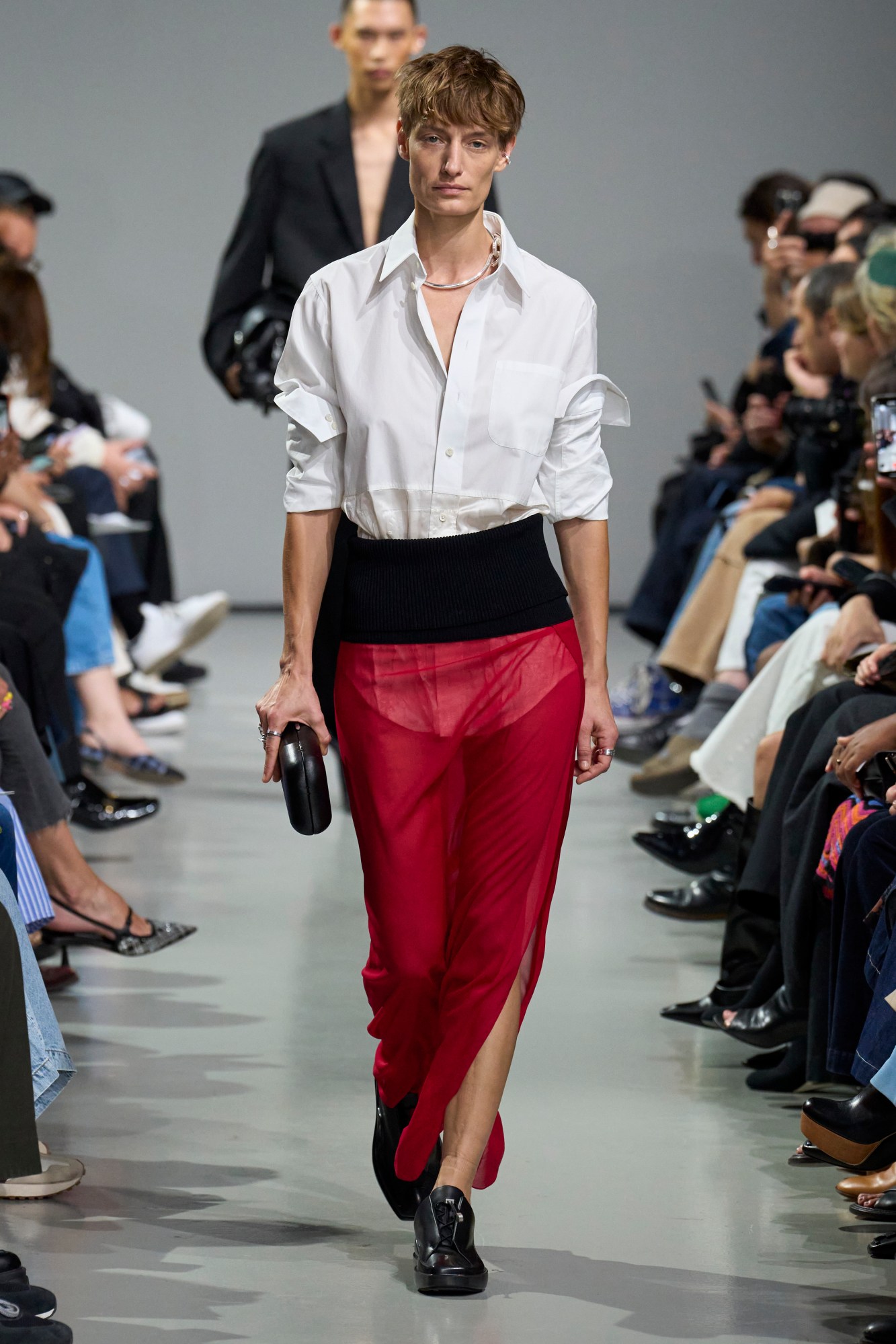
Peter Do
When Peter Do brought his namesake label to Paris for the first time, six years ago, he turned up with suitcases full of clothes and not a single sales appointment scheduled. “I was a kid. I was 26. I felt so naive,” he says. “[But] we had a dream.” This season, as Peter returned to stage his first Peter Do show in the fashion capital, a little older, wiser and fresh off his Helmut Lang debut in New York, there was one thing on the designer’s mind: “I want to make grown-up clothes,” he said backstage.
And Paris is a natural fit for the PD sensibility, especially all grown up in all its luxury tailoring — wide-leg trousers were given a casual twist for SS24, with raw hems, sans waistband; colour-blocked silk button-ups with wide cuffs; pieced suede and leather tops and dresses, done in stark black and white. There were a series of cutout trousers, chiffon layers peaking through, and matching tops that revealed a sliver of obscured skin, which served as a nice counterbalance to the super-cinched, elegant suiting. The highlight, however, was when each model twirled down the runway — every ten steps or so — when overlapping, pleated layers had their time to shine.
It has been a busy few months, for Peter and his team, to say the least. “It’s a really emotional time for the team as well, because we really started with nothing, together,” he says. As such, the designer kept the show notes brief: “This season, we want our work to speak for itself.” That it did. ND
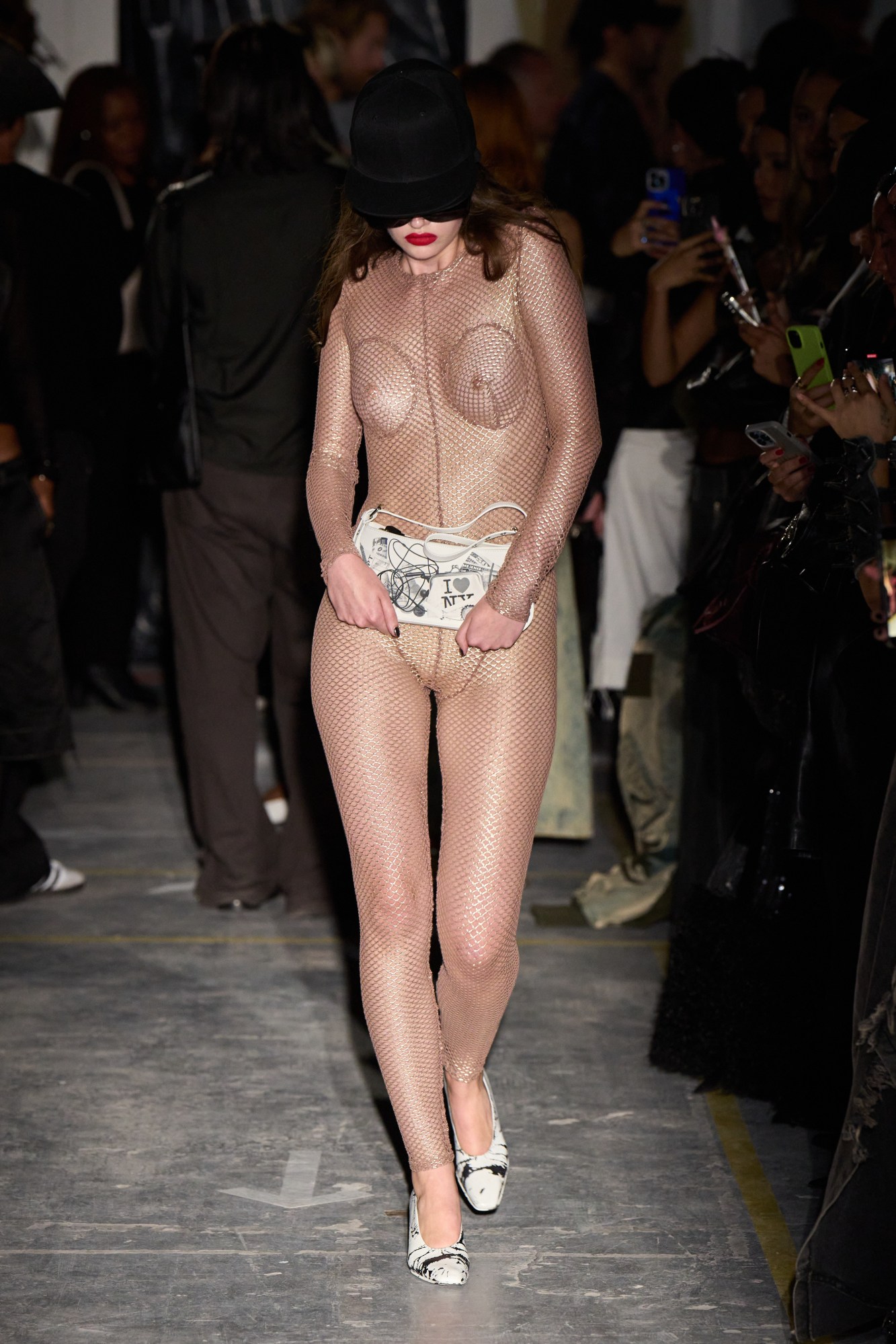
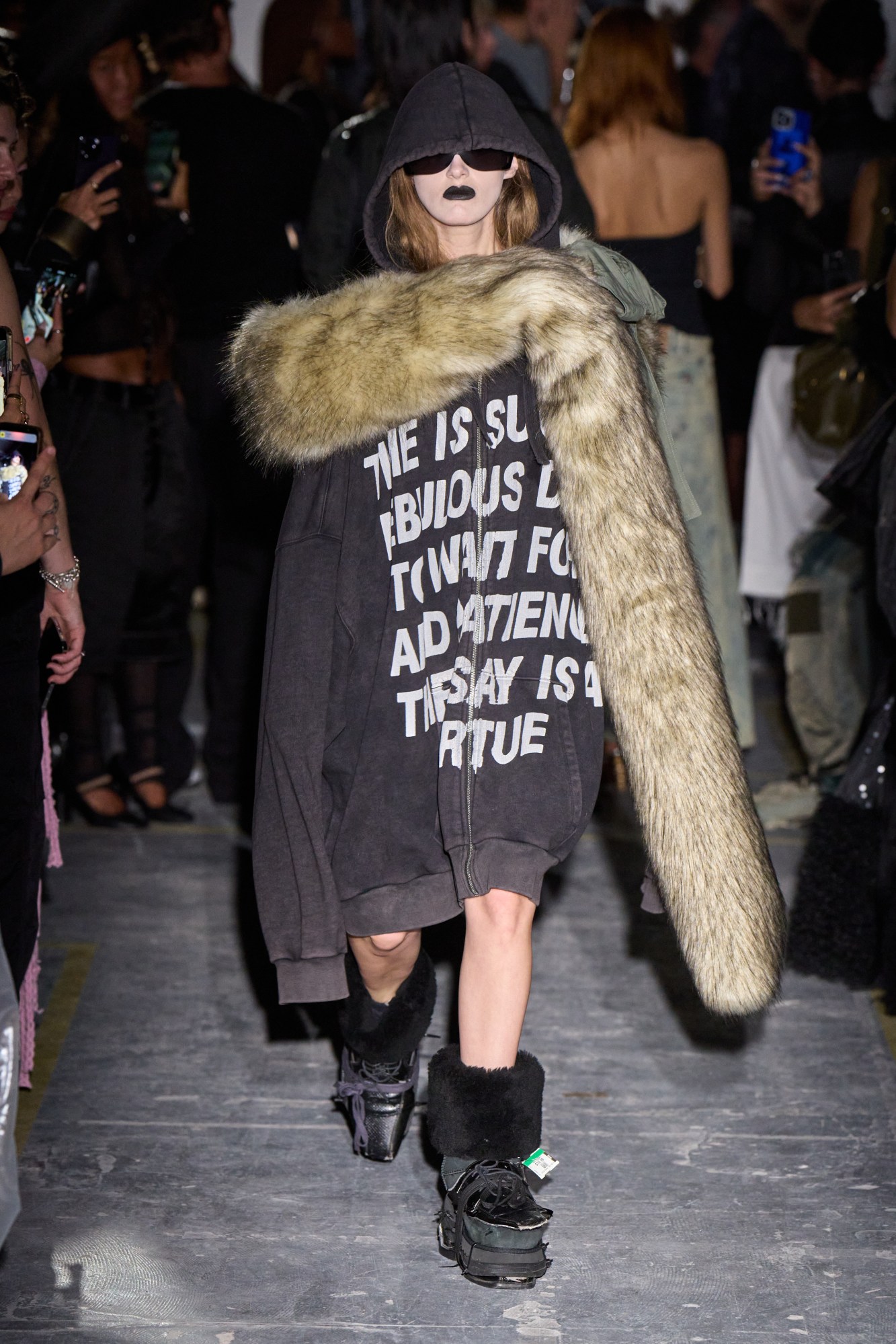
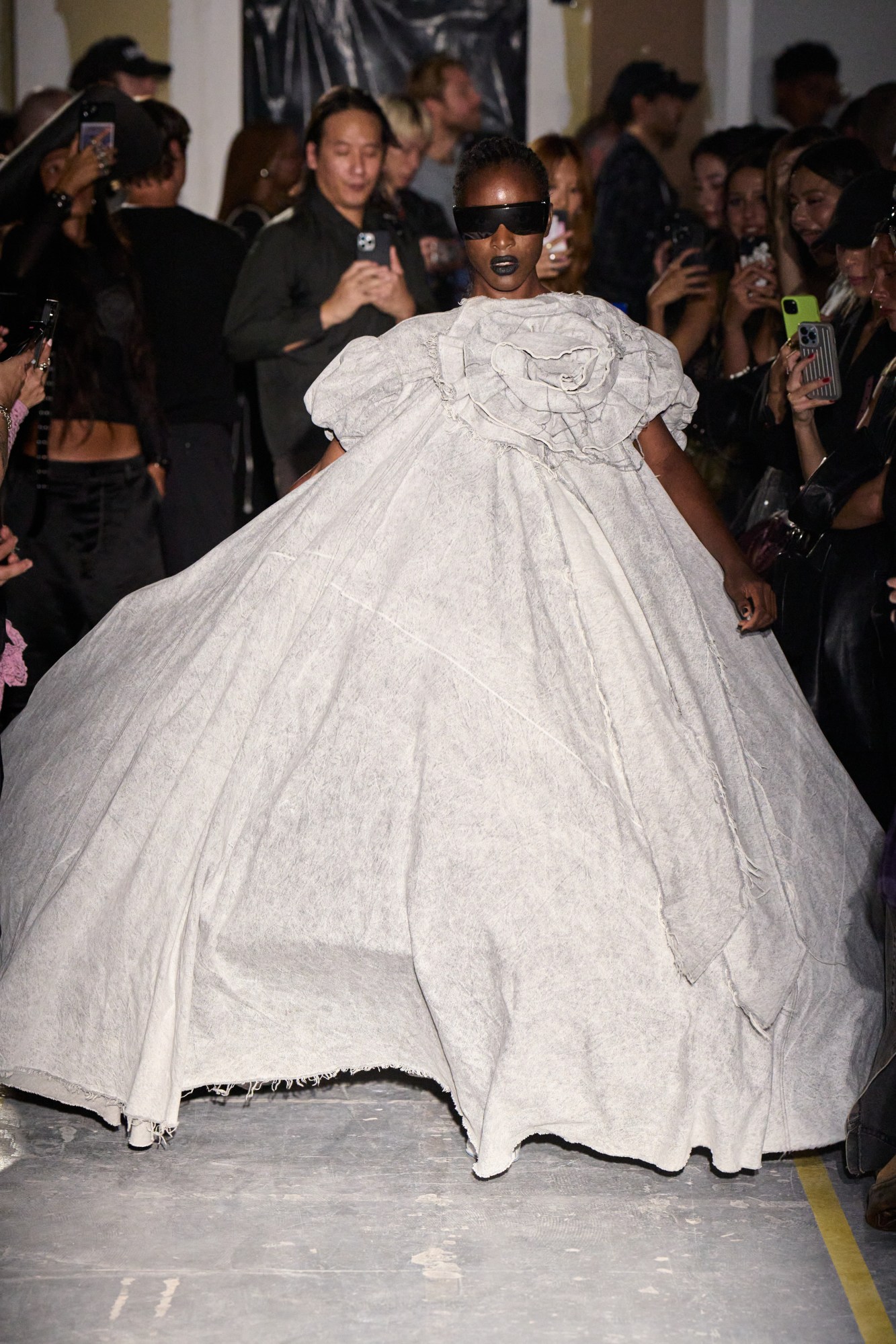
Vaquera
Vaquera might be showing in Paris now, but Patric DiCaprio and Bryn Taubensee’s latest collection remains rooted in New York City, the legendary metropolis that raised them and their beloved, cult brand in the 2010s. The model that opened their SS24 show in the Marais last night, dressed in a sheer, metallic fishnet catsuit with cheeky seamed details, oversized blackout sunglasses and giant black baseball cap, carried a trompe l’oeil purse printed, x-ray style, with an ID, wads of cash, wired headphones and an ‘I <3 New York’ coin purse on its surface. She held it over her more intimate exposed areas and looked down at the floor as she walked, as if purposely avoiding the barrage of iPhones held up by rows of editors standing in the strobe-lit space.
The designers said backstage that they were thinking a lot about disguise this season – “how wearing clothes can change people’s perspective of you” – “It’s very basic, but… why are we doing this? What do we care about in fashion? And what makes fashion powerful?” Patric asked. But they were also thinking about celebrity culture, both in the 00s and 10s – the golden era of paparazzi photography – and today, where we’re often documenting ourselves with our own cameras, often in our homes, for Instagram. The collection considers “whether you want to be really apparent to people, or disguise yourself and not be seen,” Brynn adds.
This came through in buttoned-up, business-in-the-front trompe l’oeil trench coats with revealing cut outs at the back, and graphic T-shirts and golden tanks with cut out circles around the bust, some with an open bodysuit layered atop. There were camo prints, ruffled dresses and convertible denims, allowing the wearer to control the level of skin they’re showing off, and their signature exposed lingerie prints. Though, this time, there were loads of actual exposed undergarments as well, under open-knit cardigans, tailored, heavy-shouldered blazers and buckled chaps.
The designers kept coming back to the idea of transforming yourself through clothes, and how fashion can shift perspective. For Vaquera, that might have started off with very oversized silhouettes in the early years – those were still there, particularly, in one giant trailing button-up dress and floor-length tie, and a frayed, rosette ballgown that just about fit down the runway – but in reflecting the opposite of being dressed in disguise, Vaquera’s SS24 offering was shrunken, mini in its cropped track jackets and painted bombers; logo knit boleros over satin bullet bustiers, all topped off with a ‘COMME des FUCKDOWN’ hat. You can take the girls out of New York City, but you can’t… you know. ND

